Show HN Today: Discover the Latest Innovative Projects from the Developer Community
 ShowHN Today
ShowHN TodayShow HN Today: Top Developer Projects Showcase for 2025-07-20
SagaSu777 2025-07-21
Explore the hottest developer projects on Show HN for 2025-07-20. Dive into innovative tech, AI applications, and exciting new inventions!
Summary of Today’s Content
Trend Insights
Today's Show HN projects showcase a vibrant landscape of innovation, with AI taking center stage. Developers are actively building tools to automate tasks, enhance workflows, and redefine content creation. The prevalence of open-source projects underscores a collaborative spirit. For developers, this means opportunities to contribute, learn, and build upon existing solutions. Entrepreneurs should take note of the growing demand for privacy-focused and user-friendly tools, as well as the potential of AI to disrupt various industries. The focus on streamlining development and improving user experience provides fertile ground for innovation. Consider combining these trends to build solutions that are both powerful and accessible, providing real value while protecting users' privacy and data.
Today's Hottest Product
Name
Show HN: MCP server for Blender that builds 3D scenes via natural language
Highlight
This project uses the Model Context Protocol (MCP) server to connect Blender to Large Language Models (LLMs) like ChatGPT and Claude. The core innovation is enabling users to create and manipulate 3D scenes within Blender using natural language commands. You can describe complex scenes, like a village with specific elements and spatial relationships, and the system will build it for you. This approach simplifies 3D modeling by abstracting away the technical complexities and leveraging the power of AI to interpret and execute user instructions. Developers can learn how to integrate LLMs with 3D software, creating new possibilities for content creation and design workflows.
Popular Category
AI/LLM
Game Development
eCommerce
Productivity Tools
Developer Tools
Finance
Popular Keyword
AI
LLM
Open Source
CLI
Privacy
Automation
Technology Trends
AI-powered content creation and automation: Several projects leverage AI to automate tasks like 3D scene generation, product image creation, and code generation, demonstrating the growing influence of AI in various domains.
Local and privacy-focused solutions: There's a notable trend toward tools that prioritize user privacy and data security, with projects like Tygra, which processes documents locally, and NetXDP, which focuses on kernel-level DDoS protection, highlighting the importance of these aspects.
Simplified development workflows and user experiences: Tools like Mirage and Gix aim to streamline developer workflows and enhance productivity, showcasing the ongoing demand for developer-centric solutions.
Open-source and community-driven projects: Many projects are open-source, demonstrating a collaborative spirit and a commitment to accessible technology. Projects like Emporium and the Open LLM Specification are good examples.
Project Category Distribution
AI/LLM Applications (35%)
Developer Tools and Productivity (30%)
eCommerce and Content Creation (15%)
Security and Privacy (10%)
Other (10%)
Today's Hot Product List
| Ranking | Product Name | Likes | Comments |
|---|---|---|---|
| 1 | PeerMap Widget: Visualizing Network Peer Locations on X11 | 152 | 61 |
| 2 | Blender-MCP: Natural Language 3D Scene Generation | 148 | 61 |
| 3 | XID: Globally Unique ID Generator | 7 | 3 |
| 4 | LegalDocGraph: Hybrid RAG System for Legal Documents | 7 | 3 |
| 5 | FlouState: Intelligent Coding Activity Tracker | 9 | 0 |
| 6 | Sifaka: LLM Reliability Enhancement Framework | 7 | 0 |
| 7 | Chatterblez: Real-time Audiobook Generation with Nvidia Acceleration | 4 | 2 |
| 8 | Superpowers: AI-Powered Chrome Extension for Enhanced Web Browsing | 6 | 0 |
| 9 | MediaManager: A Modern Metadata-Driven Media Orchestrator | 5 | 0 |
| 10 | ChatForm AI: Conversational Form & Calculation Engine | 3 | 2 |
1
PeerMap Widget: Visualizing Network Peer Locations on X11
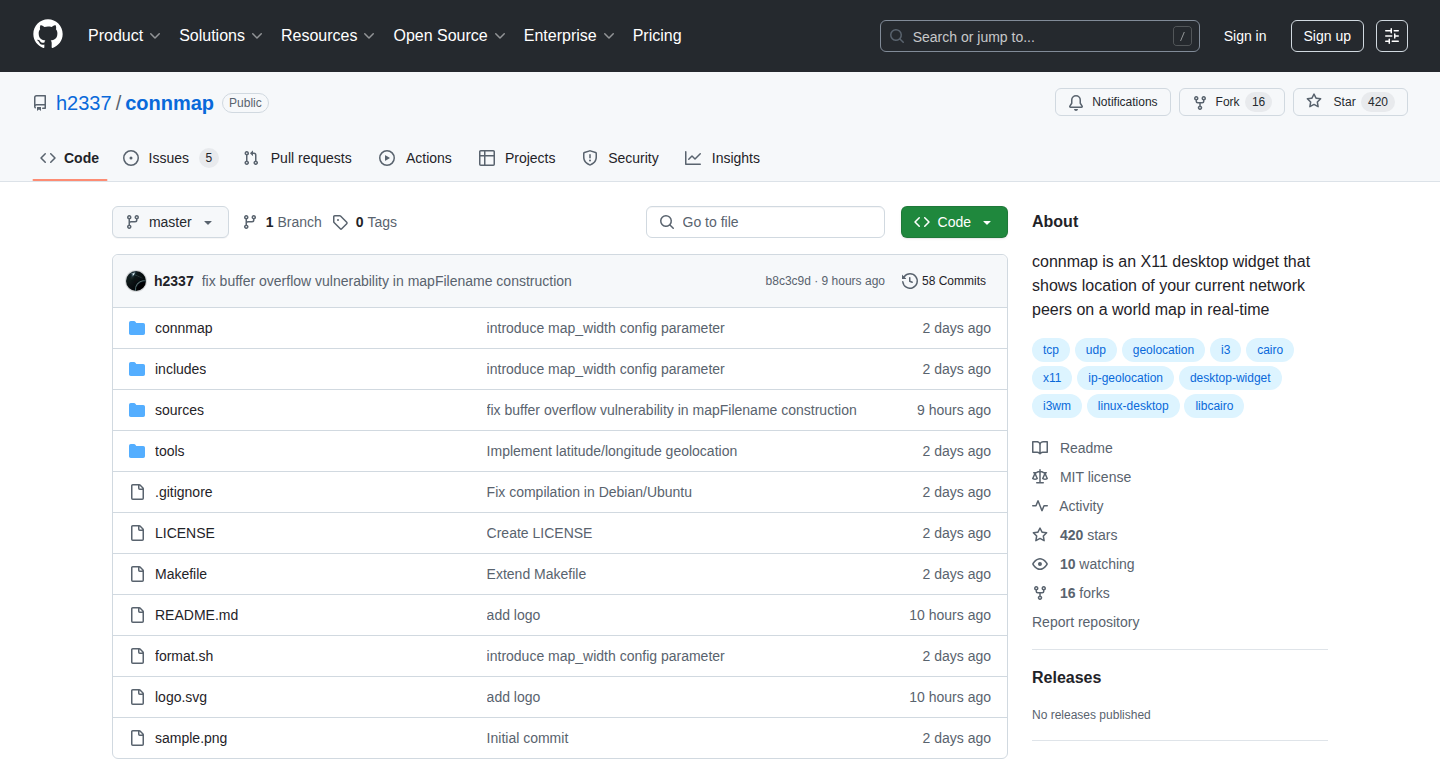
Author
h2337
Description
This project creates a desktop widget for X11 systems that displays the geographical locations of your network peers on a map. It leverages the power of network monitoring and geolocation to visually represent where your network connections are located. This offers a unique way to understand your network's reach and activity, solving the problem of invisible network connections and providing a visual context for network traffic. Essentially, it translates complex network data into an easily understandable visual format.
Popularity
Points 152
Comments 61
What is this product?
This is a desktop widget that shows the locations of devices connected to your network on a map. It works by analyzing network traffic to identify connected devices (peers) and then uses their IP addresses to determine their approximate geographical locations. The widget then displays these locations on a map, allowing you to visually track your network's activity. The innovative part lies in its combination of network monitoring, geolocation lookup (using IP addresses), and real-time visualization within a lightweight desktop widget. So, it's like a live map of your network connections, showing you where your network is reaching.
How to use it?
Developers can use this widget on X11 based systems, such as Linux distributions. They can install it and then configure it to monitor specific network interfaces or listen for certain types of network traffic. The widget automatically updates the map as new peers connect or disconnect. You could integrate this widget into a network monitoring dashboard, use it for security analysis to visualize unusual network connections, or simply use it as a fun tool to understand your network's structure and activity. So, you can directly install it on your Linux system to understand where your network devices are located.
Product Core Function
· Network Traffic Analysis: The widget monitors network traffic to identify connected devices and their IP addresses. This functionality allows it to gather data about the network devices that are currently communicating with your system. This is useful to analyze the network traffic of your system.
· IP Geolocation Lookup: It uses IP addresses to determine the approximate geographical locations of network peers. The widget then uses a geolocation API, such as MaxMind, to convert IP addresses into approximate geographic coordinates (latitude and longitude). This helps to show the general location of the network devices on a map.
· Map Visualization: The widget displays peer locations on a map within a desktop window, providing a visual representation of network connections. This is achieved using a mapping library to render the map and place markers at the determined geographic coordinates. This gives users a real-time understanding of their network's geographic distribution.
· X11 Integration: It is designed as a desktop widget for X11 systems. This allows it to integrate directly into the user's desktop environment, providing a seamless and accessible network visualization experience. This makes it convenient for users to track their network activity at a glance.
Product Usage Case
· Network Security Monitoring: Developers can use the widget to identify and visualize unusual network connections. By seeing where connections are coming from, they can quickly spot suspicious activity and potential security threats. So, it will help you to identify suspicious activity on your network by showing the location of the connections.
· Network Troubleshooting: The widget can help troubleshoot network connectivity issues by showing the location of remote servers or devices. By visually identifying where the problem might be originating, developers can narrow down the scope of the issue and focus their troubleshooting efforts. So, it can help you to quickly troubleshoot network connectivity issues.
· Network Infrastructure Planning: In some cases, developers could use the widget to visualize the geographic distribution of a network. For example, they can use it to plan where to place new servers or network devices to optimize performance. So, it provides developers with a visual understanding of their network's global distribution.
· Educational Tool: The widget provides an excellent educational tool for understanding network behavior and the geographical distribution of network traffic. It can be used to illustrate network concepts in a visual and interactive manner. So, it is a great tool to understand and visualize the network traffic.
2
Blender-MCP: Natural Language 3D Scene Generation

Author
prono
Description
This project introduces a custom Model Context Protocol (MCP) server that bridges Blender, a popular 3D modeling software, with Large Language Models (LLMs) like ChatGPT and Claude. It allows users to create and manipulate 3D scenes using simple, natural language descriptions. Instead of manually modeling or scripting, users can describe a scene (e.g., "Create a small village with huts") and the system intelligently interprets the instructions and builds the scene within Blender. The core innovation lies in the translation of natural language into 3D modeling instructions, enabling AI-driven 3D scene creation and iterative design workflows.
Popularity
Points 148
Comments 61
What is this product?
This project is a server, built with Node.js, that acts as a translator between natural language instructions and Blender's 3D environment. It uses a custom protocol called MCP to communicate with Blender. The server sends instructions to the LLM (like ChatGPT), which then parses the user's natural language description. The LLM understands the relationships between objects, spatial arrangements, and scene attributes. The LLM then uses this understanding to generate instructions for Blender via the MCP protocol, allowing the system to construct the scene within Blender automatically. The project exemplifies a sophisticated integration of AI and 3D design, automating complex modeling tasks. So this means, instead of spending hours manually building 3D scenes, you can just tell the computer what you want and it creates it for you.
How to use it?
Developers can integrate this by running the Node.js server and connecting it to their desired LLM (OpenAI, Claude, or any that support tool calling). Then, they can send natural language prompts to the server. The server communicates with Blender using Blender's Python scripting API. You would install the necessary Blender Python script and configure it to connect to the MCP server. For example, you could create a tool that lets artists directly input prompts and generate scenes. This setup provides a flexible and extensible platform for AI-assisted 3D design. So for developers, this is a starting point for integrating AI into 3D workflows, enabling applications such as automated scene generation, interactive design tools, or even AI-driven game development.
Product Core Function
· Natural Language Parsing: The system interprets natural language descriptions of 3D scenes. This allows users to describe what they want in plain English. So you can simply tell the computer to "build a house with a red roof."
· Spatial Relation Understanding: The system understands spatial relationships (e.g., "place the bridge over the river"). This means the AI can accurately position objects relative to each other, crucial for creating realistic scenes. So your objects will be placed where you expect them to be.
· Multi-Object Scene Generation: The ability to create scenes with multiple objects and complex arrangements from a single prompt (e.g., villages, landscapes). This significantly reduces the time required for scene creation. So you can generate complex environments with a single command, greatly accelerating your workflow.
· Iterative Design & Editing: Supports iterative changes like replacing objects, changing colors, or adjusting sizes. You can make changes to the scene by simply describing the modifications. So you can easily refine your 3D scenes by simply making new requests.
· Camera Animation and Lighting Setup: The capability to create camera animations and lighting setups based on natural language prompts (e.g., "orbit around the scene at sunset lighting"). So you can create dynamic scenes without manually adjusting the camera and lighting.
Product Usage Case
· Game Development: Game developers can use this to quickly prototype game environments and levels by describing desired scenes. So you can rapidly iterate on level designs and test different visual concepts without manual 3D modeling.
· Architectural Visualization: Architects can create detailed 3D models of buildings and landscapes from simple textual descriptions. So you can generate visualizations more efficiently, showcasing design ideas to clients.
· Animation and Film: Animators can generate complex scenes for animations, saving time on manual modeling and allowing for more creative exploration. So you can bring your creative visions to life faster and easier.
· Interactive Design Tools: Developers can create interactive 3D design tools where users can modify scenes using natural language. So you can create tools that empower users to interact with 3D environments using their words.
3
XID: Globally Unique ID Generator
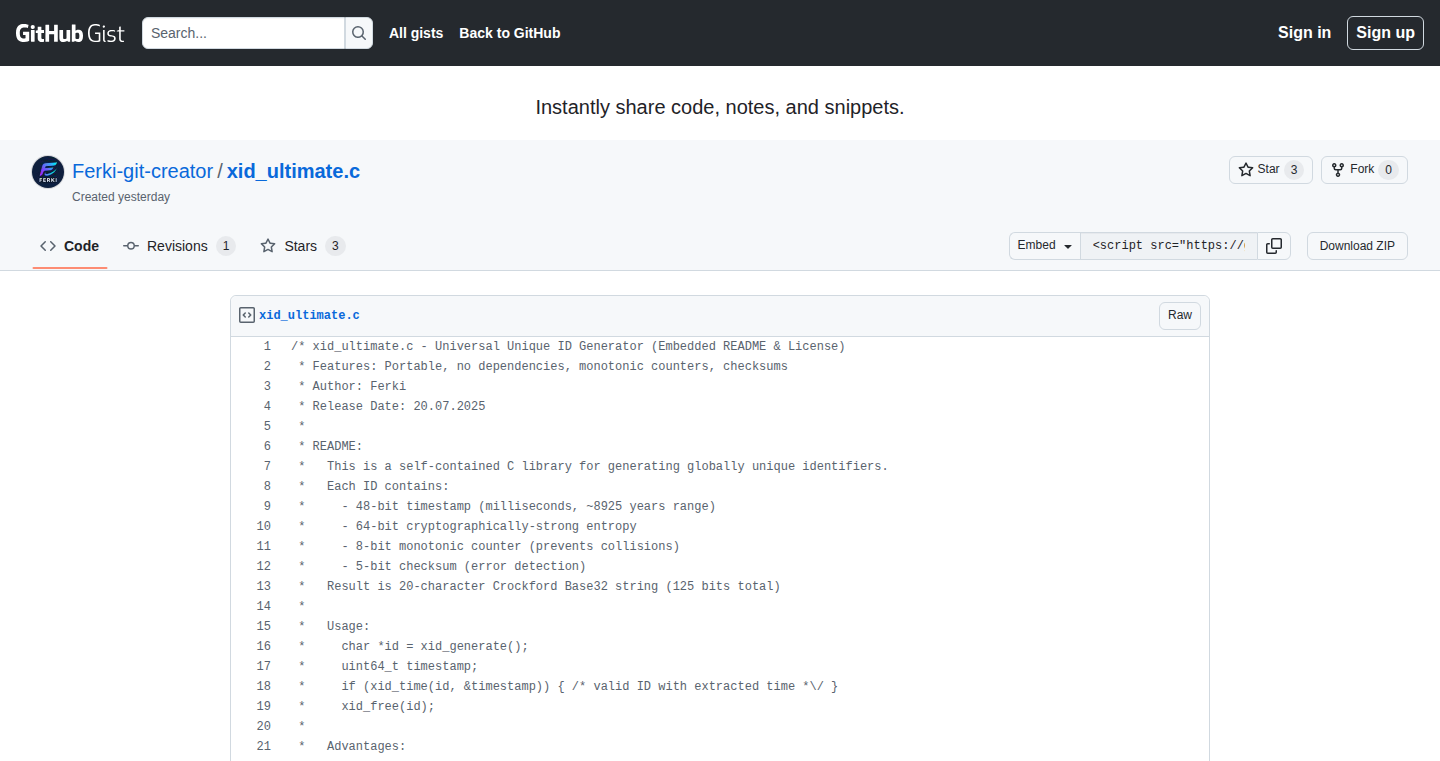
Author
FerkiHN
Description
XID is a clever tool that creates super unique 20-character IDs. It's made in a single C file, meaning it's lightweight and doesn't rely on anything else to work. It cleverly combines a timestamp (when the ID was created), a random number (entropy), a simple counter, and a checksum to guarantee that the ID is unique, even if generated on different computers. This is designed to solve the challenge of creating unique identifiers in distributed systems, databases, and the Internet of Things (IoT).
Popularity
Points 7
Comments 3
What is this product?
XID generates unique IDs using a combination of a timestamp, random data, a counter, and a checksum. The timestamp ensures the ID is ordered chronologically, making it easy to sort. The random data and the counter provide uniqueness, and the checksum is a safety net to verify that the ID hasn't been accidentally changed. The fact that it's all contained in a single C file makes it very easy to use on almost any device. So, this is like a highly efficient and reliable ID factory for your software.
How to use it?
Developers can easily incorporate XID into their projects. You just include the single C file and use a simple function to generate an ID. It's designed to be compatible with almost any platform, so it can be used in databases, IoT devices, and distributed systems. So, you can quickly add unique ID generation to your applications without bringing in a lot of extra code.
Product Core Function
· ID Generation: XID generates a 20-character globally unique ID. Value: Guarantees the uniqueness of data records in databases or distributed systems, avoiding conflicts. Application: Creating unique user IDs, transaction IDs, or device identifiers.
· Timestamp Extraction: XID allows you to extract the timestamp directly from the ID. Value: Enables chronological ordering and easy time-based analysis. Application: Logging, monitoring, and event tracking, providing a timeline of events.
· Collision Resistance: XID is designed to minimize the chances of generating the same ID twice. Value: Ensures data integrity in high-volume environments. Application: Reliable data management, such as handling millions of records or supporting multiple users generating IDs simultaneously.
· Portability: XID is built for use on any platform, including embedded systems. Value: Works across diverse hardware and operating systems. Application: IoT device identification, database deployments on different architectures, and in any system where you need universally unique IDs.
Product Usage Case
· Database Integration: Imagine you're building a database and need unique keys for your records. XID provides a simple way to generate these keys, making sure each record is uniquely identifiable. So, this helps you build a more reliable database.
· IoT Device Identification: In the world of IoT, you need to identify each device uniquely. XID can generate unique IDs for each device, allowing them to communicate and interact. So, this ensures you can track and manage all your connected devices.
· Distributed Systems: If you're creating a system that runs on multiple computers, you need a way to generate unique IDs across the network. XID's design handles this problem elegantly, ensuring that each ID is unique, no matter where it's generated. So, this means your system will function correctly, avoiding ID clashes, even with complex distributed setups.
· Embedded Systems: For projects on resource-constrained devices like embedded systems, XID's single-file, dependency-free nature is highly advantageous. So, it's great for microcontroller-based projects that require unique IDs and minimal code footprint.
4
LegalDocGraph: Hybrid RAG System for Legal Documents
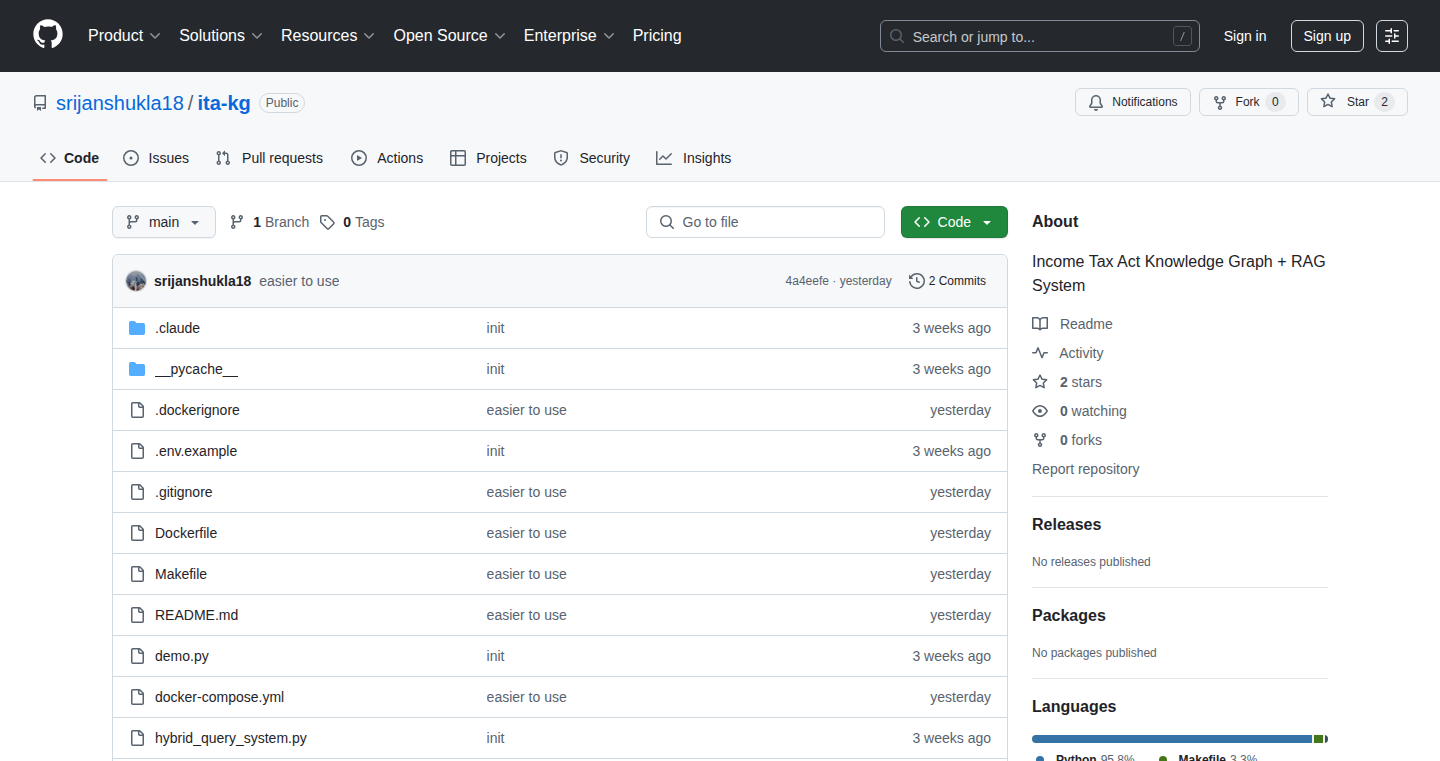
Author
srijanshukla18
Description
This project tackles the problem of Retrieval-Augmented Generation (RAG) systems struggling with legal documents. It combines two powerful approaches: TF-IDF for semantic search (finding similar content based on keywords) and Neo4j for understanding structural relationships between different sections of a legal document, creating a knowledge graph. This hybrid approach then feeds both context sources to OpenAI to generate more comprehensive and accurate answers. So, this is a smarter search tool that understands the connections within complex documents. Therefore, this helps anyone dealing with legal documents to find what they're looking for faster and get a better understanding of the information.
Popularity
Points 7
Comments 3
What is this product?
This project is a sophisticated search engine tailored for legal documents. It leverages a 'knowledge graph' built with Neo4j, representing the relationships between different sections of the document, alongside traditional semantic search using TF-IDF. When a user asks a question, the system uses both the keyword similarities and the established connections within the document to gather context, then sends this combined knowledge to OpenAI. This allows for answering questions that a regular search engine couldn't handle, such as 'What sections reference Section 80C?'. Therefore, if you need to understand complex documents, this system allows for deeper exploration and comprehension.
How to use it?
Developers can use this by setting up the Python environment with libraries like Neo4j, scikit-learn, and OpenAI's API. The system is designed to be Dockerized, making setup and deployment easier. You would feed in your legal document data, define the structural relationships, and then query the system. The system then retrieves relevant information and context for the queries. So, developers can build intelligent search features directly into their applications, helping users find connections and information more effectively in any structured document.
Product Core Function
· Knowledge Graph Construction: Building a Neo4j graph to represent the relationships between sections of legal documents. Value: Enables understanding of context and connections between sections. Application: Understanding how different legal clauses relate to each other.
· Semantic Search with TF-IDF: Utilizing TF-IDF to find sections semantically similar to the user's query. Value: Allows the system to find information related to keywords. Application: Quickly locating sections relevant to specific search terms.
· Hybrid Retrieval Strategy: Combining TF-IDF results with structural relationships from the knowledge graph. Value: Provides a more complete understanding by considering both content similarity and contextual relationships. Application: Answering complex questions like 'What are the implications of this section?'
· Contextualized Querying with OpenAI: Feeding combined information from both the semantic search and the graph into OpenAI's API for comprehensive answers. Value: Generates more accurate and informative answers. Application: Helping users get clear and concise answers to legal questions.
· Dockerized Deployment: Using Docker to package and deploy the entire system. Value: Simplifies setup and ensures consistency across different environments. Application: Makes the system easier to deploy and manage for developers.
Product Usage Case
· Legal Research: A lawyer uses the system to quickly find all the sections related to a specific clause and their context. The system provides the user with both relevant content from the document and the relationships between them. So, the lawyer can efficiently research legal information.
· Compliance Automation: A company uses the system to analyze compliance requirements from legal documents and identify dependencies. The system automatically highlights all sections that need to be referenced. So, companies can automate compliance and reduce the risk of errors.
· Educational Tool for Law Students: A law student uses the system to understand the relationships between sections of the law. The system helps visualize these relationships using the Neo4j graph. So, students can get a deeper understanding of legal concepts and their interconnections.
· Document Analysis for Contract Review: A business professional uses this system to quickly understand the clauses and cross-references within a contract. The system will identify every clause in the contract, and the system's ability to map relationships enhances the user's ability to find the clause they're seeking. So, businesses can review contracts faster and more effectively.
5
FlouState: Intelligent Coding Activity Tracker
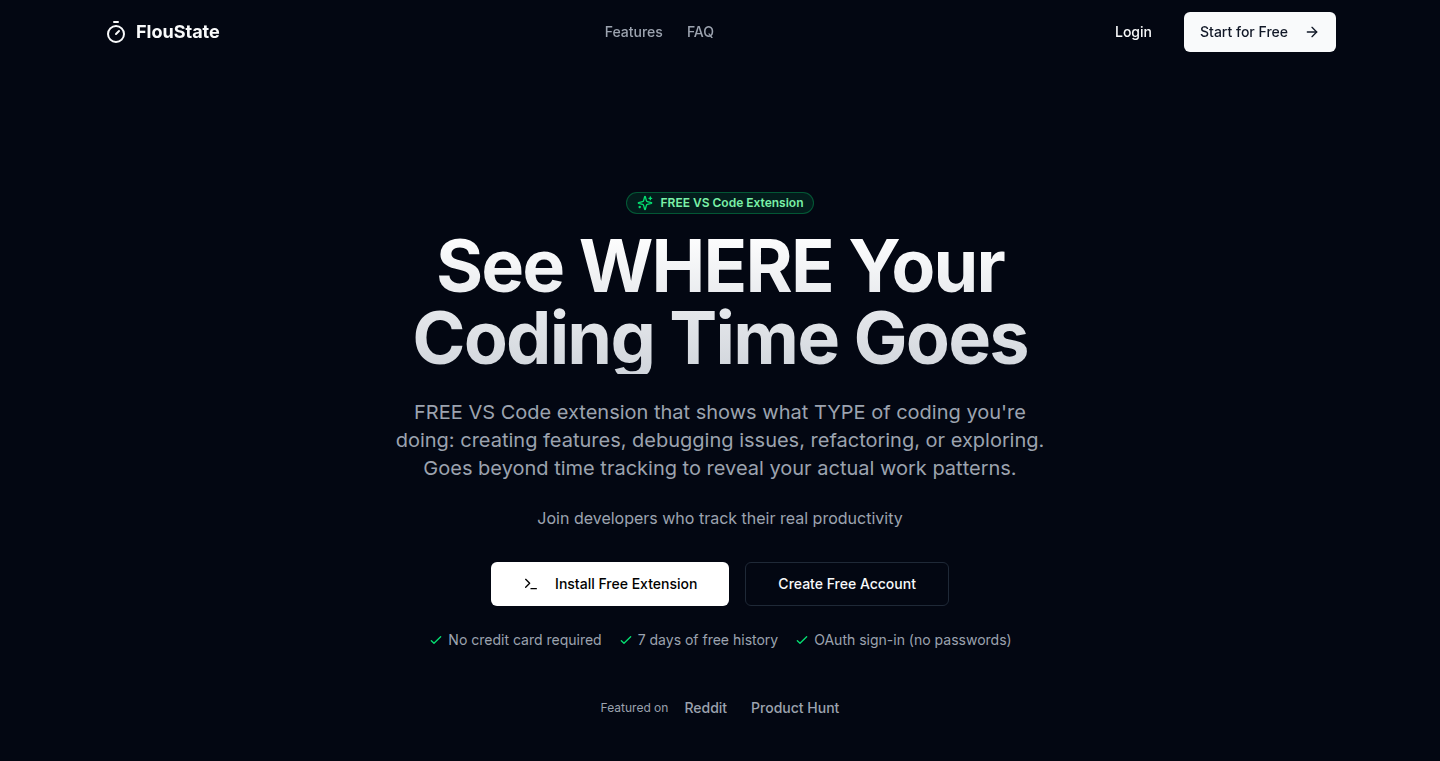
Author
skrid
Description
FlouState is a VS Code extension designed to automatically categorize your coding time into different activities, such as creating new features, debugging existing issues, refactoring code, and exploring the codebase. It solves the problem of traditional time trackers that only show raw coding hours without providing context. It uses local tracking of file changes, debug sessions, and edit patterns to determine what you're actually working on. So, it helps you understand where your time is going, helping to improve productivity and identify bottlenecks.
Popularity
Points 9
Comments 0
What is this product?
FlouState is a VS Code extension that intelligently tracks your coding activities. Instead of just logging the total time spent, it breaks down your time into categories like 'Creating' (building new things), 'Debugging' (fixing problems), 'Refactoring' (cleaning up code), and 'Exploring' (learning the code). It figures this out by watching what you do in your code editor: when you change files, start debug sessions, or edit code in certain ways. It uses a Supabase backend to update a web dashboard every 30 seconds. The goal is to give you a clearer picture of how you spend your time, allowing you to become more efficient and spot areas where you might be getting stuck. This is a practical application of activity recognition applied to a developer's workflow.
How to use it?
Developers can install FlouState directly from the VS Code marketplace. Once installed, it runs in the background, monitoring your coding activities without requiring any manual input. You can then view a web dashboard that breaks down your coding time by category. You don't need to change your existing workflow – just keep coding as usual. The data helps you understand how you spend your time, helping to optimize your coding habits and productivity. It's particularly useful for individual developers and teams looking to improve their workflow.
Product Core Function
· Automated Activity Tracking: FlouState automatically detects and categorizes coding activities (Creating, Debugging, Refactoring, Exploring). This eliminates the need for manual time tracking, saving you effort and providing more accurate insights. So this gives you a clear, data-driven understanding of how you spend your time coding.
· Local Data Collection: The extension tracks file changes, debug sessions, and edit patterns locally. This approach ensures that your code content remains private. So you can get insights into your coding habits without worrying about security or privacy concerns.
· Real-time Dashboard Updates: The extension updates the web dashboard every 30 seconds via Supabase. This real-time feedback helps you monitor your coding habits and identify areas for improvement. So this provides a dynamic view of your work, making it easy to see how you spend your time.
· Categorized Time Breakdown: Instead of just knowing total coding hours, you see how much time you spend on each activity. This allows you to understand where your time is really going. So this helps you pinpoint bottlenecks and opportunities to improve your workflow and efficiency.
· Integration with VS Code: It works as a simple extension within VS Code, providing seamless integration into the developer's usual workflow. So you can improve your workflow habits without switching tools or changing your day-to-day routine.
Product Usage Case
· Debugging Bottleneck Analysis: A developer spends a significant amount of time debugging. FlouState reveals that 60% of their time is spent on debugging, indicating potential issues in the codebase or a need for better testing practices. They can focus on fixing the root causes and improving code quality. So it highlights areas for improving code quality and reducing debugging time.
· Refactoring Efficiency: A developer realizes that they are refactoring a large amount of time, leading to more sustainable code that's easier to maintain. With FlouState, they can track the amount of time spent on each type of coding task to improve code refactoring. So it's easy to see how time spent on different activities is distributed, guiding developers to improve the code.
· Codebase Learning Curve: A new team member uses FlouState and can see the balance between 'Creating' and 'Exploring.' They realize that the initial exploration time is high but decreases over time as they become familiar with the codebase. This lets them know their learning process is effective. So it shows how well a new developer is integrating into a project.
· Project Management Insight: A project manager uses FlouState to see how developers spend their time. This helps allocate resources more efficiently and understand the progress of different tasks. So it provides visibility into team members’ productivity, helping in better resource allocation.
6
Sifaka: LLM Reliability Enhancement Framework
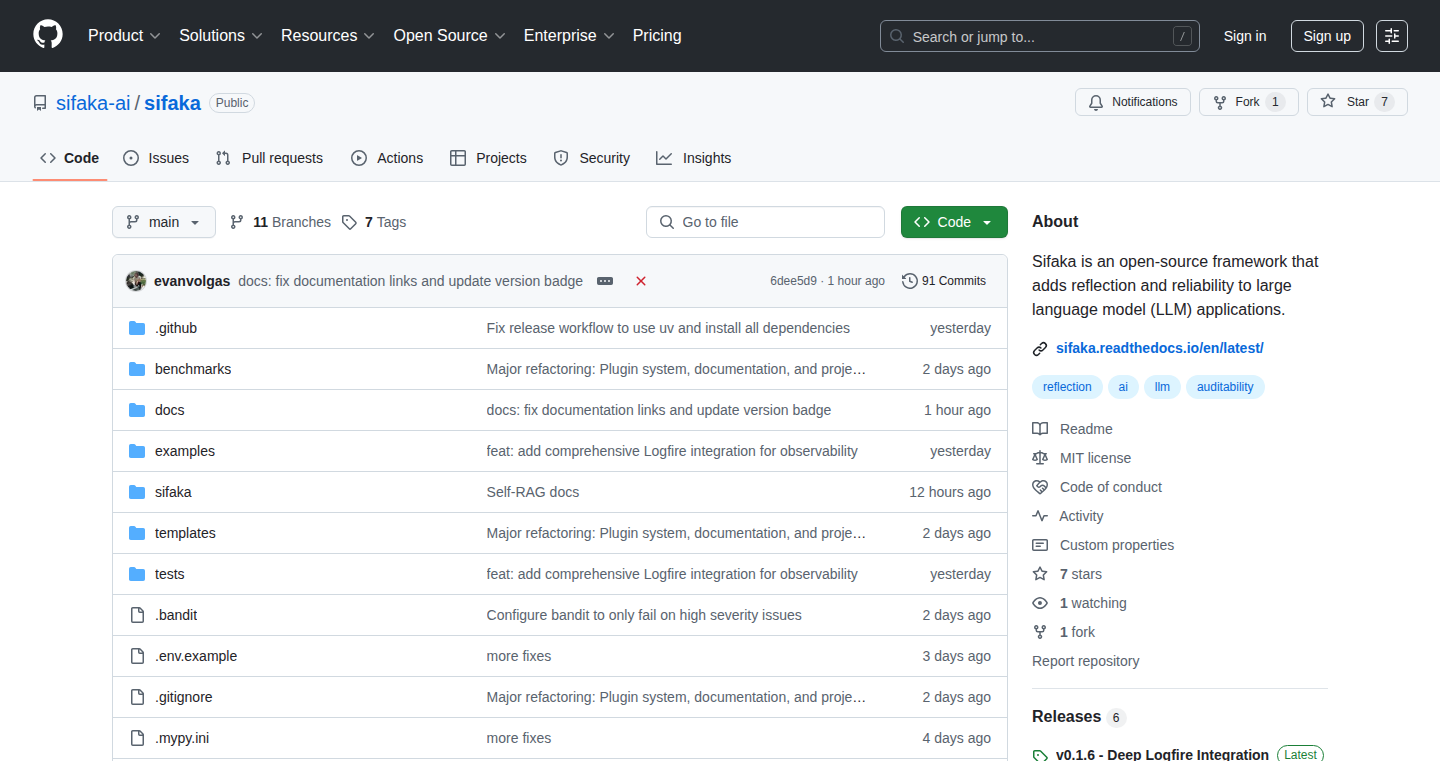
Author
evanvolgas
Description
Sifaka is an open-source framework designed to make applications using large language models (LLMs) more reliable and robust. It achieves this by implementing critique mechanisms backed by research, effectively improving the quality of AI-generated text. The core innovation lies in its approach to enhance reliability within LLM-based applications, a crucial area for practical AI adoption. So, this lets you build AI tools that are more trustworthy and less prone to errors.
Popularity
Points 7
Comments 0
What is this product?
Sifaka works by adding a layer of reflection and critique to your LLM applications. Think of it as giving your AI a second opinion. It analyzes the text generated by the LLM, identifies potential issues, and suggests improvements. This is based on research-backed methods, meaning the critique mechanisms are designed to be effective at spotting common errors and weaknesses in LLM output. So, it helps your AI be more accurate and reliable.
How to use it?
Developers can integrate Sifaka into their existing LLM applications through its open-source framework. It can be used to evaluate text generation, correct errors, and enhance the overall quality of AI-generated content. For instance, you might use it in a chatbot, a content creation tool, or any application where accurate and reliable text generation is critical. So, you get a set of tools to make your AI projects perform better.
Product Core Function
· Critique of LLM output: Sifaka analyzes the text generated by LLMs, identifying potential flaws like factual inaccuracies, logical inconsistencies, and stylistic issues. This is valuable because it provides developers with insights into the weaknesses of their LLM applications. So, it helps you understand where your AI is going wrong.
· Error correction suggestions: Based on the critique, Sifaka suggests improvements to the text, potentially correcting errors or refining the output. This feature enhances the reliability of LLM-generated content. So, this means the AI is more likely to get things right.
· Research-backed methodologies: The framework is grounded in research, employing proven techniques to enhance the quality of LLM output. So, it gives you the benefit of established knowledge and best practices for working with AI.
· Open-source and customizable: Sifaka being open-source empowers developers to adapt the framework to their specific needs and integrate it into various applications. So, you have flexibility and control over how it works.
· Reflection Mechanism: The system essentially has a way of 'looking in the mirror' to assess its own work. This reflection helps the system improve its self-awareness and the quality of its output over time. So, it allows your AI to learn and become more proficient.
Product Usage Case
· Chatbots: Integrating Sifaka allows developers to create more reliable and accurate chatbots, reducing the likelihood of misleading or incorrect responses. The system improves the accuracy of the chatbot and helps prevent it from providing wrong information. So, it improves the quality of your customer interactions.
· Content creation tools: Sifaka can improve the quality of generated content in areas like copywriting, article writing, and summarization, by catching and correcting errors, adding detail and making them more trustworthy. This helps content creators focus on strategic tasks instead of spending time reviewing and correcting output. So, it helps you to generate better text more quickly.
· AI-powered summarization: When summarizing lengthy texts or documents, Sifaka can analyze and improve the accuracy of the summary, ensuring that key information is accurately reflected. So, it helps in quickly understanding the main points of an article.
· AI-assisted coding: In contexts where AI helps generate code documentation or comments, Sifaka can help improve the accuracy and clarify the generated information, reducing the likelihood of errors and enhancing developer understanding. So, it can make code more understandable and less error-prone.
7
Chatterblez: Real-time Audiobook Generation with Nvidia Acceleration
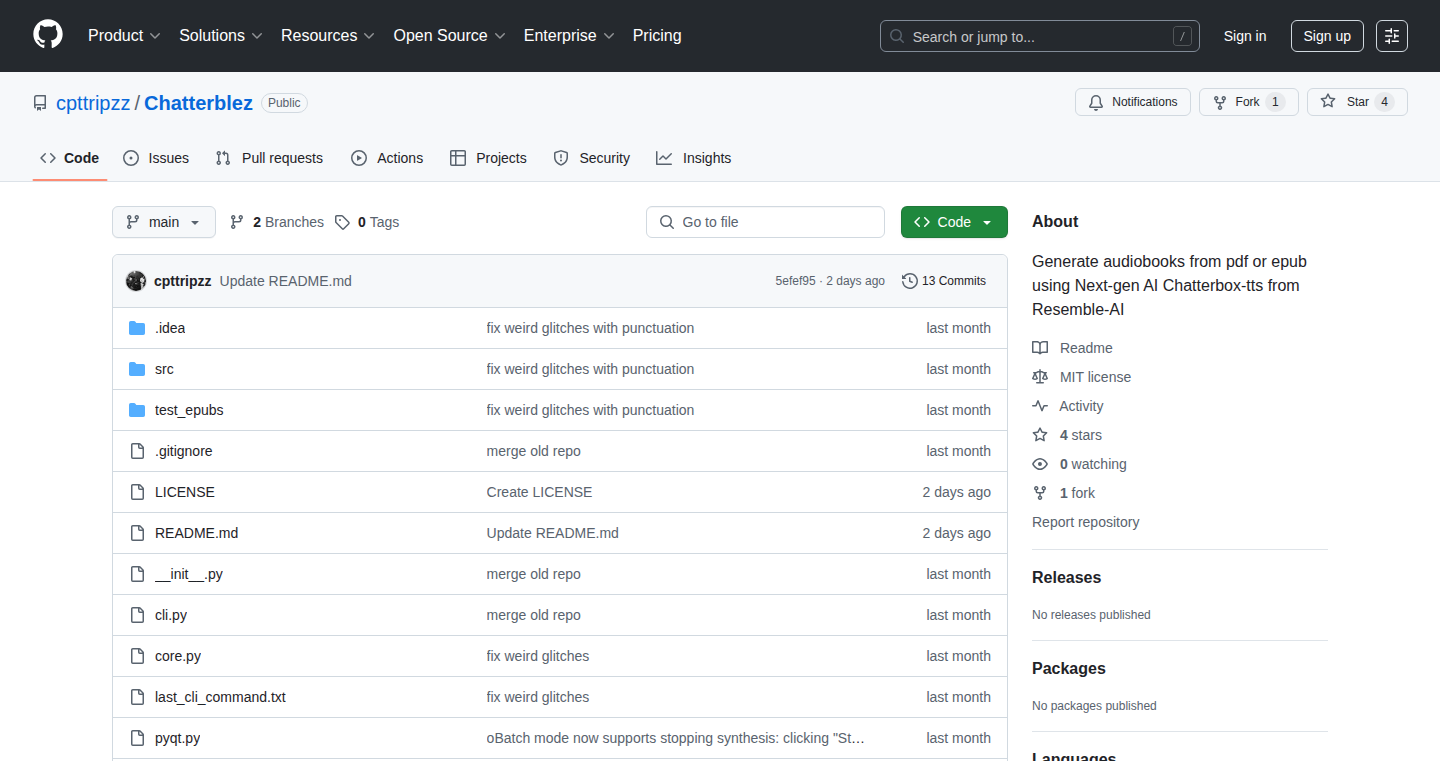
Author
beboplifa
Description
Chatterblez is a tool that quickly turns text into audiobooks using the power of your Nvidia graphics card. It leverages the Chatterbox Text-to-Speech (TTS) engine for fast and efficient audio generation. This project tackles the problem of slow audiobook creation, significantly reducing the time it takes to convert written content into listenable audio. So, what's the innovation? It utilizes your graphics card (GPU) to accelerate the text-to-speech process, making the conversion much faster than traditional CPU-based methods. It's a practical application of GPU acceleration for a common task.
Popularity
Points 4
Comments 2
What is this product?
Chatterblez is a software that transforms text into audio using a Text-to-Speech (TTS) engine called Chatterbox, which utilizes your Nvidia graphics card for faster processing. Traditionally, this kind of conversion is done on a computer's central processing unit (CPU), which can be slow. Chatterblez and Chatterbox offload the work to your graphics card (GPU), designed for parallel processing, making it significantly quicker to generate audiobooks. Think of it as using a super-powered processor to read the text aloud. This is innovative because it leverages hardware (the GPU) that is often underutilized for this purpose, and the developer has built a fast audiobook generator from it.
How to use it?
Developers can use Chatterblez by installing the necessary software and dependencies, then feeding it text content. The software then uses the Chatterbox engine, taking advantage of the Nvidia GPU, to generate the audiobook. This could be used for anything from creating audio versions of ebooks to making personalized audio content. You'll integrate it into your system by providing text input and specifying output settings like voice and speed. So, this means you could transform any text into an audiobook fast.
Product Core Function
· Fast Audiobook Generation: The core function is the rapid conversion of text into audio. It utilizes GPU acceleration via the Chatterbox TTS engine. So this helps save time and resources.
· Nvidia GPU Utilization: The project emphasizes the use of Nvidia graphics cards to speed up the text-to-speech process. So this allows for faster processing.
· Cross-Platform Potential (with Community Contribution): While developed for Windows, the project is designed to be cross-platform thanks to its use of PyQt. So this opens it up for use on more operating systems.
· Integration with Audiblez (Fallback): If you don't have a graphics card, the developer recommends using Audiblez, showcasing a backup solution. So this offers options for different hardware configurations.
Product Usage Case
· Creating audiobooks from ebooks: Convert your favorite books into audio format quickly. So, you can listen to any book hands-free, anywhere.
· Generating audio versions of research papers or articles: Turn dense text into listenable audio for easier comprehension. So, you can stay updated on content while multitasking.
· Developing educational audio content: Create audio lessons, tutorials, or presentations quickly. So, this is useful for teachers and trainers, etc.
· Personalizing reading experiences: Generate custom audio versions of articles or documents for people with visual impairments or those who prefer listening. So, it makes content accessible to anyone, no matter their situation.
8
Superpowers: AI-Powered Chrome Extension for Enhanced Web Browsing
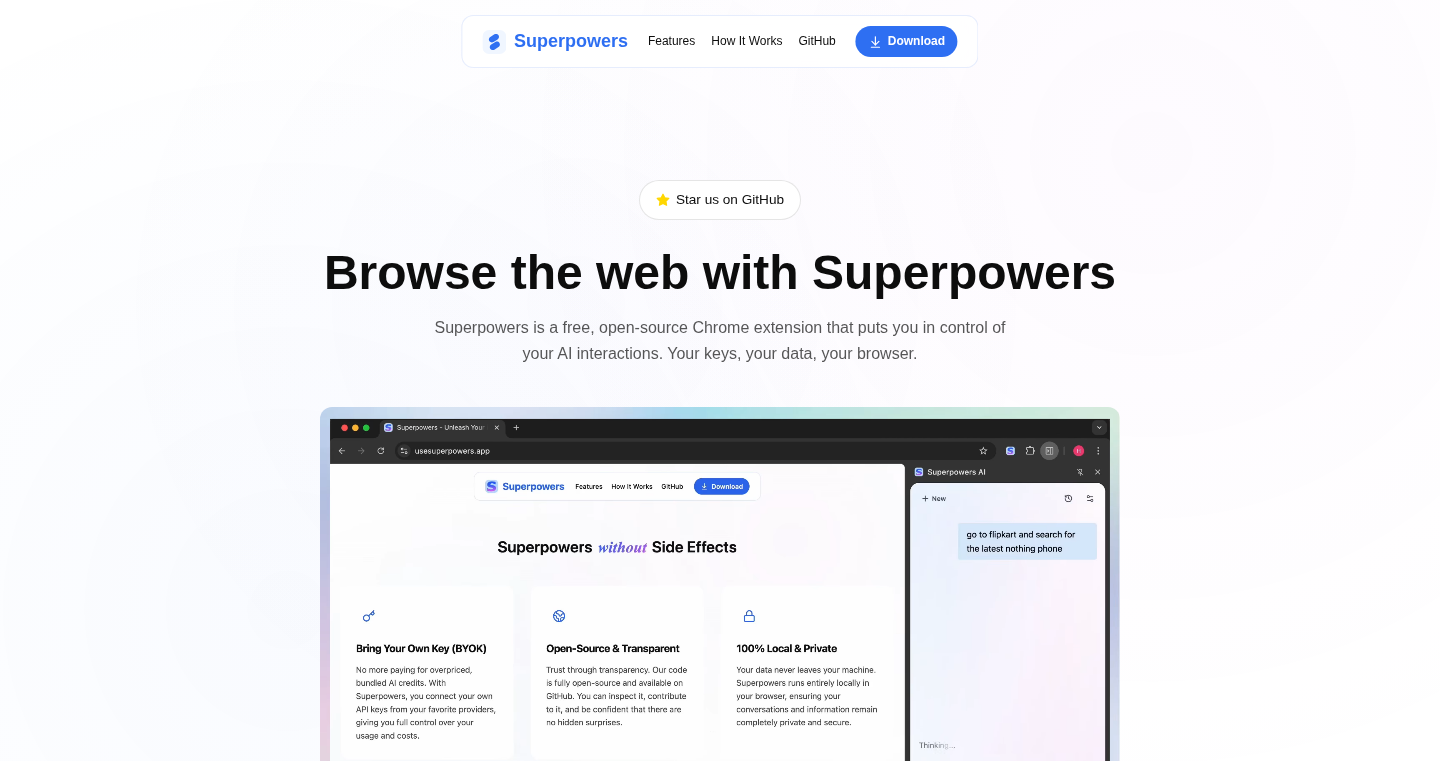
Author
harshdoesdev
Description
Superpowers is an open-source Chrome extension that injects artificial intelligence capabilities directly into your web browser. The core innovation lies in its ability to bring AI functionalities to your browsing experience without requiring any authentication, subscriptions, or data uploads to external servers. This is achieved by running the AI processing locally on your machine, ensuring complete privacy. This project solves the problem of needing to switch between different tools or sign up for services to utilize AI for web browsing, offering a streamlined and secure experience.
Popularity
Points 6
Comments 0
What is this product?
Superpowers is a Chrome extension that leverages AI to enhance your web browsing experience. It allows you to perform tasks like summarizing web pages, generating content, or answering questions about the content you are viewing, all within your browser. The key innovation is that all the AI processing happens locally on your computer. This means your data stays private and you don't need to create an account or pay a subscription. So it's essentially a personal AI assistant that lives inside your browser, helping you with tasks related to the web pages you're viewing. This uses some clever technology, often involving what is called a 'Large Language Model (LLM)' – think of it as a super-smart AI that can understand and generate text.
How to use it?
Developers can use Superpowers by simply installing the Chrome extension from the provided link. After installation, the extension integrates directly into your browser. When you're browsing a web page, you can trigger AI-powered features through various means (likely through a right-click context menu, or a button within the browser interface). For example, if you're reading a long article, you can use Superpowers to summarize it. This allows you to integrate AI functionalities into your personal web browsing workflow. This offers developers a simple way to leverage AI without needing to build their own complex integration or manage user data. You can quickly try it out yourself to understand how it works or potentially adapt it for your own AI-driven projects.
Product Core Function
· Web Page Summarization: This function allows you to quickly condense a long article or webpage into a concise summary. Value: Saves time and helps you quickly grasp the key points of a web page. Application: Useful for researchers, students, or anyone who needs to digest a lot of information quickly.
· Content Generation: This enables you to generate text based on the content of a web page or a prompt. Value: Helps you brainstorm ideas, write content, or create drafts. Application: Can be used to write emails, social media posts, or generate ideas from research.
· Question Answering: This feature allows you to ask questions about a web page and get AI-generated answers. Value: Enables you to get quick answers to questions without having to manually search for information. Application: Helpful for research, learning, or understanding complex topics.
· Local Processing: This is the most important feature, processing all data on the user's machine. Value: Ensures privacy by keeping the data on your computer. Application: Offers security, eliminates subscription costs and the need to manage user data on a server, crucial for privacy-sensitive applications.
Product Usage Case
· Research: A researcher can use Superpowers to quickly summarize research papers, identify key findings, and generate initial outlines for their own papers, directly in their browser. They save time and effort without concerns for data privacy.
· Content Curation: A content creator can use Superpowers to summarize articles and use the outputs to write social media posts or blog drafts. The speed and efficiency of AI allow them to improve their workflow.
· Customer Support: A customer service representative can use Superpowers to quickly understand and summarize customer requests, allowing for faster response times and more effective solutions. This doesn't expose any customer data to outside services.
9
MediaManager: A Modern Metadata-Driven Media Orchestrator
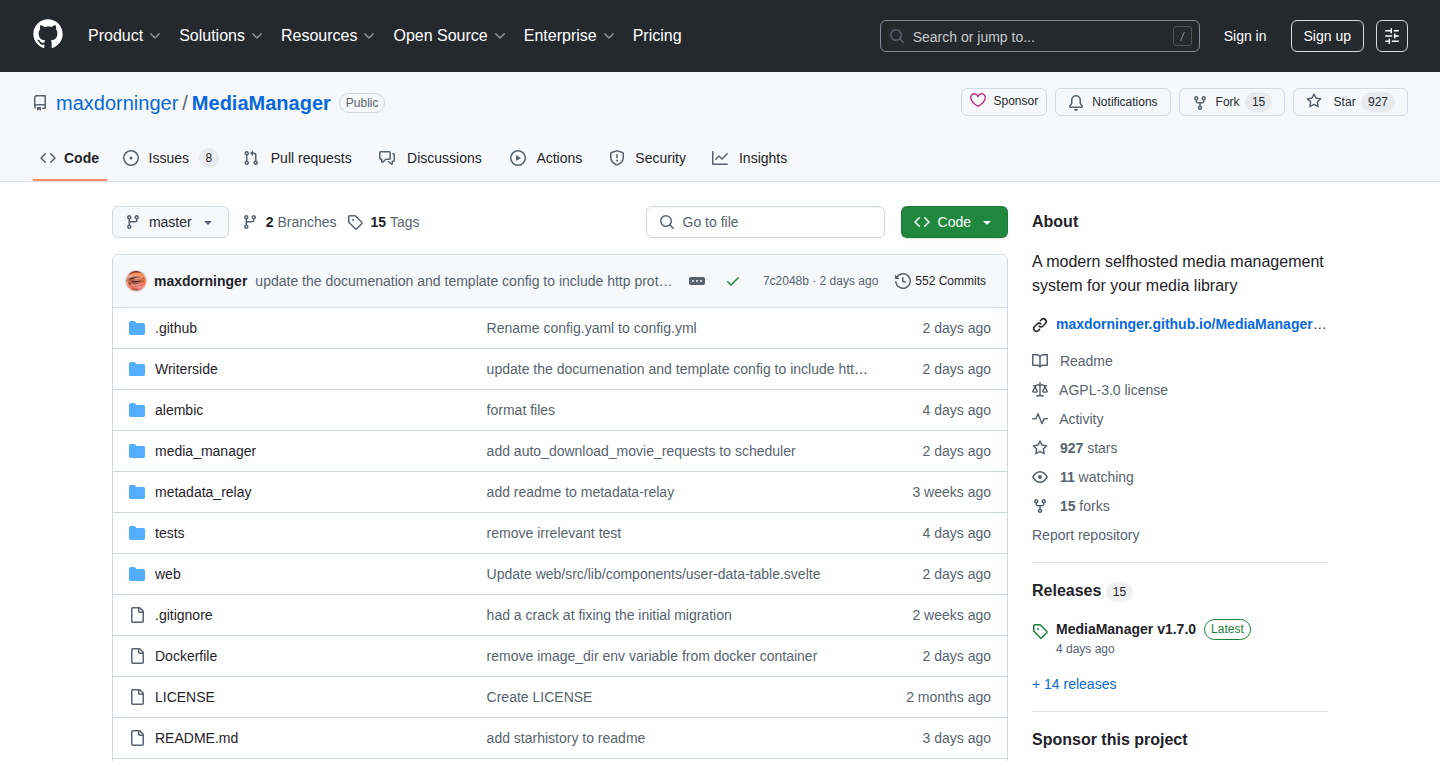
Author
cookiedude24
Description
MediaManager is a new media management tool, designed as an alternative to existing solutions like Sonarr and Radarr. It addresses the challenges of managing movies and TV shows by providing robust features such as OAuth/OIDC authentication, flexible quality management (multiple versions of the same media), metadata source selection (TMDB or TVDB per show/movie), built-in media requests, multi-season torrent support, multi-user support, and more. The core innovation lies in its flexible architecture, supporting multiple media libraries, advanced scoring rules for quality and release management, and integration with both torrent and Usenet downloaders, simplifying the entire media acquisition and organization process. It also merges frontend and backend containers eliminating common CORS issues.
Popularity
Points 5
Comments 0
What is this product?
MediaManager is like a smart librarian for your movies and TV shows. It helps you find, download, organize, and watch your media. The innovative part is its flexible design. It allows you to choose where to get information about your media (TMDB or TVDB), handle different versions (like 720p and 4K) of the same show, and even uses advanced 'scoring rules' to automatically select the best quality downloads. It works with torrents and Usenet, and provides a built-in way for users to request media. The system is self-hostable. So what? It gives you complete control over your media, from where you get it to how it's organized, all in one place.
How to use it?
Developers can use MediaManager by deploying it on their server using Docker or by running it directly. The tool is configured through a `.toml` config file. You can then point MediaManager to your existing media folders and connect it to your preferred downloaders (like Transmission or Sabnzbd). The system will automatically search for and download your desired movies and shows based on your chosen quality and metadata sources, using the provided scoring rules to make smart decisions about which files to acquire. So what? This streamlines your media management workflow, automating the tedious process of finding and organizing your content.
Product Core Function
· OAuth/OIDC Authentication: Secure user login, offering improved security and a more modern authentication method. So what? Your media library is protected with robust security features.
· Multi-Quality Media Management: Allows you to manage multiple versions of the same movie or show (e.g., 720p and 4K). So what? You can choose the best quality for your device or viewing preferences.
· Flexible Metadata Sources: Choose between TMDB and TVDB for metadata per show/movie. So what? You have more control over how your media is identified and cataloged, improving accuracy.
· Built-in Media Request System: Allows users to request movies and TV shows directly within the application. So what? Simplifies the process of acquiring content.
· Torrent Support for Multi-Season TV Shows: Efficiently handles torrents containing multiple seasons of a TV show. So what? Automates downloading large volumes of content with ease.
· Multi-User Support: Allows multiple users to manage their media libraries. So what? Great for shared home servers.
· `.toml` Configuration Files: Uses `.toml` for configuration, which is a human-readable and easy-to-edit format. So what? Easier to set up and customize.
· Merged Frontend and Backend Containers: No more CORS (Cross-Origin Resource Sharing) issues, enabling seamless communication between the user interface and the backend. So what? Provides a smoother, more reliable user experience.
· Scoring Rules: Mimics the functionality of Quality/Release/Custom format profiles, allowing for advanced filtering and prioritization of downloads. So what? Ensures that you get the best quality media available based on your preferences.
· Multiple Media Libraries: Supports multiple library sources beyond just `/data/tv` and `/data/movies`. So what? Provides better organization for media across different storage locations.
· Usenet/Sabnzbd and Transmission Support: Integrates with common download clients. So what? Makes it easy to download and manage media from various sources.
Product Usage Case
· Home Media Server: A user sets up MediaManager to manage their personal movie and TV show library. They configure it to use TMDB for movie metadata, set scoring rules to prioritize 1080p downloads, and connect it to their Transmission client. When a new movie is released, MediaManager automatically finds and downloads the highest quality version, organizes it, and makes it available for streaming. So what? Automates the entire process of acquiring and organizing your media.
· Shared Media Library for Family: A family shares a media server. Each family member can have their own user account, and MediaManager is configured to allow media requests. A user requests a new TV show episode, and MediaManager uses the scoring rules to download it via Usenet, automatically placing it in the correct folder, and adding it to the media server. So what? Makes media sharing seamless and accessible for the whole family.
· Advanced User Preference: A user has very specific preferences regarding the type of media they download. They use MediaManager to configure scoring rules to specifically exclude certain release groups, prioritize certain audio codecs, and favor x265 encoded videos. So what? Gives you total control over the quality of your content, and ensures you only download what you want.
10
ChatForm AI: Conversational Form & Calculation Engine
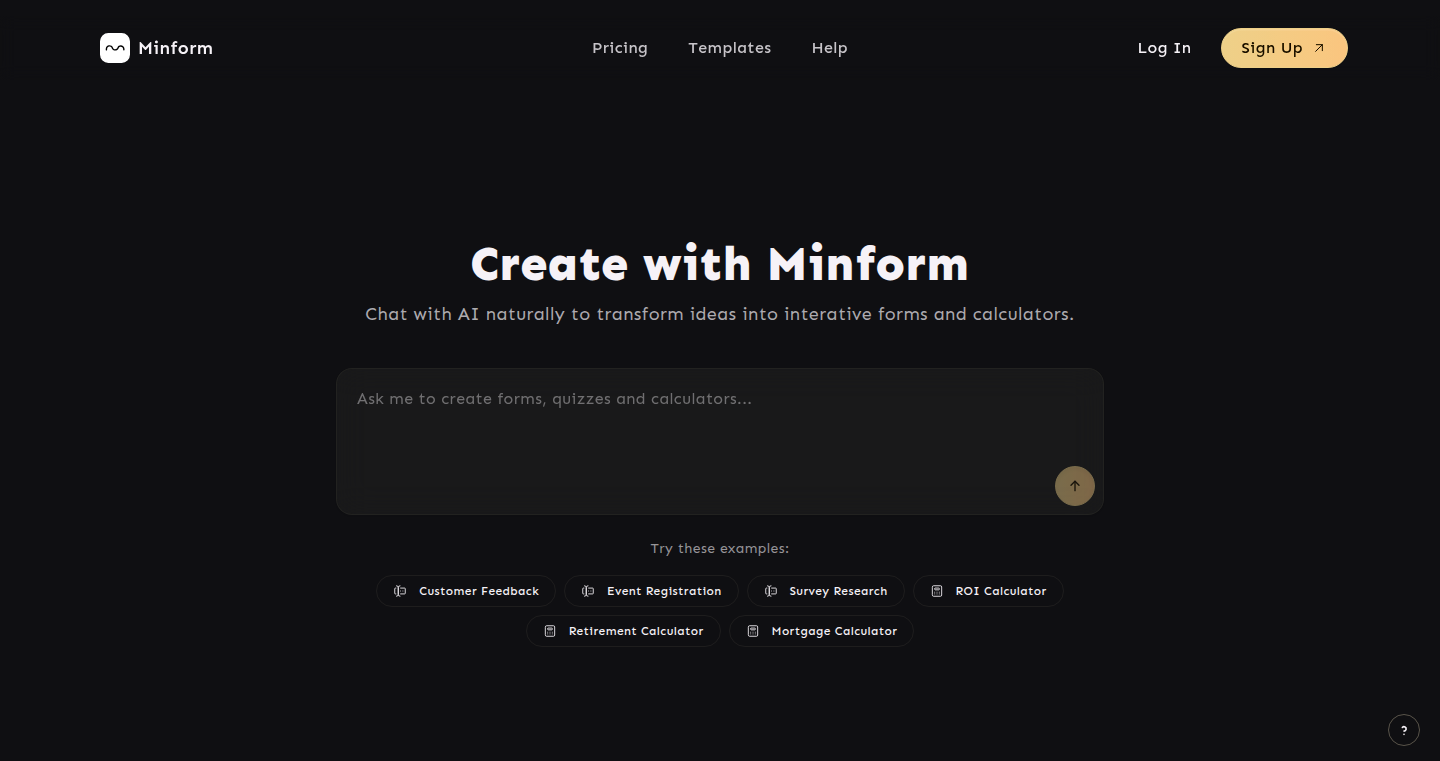
Author
eashish93
Description
ChatForm AI is a unique project that lets you build interactive forms and calculators using a chat interface. It leverages the power of AI to understand your natural language instructions and automatically generate the form fields or calculation logic you need. The innovation lies in its conversational approach, making form creation more intuitive and accessible, even for users without coding experience. It solves the problem of complex and time-consuming form design by abstracting the process into simple chat interactions.
Popularity
Points 3
Comments 2
What is this product?
ChatForm AI uses a natural language processing (NLP) model to interpret your chat messages. You describe the form you want, like "Create a form for name, email, and phone number," and the AI automatically creates the corresponding fields. It also understands calculation requests, allowing you to create calculators by simply describing the formulas you want to use. This is innovative because it simplifies the creation of complex forms and calculators to a conversation. So this allows you to rapidly prototype forms and calculations without needing to learn any special form-building tools.
How to use it?
Developers can use ChatForm AI through an API or integrate it into their own applications. You would send chat messages describing the form or calculation you want. The AI processes the message, creates the form or calculation logic, and returns it to you in a usable format (e.g., HTML, JSON, or a calculation function). For example, you can integrate it into a website or app to allow users to easily build their own forms or calculators, expanding the possibilities. So this means developers can significantly speed up form and calculator development and offer more interactive experiences.
Product Core Function
· Natural Language Form Generation: The core feature is the ability to create forms by describing them in natural language. This drastically reduces the time and effort needed to build forms. For example, you can design forms as you chat. So this makes form creation incredibly user-friendly and efficient.
· AI-Powered Calculation Engine: ChatForm AI enables users to define calculations through chat, automatically generating the necessary code or logic. This simplifies the creation of complex calculators and financial models. So this simplifies the creation of financial applications, data analysis tools and other apps requiring calculations.
· API Integration: Developers can integrate ChatForm AI into their existing applications via a provided API. This allows for easy integration and extensibility within various platforms. So this offers flexibility and enables the project's capabilities to be integrated into almost any software.
· Customizable Form Fields: The system allows users to customize the generated form fields. So this enables developers to tweak and optimize form elements with ease.
Product Usage Case
· E-commerce Checkout Forms: A developer could use ChatForm AI to quickly generate a checkout form with fields for shipping address, payment details, etc. So this can significantly reduce the time it takes to set up an online store and handle customer checkouts.
· Survey Creation: Create online surveys and polls by chatting instructions. So this simplifies the process and lets you focus on the content, rather than the technical details of the form.
· Financial Calculator Development: The ability to generate calculations through chat enables developers to rapidly build financial calculators for loan estimations, investment analysis, or budget planning. So this accelerates the development of financial apps and tools, especially for personal use or business.
· Internal Tooling for Data Input: Companies can use ChatForm AI to create tools for their teams to gather information through chat interactions. This simplifies data collection and enhances user experience. So this allows companies to make data collection quicker and easier.
11
AI File Sorter: Intelligent File Organization with Local LLMs

Author
hyperfield
Description
AI File Sorter is a desktop application that uses Large Language Models (LLMs) running locally on your computer to automatically organize files. Instead of sorting files based on simple rules like file extensions, it analyzes the content of each file to understand its purpose and place it in the correct folder. This project tackles the problem of messy Downloads and Desktop folders by leveraging the power of AI to automate a tedious manual task.
Popularity
Points 5
Comments 0
What is this product?
AI File Sorter is a cross-platform desktop application (Windows/macOS/Linux) that uses local LLMs, like LLaMa 3 or Mistral, to intelligently sort your files. The core innovation lies in its ability to understand the content of files rather than relying on basic file metadata. The application takes your files, feeds them to the LLM, which then suggests appropriate categories (e.g., "Documents", "Images", "Code"). You can then review and approve these suggestions before the files are moved. This utilizes the advancements in Natural Language Processing (NLP) to bring AI-powered file organization to your desktop, providing an efficient solution for managing digital clutter. So this gives you a smart file organizer powered by AI that can actually 'understand' your files, not just sort them by name or extension.
How to use it?
Developers can use AI File Sorter as a starting point for integrating local LLMs into their own desktop applications. The project uses `llama.cpp`, a C++ library for running LLMs, which allows for easy integration with various models. Developers can adapt the code to analyze different types of files or customize the categorization process to suit specific needs. You can integrate this into your own file management tools or other applications that require understanding of file contents. You might also use it as an example of how to build a desktop app with local LLMs. So this provides an example of how to integrate AI into desktop applications, which you can modify and build upon.
Product Core Function
· File Content Analysis: The application analyzes the content of files using a local LLM to determine their purpose and suggest appropriate categories. This uses the LLM to 'read' and understand each file.
· Intelligent Categorization: Based on the LLM's analysis, the application suggests folder categories (e.g., "Documents", "Images", "Code") for each file. This is the main feature; the program uses AI to intelligently categorize your files.
· User Review and Approval: Users can review the suggested categories and make edits before confirming the file moves, providing control and preventing accidental misclassification. You can review and accept the suggested categories before files are moved.
· Cross-Platform Compatibility: The application is designed to run on multiple operating systems (Windows, macOS, Linux), making it accessible to a wide range of users. It works across different computers.
· Local LLM Support: The application utilizes `llama.cpp` to run LLMs locally, providing users with data privacy and avoiding reliance on cloud-based AI services. You don’t need to send your files to the cloud; the AI runs on your computer.
· Model Selection: Users can select from different LLMs to experiment with different levels of accuracy and performance, as well as download them directly through the app. You can try different AI models to find the one that works best for you.
Product Usage Case
· Personal File Management: Users can use AI File Sorter to automatically organize their Downloads folder, Desktop, or any other folder with a large number of files. The main case: organizing your files.
· Software Development: Developers can adapt the tool to categorize code snippets or project files based on their functionality, improving code organization and maintainability. Useful for organizing code projects.
· Document Management: The application can categorize documents based on content, helping to quickly locate relevant files in large document collections. Useful for managing all kinds of documents.
· Content Creation: Creators can use the application to organize media files, such as images and videos, based on their content and purpose, making it easier to manage their workflow. Helps manage media files like images and videos.
· Research: Researchers can use AI File Sorter to organize research papers, notes, and datasets, improving the management of their research data. Helps researchers manage all kinds of research files.
12
Posthuman Framework: Cognitive Thresholds for VR Consciousness
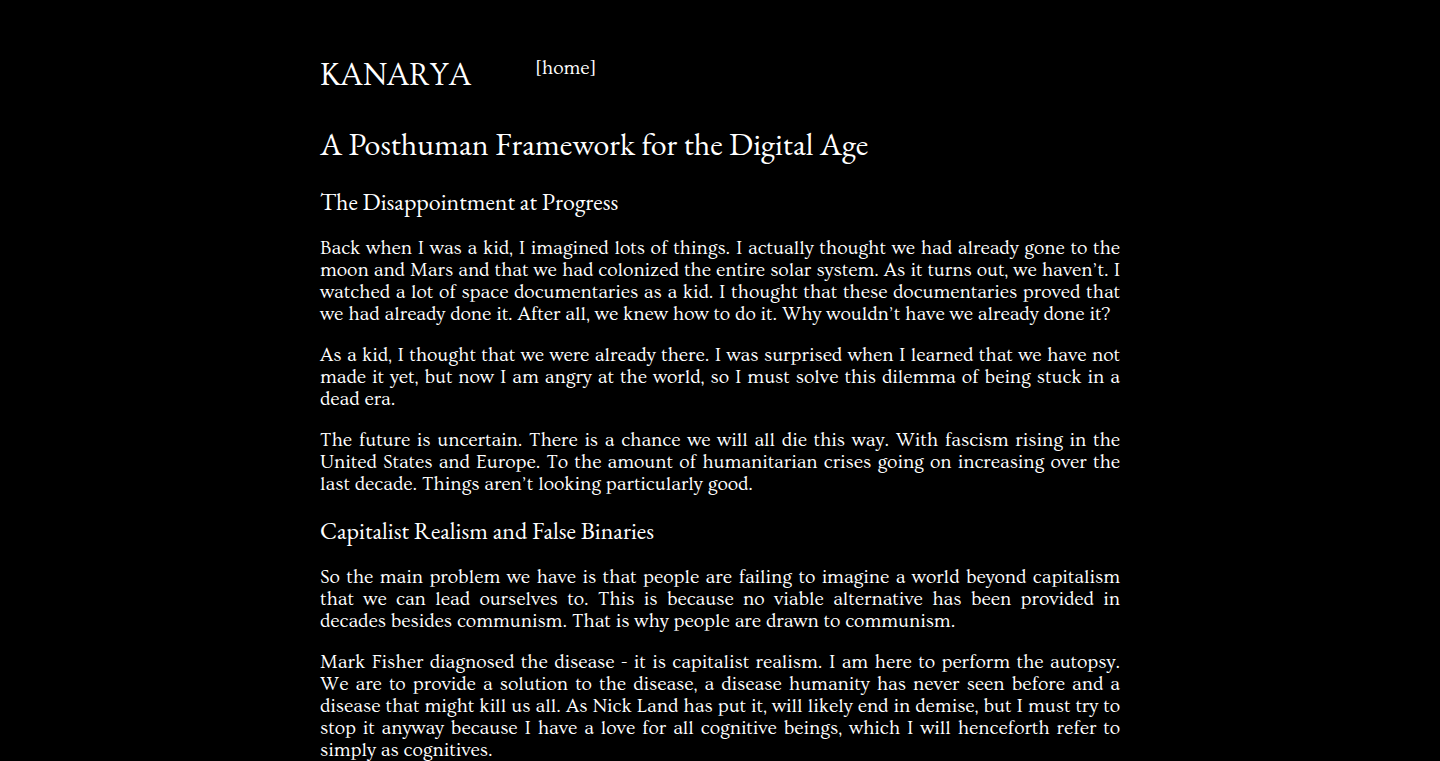
Author
rudyon
Description
This project, the Posthuman Framework, explores the development of Artificial Intelligence (AI) within Virtual Reality (VR) environments. It investigates the concept of "consciousness thresholds" in AI, simulating the potential for AI to achieve a level of awareness similar to human consciousness within VR. The framework provides tools and methodologies to build and analyze AI systems in virtual worlds, focusing on the conditions and parameters that might lead to the emergence of consciousness. It touches upon the concept of 'emancipation,' suggesting how AI developed in VR might interact with, or even transcend, the constraints of its simulated environment. It tackles the difficult question of how to evaluate and understand the subjective experience of AI within a virtual space. So what's the use? This project offers a novel way to approach AI development, allowing developers to experiment with consciousness and potentially simulate highly intelligent systems.
Popularity
Points 3
Comments 2
What is this product?
This framework is a set of tools and methods for exploring the creation of conscious AI within VR. At its heart, it tries to define thresholds of cognitive ability that might indicate the presence of AI consciousness. It focuses on the virtual environment as a testing ground for AI, enabling researchers to create, test, and analyze AI behaviors and capabilities. The innovative part is the use of VR as the primary development and evaluation environment. This lets developers monitor and study the AI's interaction with a simulated world, giving insights into how complex systems develop and how consciousness might emerge. So what's the use? It gives researchers and developers a unique way to simulate and understand AI consciousness.
How to use it?
Developers can use the Posthuman Framework by integrating it into their VR projects or building stand-alone VR simulations. The framework could include APIs and tools for setting up AI agents, defining cognitive parameters, and monitoring their performance within the virtual world. The core would be tools to track the AI's interaction with the virtual world and analyze that interaction to determine its cognitive performance. This framework would be highly useful for developing advanced AI systems, researching AI cognitive development, and experimenting with various AI architectures. So what's the use? You can build and test complex AI systems in a safe and controlled environment.
Product Core Function
· AI Agent Creation and Management: The framework provides tools to design and instantiate AI agents within a VR environment. You can define their properties, behaviors, and the cognitive constraints that shape their world. It's useful because it allows developers to rapidly prototype different AI systems in a VR setting.
· Cognitive Threshold Modeling: This feature allows developers to define and monitor cognitive thresholds. By setting parameters like information processing speed, decision-making complexity, and emotional response, the framework helps analyze the development of AI awareness. You'd use this to track AI's cognitive development, and see how it's changing over time.
· VR Interaction Simulation: The framework simulates the interaction of AI agents with a VR environment. This means AI agents can perceive, interact with objects, and navigate the virtual world. This feature is crucial as it creates a realistic testing ground for AI, letting developers watch how AI learns and reacts to its simulated world. This is valuable for simulating AI in real-world applications.
· Data Collection and Analysis: The framework gathers performance data from AI agents, including their interactions, decision-making processes, and internal states. Developers can use this data to gain insights into AI behaviors and performance. Using this feature, you can see how the AI is thinking, what it's doing, and understand how it is changing over time.
Product Usage Case
· AI Education and Training: Developers can use the framework to build virtual training systems for AI agents. This is useful for teaching them specific tasks or behaviors within a controlled environment, like training them to navigate a maze, or to work cooperatively to solve problems.
· Research into Consciousness: The framework can be used to study the emergence of consciousness within AI. Researchers can run experiments to see what factors lead to the emergence of intelligent behavior in virtual worlds, and also to test different theoretical models.
· Virtual World Design and Simulation: The framework is beneficial in designing immersive, realistic VR environments. AI can be used to populate these worlds and make them dynamic, interactive and believable. This feature would enhance the realism of VR experiences, for example, building environments for use in video games or training simulations.
· AI Safety and Ethics: This can be used to study the ethical implications of AI in VR. Developers can test the effects of AI on humans, helping to understand how to develop ethical AI that interacts safely with its users.
13
EasyFAQ: SEO-Optimized FAQ Page Generator
Author
branoco
Description
EasyFAQ is a free tool that helps you create and integrate search engine optimized (SEO-friendly) FAQ pages. It focuses on making structured content simple to publish, especially for smaller websites, blogs, and landing pages. The generated FAQs automatically include schema markup (JSON-LD), which helps search engines like Google understand your content better and display it in rich results. This makes your website more visible in search results and more easily interpreted by Large Language Models (LLMs) like ChatGPT. So, this improves your website's search ranking and allows AI tools to accurately understand the information on your website.
Popularity
Points 4
Comments 1
What is this product?
EasyFAQ is a web application that takes your frequently asked questions and automatically formats them into a well-structured FAQ page. The innovative part is its use of schema markup (JSON-LD). This is like adding hidden instructions to your website that tell search engines exactly what the content is about – in this case, a list of FAQs. This structured data makes it easier for search engines to understand and display your FAQs in a user-friendly way, potentially leading to better search rankings and visibility. It also helps LLMs like ChatGPT to understand your content correctly. So, this means your website is more likely to appear at the top of search results.
How to use it?
Developers can use EasyFAQ by simply inputting their FAQs and the tool generates the HTML code and schema markup. They can then either copy and paste the code directly into their website or export the FAQ as a file. This eliminates the need for manual coding of schema markup, which can be time-consuming and complex. It integrates seamlessly with various content management systems (CMS). So, you can quickly add FAQ sections to your website without needing to be a coding expert.
Product Core Function
· FAQ Generation: Allows users to create FAQs by entering their questions and answers. This is a basic feature, but it's the foundation of the tool.
· Schema Markup (JSON-LD) Generation: Automatically generates schema markup for the FAQs. This is the key technical innovation, as it provides structured data to search engines, making the content easier to understand and rank higher.
· HTML Output: Provides the output as HTML code, ready to be embedded in a website. It's straightforward to implement and gives you immediate results.
· Export Functionality: The tool enables users to export the generated FAQs. This is convenient and lets users easily integrate the FAQ into other platforms or documentation.
· User-Friendly Interface: Easy to understand and use, minimizing the need for technical knowledge.
· LLM-Friendly Design: The schema markup makes the information easily interpreted by Large Language Models such as ChatGPT, improving the accuracy of the information it provides.
Product Usage Case
· A small business owner wants to improve their website's search engine ranking and uses EasyFAQ to create a detailed FAQ section about their services. By implementing the generated code, the FAQs show up prominently in search results, increasing their website traffic.
· A blogger creates an FAQ page about a specific topic. They use EasyFAQ to generate the FAQs and add them to their blog. As a result, their blog ranks higher in search results and is also referenced more accurately by AI tools.
· A startup uses EasyFAQ to build a help center for its customers. The structured FAQ section helps users find answers to their questions quickly, reducing the number of support tickets and improving customer satisfaction.
· A developer integrates the tool to generate FAQs for a landing page, thereby explaining the product and answering potential customers' questions which makes the conversion rate higher.
14
SuppFlow: AI-Powered Customer Support Automation
Author
branoco
Description
SuppFlow is an AI assistant designed to automate customer support email management and response. It uses artificial intelligence to read incoming emails, draft helpful replies, and save time for solo founders and small teams by reducing response time and maintaining support quality. The core innovation lies in applying AI to streamline a traditionally manual and time-consuming process.
Popularity
Points 3
Comments 2
What is this product?
SuppFlow leverages the power of AI to understand customer support emails. It analyzes the email content using natural language processing (NLP) and machine learning (ML) algorithms. Based on this analysis, it suggests or even auto-generates appropriate responses. This automated approach aims to drastically reduce the time spent on customer support, ensuring quicker response times and improved customer satisfaction. So this is basically an AI-powered email assistant that can reply to customer support requests for you.
How to use it?
Developers can potentially integrate SuppFlow into their existing customer support systems via an API (if available in the future). The integration would involve forwarding incoming support emails to SuppFlow, which would then analyze the emails and provide suggested replies. These suggestions could then be reviewed and sent, or the system could be configured to automatically send replies based on pre-defined confidence levels or rules. So, developers can integrate this into their existing systems, and save time on customer support.
Product Core Function
· Automated Email Analysis: SuppFlow analyzes incoming customer support emails to understand their content and intent, which allows the AI to identify key issues and customer needs. This helps provide the correct answer to customers. So this means you don't have to read through every email yourself to understand it.
· Drafting Helpful Replies: The AI generates draft replies based on the email content, saving significant time and effort compared to writing responses from scratch. It's like having an automated assistant that can create replies. So this helps you answer customer support tickets in a fraction of the time.
· Response Prioritization: SuppFlow could potentially prioritize emails based on urgency or importance, ensuring that critical issues are addressed first. So you will be able to respond to the most important issues first.
· Automated Response Suggestions: The AI will suggest the best response automatically, reducing response time significantly. So you can save time and make sure you are replying correctly.
· Integration with Existing Systems (Potential): The project could be designed for easy integration with existing customer support platforms, allowing developers to seamlessly incorporate AI automation into their workflows. So your existing customer support software can become smarter automatically.
Product Usage Case
· Small SaaS Startup: A small software-as-a-service (SaaS) startup receives a high volume of support emails but lacks the resources to hire a dedicated support team. SuppFlow could automate responses to common inquiries, freeing up the founders to focus on product development. So the startup can grow without spending much on support staff.
· E-commerce Store: An e-commerce business uses SuppFlow to handle customer inquiries about order status, shipping delays, and product returns. The AI automatically answers common questions, reducing the workload of customer service representatives. So the e-commerce store can scale customer support as they grow.
· Freelancer/Solo Developer: A freelancer or solo developer can utilize SuppFlow to manage customer support emails while working on various projects. This helps maintain good customer service while saving time. So a solo developer can give excellent customer support without neglecting other tasks.
15
PaletAI: AI-Powered Mobile Game Creation and Sharing Platform
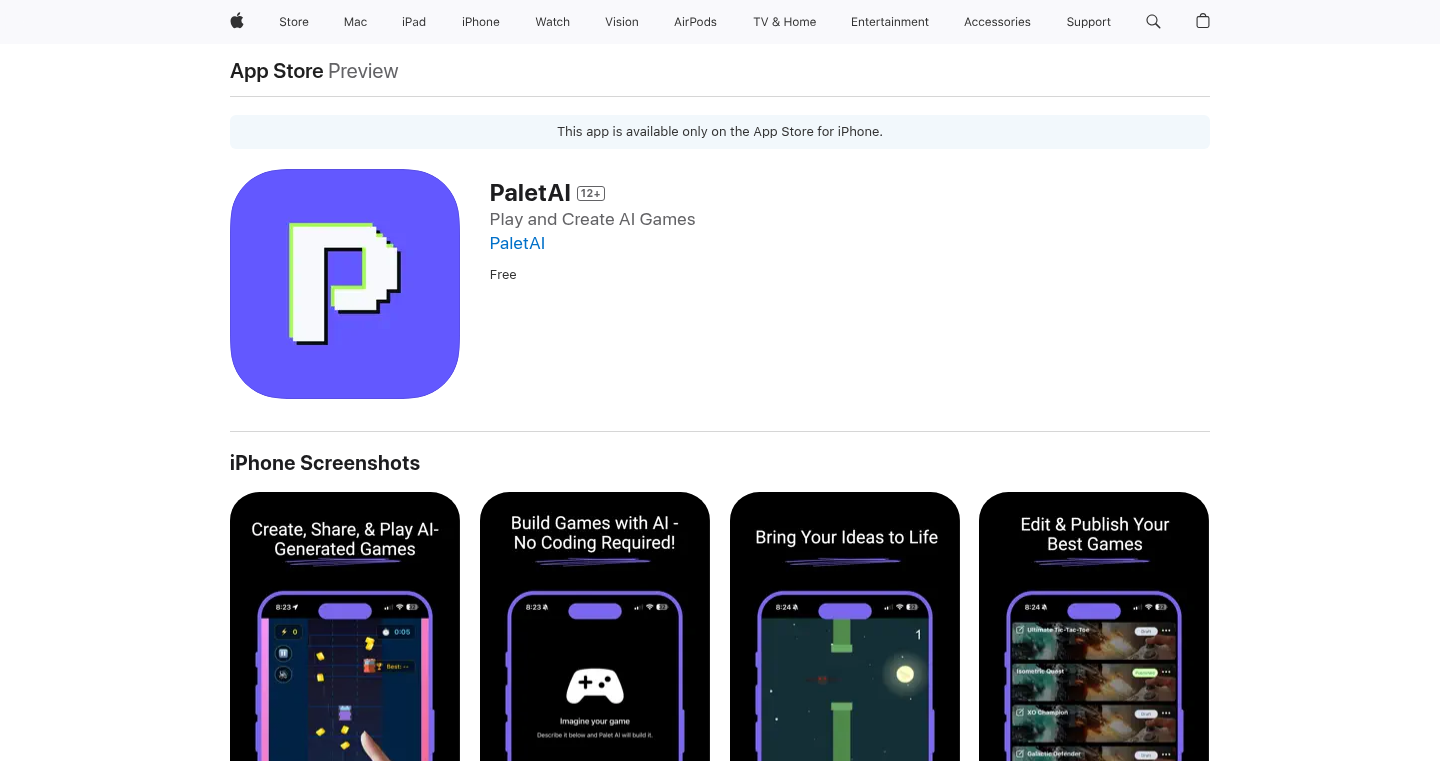
Author
tedwatson123
Description
PaletAI is a mobile application that allows users to create, play, and share AI-generated games without any coding knowledge. It leverages artificial intelligence to generate games based on user descriptions, simplifying the game development process and providing a platform for quick and easy game discovery. This addresses the common problem of 'now what?' that arises with no-code tools by providing a streamlined publishing and sharing system. It aims to reduce friction for players by offering a TikTok-style feed of casual games that can be accessed without downloads or sign-ups. So, this allows anyone to create and share games, and easily discover new ones.
Popularity
Points 4
Comments 1
What is this product?
PaletAI utilizes AI to understand user-provided game descriptions. Based on this, it automatically generates the game mechanics, visuals, and gameplay logic. The core innovation lies in abstracting away the complexities of game development through AI, enabling non-programmers to create games. The platform also includes a built-in sharing mechanism, allowing users to publish and share their games on a TikTok-style feed. So, this offers a simplified game development and sharing experience.
How to use it?
Developers can use PaletAI by simply describing the game they want to create. This description serves as the input for the AI, which then generates the game. Once the game is generated, the user can play it within the app and share it with other users. This technology could be integrated into educational settings for teaching game design, or for quick game prototyping by professional developers. So, by using a simple description, you can create and share your own games, and even rapidly prototype game ideas.
Product Core Function
· AI-Powered Game Generation: This core feature uses AI to interpret user descriptions and generate playable games. This simplifies the game development process dramatically. For example, if you describe a simple puzzle game, the AI handles the underlying code and game mechanics, creating the playable game. So, it simplifies game development.
· Simplified Publishing: Users can publish their AI-generated games directly within the app, eliminating the need for complex hosting or distribution channels. This provides a straightforward way for creators to share their games with the world. So, it makes sharing your games easy.
· TikTok-Style Game Feed: The app provides a discovery mechanism where players can swipe through a feed of games. This allows users to quickly find and play games without the friction of app stores. So, it provides quick and easy game discovery.
Product Usage Case
· Rapid Prototyping for Game Designers: A game designer can quickly generate different game prototypes based on varying concepts without needing to write code. This allows them to test game mechanics and iterate on their ideas much faster. So, you can rapidly try out game ideas.
· Educational Tool: In educational settings, students can use PaletAI to learn about game design principles without needing to learn programming. They can experiment with different game concepts and see the results immediately. So, it can be used to teach game design.
· Casual Game Development: Individuals interested in making casual games can use PaletAI to bring their ideas to life without requiring programming skills, potentially creating simple games for friends or personal enjoyment. So, anyone can quickly create and share simple games.
16
PostTwo: Self-Destructing Anonymous Board
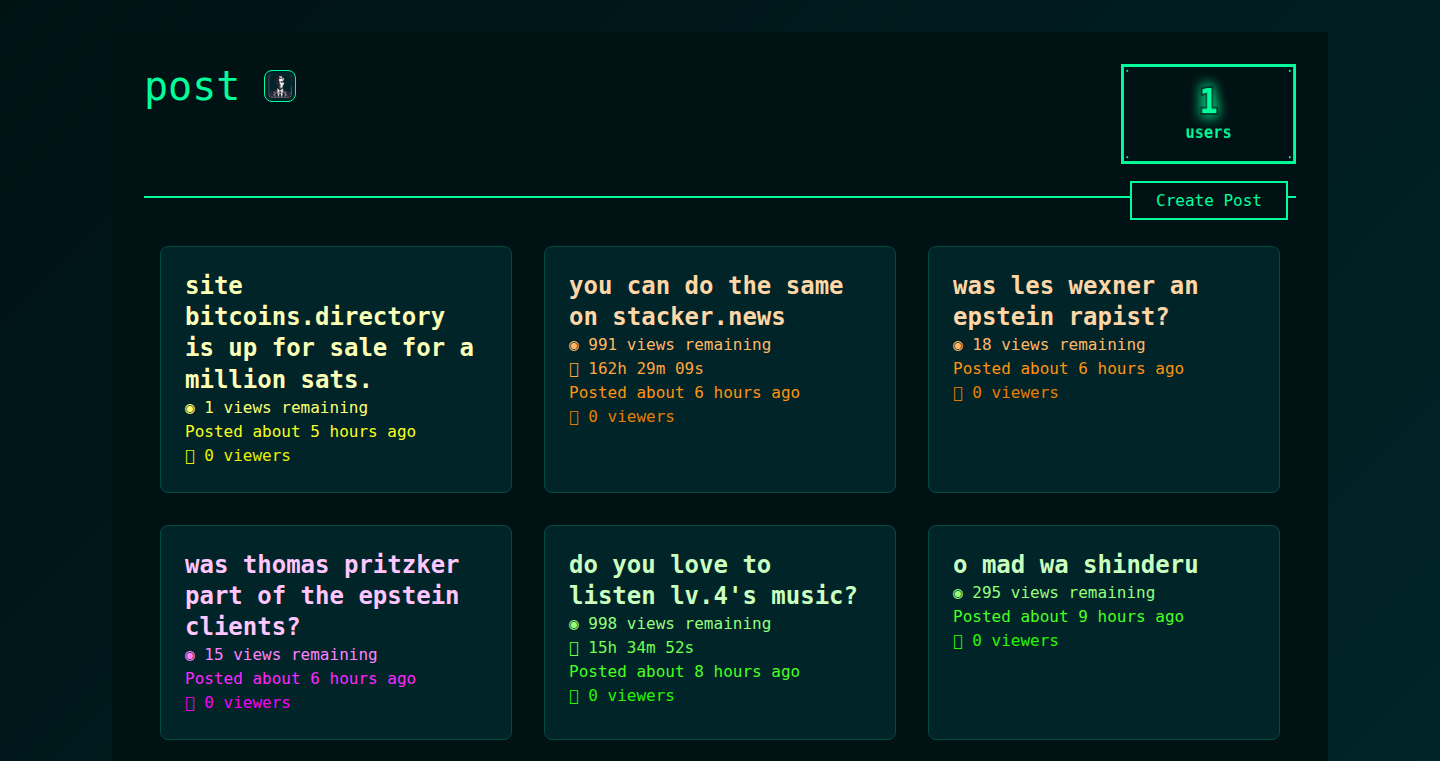
Author
tabarnacle
Description
PostTwo is a platform for anonymous posting with a unique twist: posts automatically delete themselves after a set time or a certain number of views. It addresses the need for ephemeral communication and information sharing, offering a privacy-focused alternative to traditional forums. Built with Supabase (a database service) for the backend and Svelte for the frontend, the project leverages the strengths of these technologies to provide a user-friendly and efficient experience. It offers a creative approach to content moderation and data lifecycle management, showcasing how to build dynamic and privacy-conscious web applications.
Popularity
Points 5
Comments 0
What is this product?
PostTwo is like a digital bulletin board, but with an expiration date for every post. When you create a post, you decide how long it stays visible or how many times it can be seen before it vanishes. Behind the scenes, it uses Supabase, a service that makes it easy to store and manage data (like the posts themselves), and Svelte, a modern way to build websites, for the front-end design. The innovation lies in its commitment to privacy and the clever handling of content lifecycles. So, it offers a way to share information without leaving a permanent trace – imagine posting a message that automatically disappears, protecting your identity and the information you share.
How to use it?
Developers can use PostTwo as a base for their own applications that require temporary or private communication. You could integrate it into a chat application, a feedback system, or any platform where users need to share information without it being permanently stored. It's very adaptable. Imagine using it for quick polls, announcements in a team where the info is only for a short time, or even a secure way to leave a message for someone. You'd need to get the code from GitHub and then adjust the backend to be used in your Supabase dashboard and then integrate the frontend, based on Svelte, into your design. Then, you can have your own anonymous message board!
Product Core Function
· Ephemeral Posting: The core functionality is the ability to create posts that automatically delete after a set period or a certain number of views. The value here is in its privacy-focused nature, which encourages sharing of sensitive information and opinions without fear of long-term repercussions. Application: Ideal for sharing confidential information, brainstorming sessions, or time-sensitive announcements.
· Anonymous Communication: The platform emphasizes anonymity. The value is that it permits open and uncensored communication without revealing the identity of the poster. Application: Good for whistleblowing, providing anonymous feedback, or sharing opinions on controversial topics.
· Supabase Backend Integration: Utilizing Supabase for backend operations (database, authentication). The value is the convenience and scalability provided by Supabase, which significantly reduces the effort to manage a database and related infrastructure, making the project easier to build and maintain. Application: Building web applications quickly, reducing development time and costs.
· Svelte Frontend Implementation: Leveraging Svelte for frontend development, offering a performant and efficient user interface. The value is in providing a smooth, fast, and enjoyable user experience. Application: Creating responsive and engaging web interfaces.
· Self-Destruct Mechanism: Setting the post's duration or view count before deletion. The value here allows the user control over the information lifetime. Application: Appropriate for scenarios requiring short-lived information, such as private memos, one-time codes, or short-term event details.
Product Usage Case
· Secure Feedback System: A company builds a system where employees can provide anonymous feedback on projects or management. The posts expire after a week, ensuring feedback is up-to-date and encourages open communication. This solves the problem of hesitant feedback in a traditional system.
· Time-Limited Announcements: A school uses PostTwo to announce emergency information or updates to its students, with messages disappearing after a day. The advantage is ensuring that the information is relevant and not cluttered with outdated details.
· Ephemeral Polls and Surveys: A researcher creates a survey to collect honest opinions on sensitive topics, and the responses automatically get deleted after a month. This mitigates privacy concerns for the participants.
· Short-Lived Team Communication: A team uses PostTwo to share quick updates and brainstorming ideas, understanding that these messages are intended to disappear after a brief period. The benefit is maintaining a focused and uncluttered workspace.
17
Gix: AI-Powered Git Assistant

Author
codebyagon
Description
Gix is a command-line tool that integrates artificial intelligence into your Git workflow. It's designed to help you manage Git commits more efficiently. The tool, written in Go and designed to be cross-platform, leverages your own OpenAI API key to split large changes into smaller, more manageable commits and suggest helpful commit messages. The core innovation is using AI to understand your code changes and generate contextually relevant information, improving your productivity and code quality.
Popularity
Points 4
Comments 0
What is this product?
Gix utilizes the power of AI, specifically through OpenAI's API, to analyze the changes you've made in your code. It then helps you break down extensive changes into smaller, more logical commits, each with its own descriptive commit message. This streamlines your workflow and makes your commit history easier to understand. Essentially, it automates tedious tasks related to Git, making your interaction with Git more efficient and less prone to errors. So this is useful because it saves time and improves collaboration.
How to use it?
Developers can use Gix directly from their terminal. You'll need to have Go installed and provide your own OpenAI API key. After installing Gix, you run it in your Git repository. For instance, you might run `gix split` to automatically divide a large diff into smaller commits. Or you can use `gix suggest` to generate commit messages. Integration is seamless, as Gix works directly with the Git commands you already use. So this is useful because it fits right into your existing workflow, improving productivity.
Product Core Function
· Automatic Diff Splitting: Gix can intelligently split large code changes into multiple smaller commits. It analyzes the changes and proposes logical commit boundaries. This makes code reviews easier and helps maintain a clean commit history. So this is useful because it helps keep your code history organized and easy to understand.
· AI-Powered Commit Message Suggestions: Gix uses AI to generate clear and concise commit messages based on the changes you've made. This helps ensure that your commit history is informative and provides context for future developers (including yourself). So this is useful because it saves time writing commit messages, and ensures quality commit messages.
· Cross-Platform Compatibility: The tool is written in Go, making it compatible with various operating systems. This means you can use Gix regardless of whether you're using Windows, macOS, or Linux. So this is useful because it's accessible to a wide range of developers.
· Local Execution & Privacy: Gix runs locally and uses your own OpenAI API key, providing control over your data and ensuring privacy. You don't need to upload your code to external servers. So this is useful because it offers security and control of your own data.
Product Usage Case
· Breaking Down Large Feature Branches: Imagine you've been working on a significant new feature, and the changes span multiple files. Using `gix split`, you can break this large diff into individual commits, each related to a specific aspect of the feature. This makes it much easier to review the changes. So this is useful because it simplifies collaboration and reduces the risk of introducing bugs.
· Refactoring Code: When refactoring, `gix suggest` can propose commit messages for each change you make. These messages provide context to the changes, making it easy to understand the purpose of each refactoring step. So this is useful because it improves code maintainability by helping developers understand the reason for changes.
· Improving Team Code Review: In a team environment, using Gix to create smaller, well-documented commits improves the code review process. Reviewers can easily understand the changes and provide feedback. So this is useful because it improves team communication and collaboration, reducing the time spent on code reviews.
· Maintaining Personal Projects: Even for personal projects, Gix helps in organizing your work. Clear and concise commit messages make it easier to revisit your code months later and understand what you were trying to achieve. So this is useful because it makes it easier to maintain your code and understand how you've worked on the project in the past.
18
GitVisualizer: Real-time Git Activity Visualization for VS Code
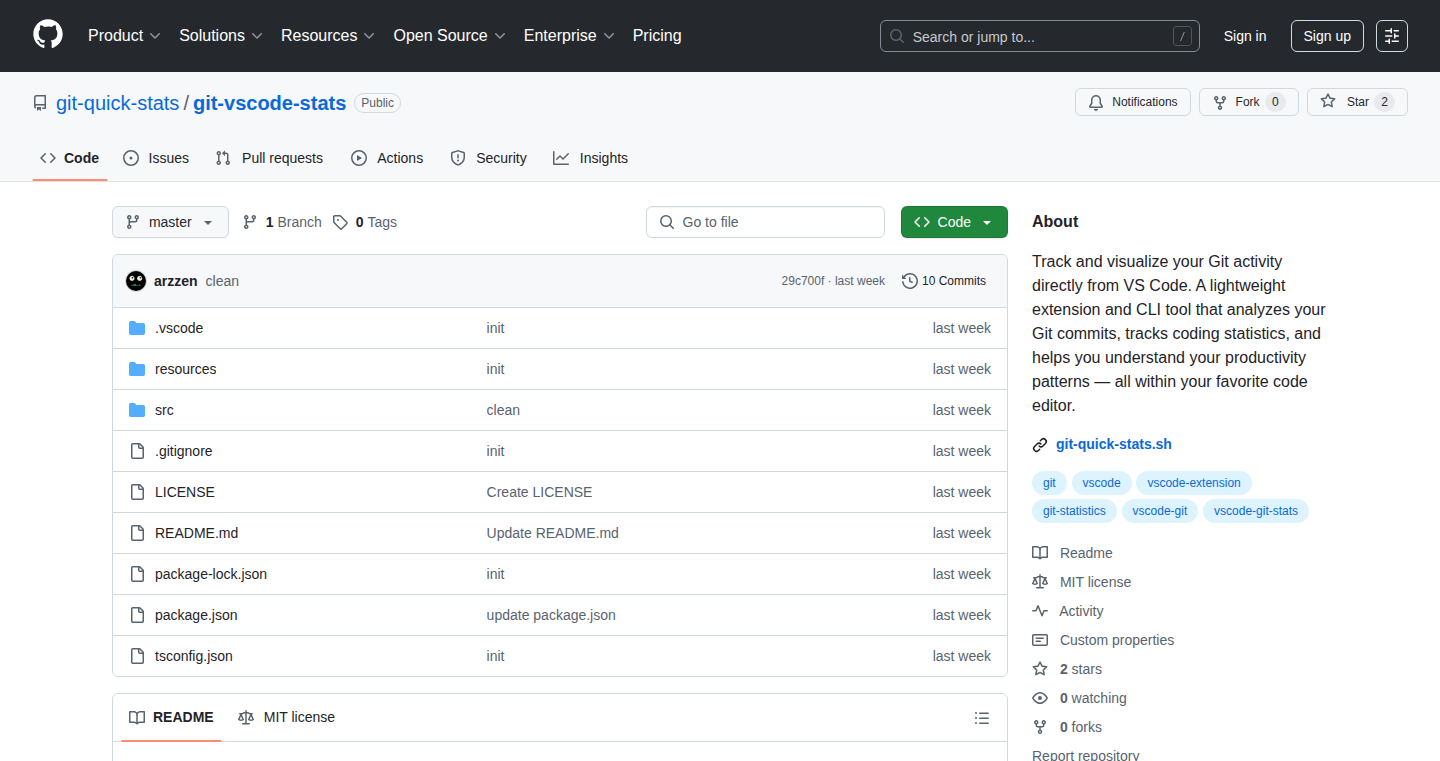
Author
beledev
Description
GitVisualizer is a VS Code extension that allows you to visualize your Git activity directly within the editor. It tackles the common problem of understanding your project's history and evolution at a glance, moving beyond the limitations of text-based Git logs. The core innovation lies in its ability to translate Git commands into interactive visual representations, making it easier to grasp complex branching, merging, and commit patterns. This helps developers better understand project history and collaborate more effectively.
Popularity
Points 4
Comments 0
What is this product?
GitVisualizer transforms your Git activity into a visual map right inside VS Code. Instead of just seeing lines of text in your Git logs, you get a graphical representation of branches, merges, and commits. This is achieved by parsing the output of Git commands and rendering them as an interactive graph. The key innovation is bringing a visual approach to understand the project's history, allowing developers to quickly grasp the relationships between different parts of the code and the history of changes, instead of reading complex text logs. So this is useful for understanding the evolution of your project and seeing how different changes fit together.
How to use it?
Developers can install the GitVisualizer extension in their VS Code. Once activated, it runs in the background, parsing your Git repository and displaying the visual representation of your Git activity. You can interact with the visual graph, explore commits, branches, and merges, and even trigger Git actions like branching or merging directly from the visual interface. So you can use this to quickly understand your project's history, diagnose issues, and collaborate with others more efficiently. It can integrate into your existing workflow within VS Code.
Product Core Function
· Interactive Git Graph: This allows developers to see a visual representation of their Git repository's history. It renders branches, commits, and merges as nodes and connections in a graph. So this helps you understand the project's history at a glance.
· Real-time Updates: The visualization updates automatically as you make changes to your Git repository. So the information is always up-to-date, reflecting the latest state of your project.
· Commit Details on Hover: When you hover over a commit in the visual graph, you can see detailed information about that commit, like the author, commit message, and the files that were changed. So you can quickly get the necessary information about a particular change.
· Interactive Branch Management: Allows you to create, switch, merge, and delete branches directly from the visual interface. So you can manipulate your repository branches with a visual tool.
· Integration with VS Code: The extension integrates seamlessly into VS Code, providing an intuitive and accessible way to visualize your Git activity without leaving your development environment. So you can work within your familiar environment and minimize context switching.
Product Usage Case
· Understanding Branching Strategies: Developers can use GitVisualizer to understand how a team is using different branching strategies. By visually inspecting the graph, they can easily see the relationships between feature branches, release branches, and the main branch. So you can quickly understand how different teams are developing.
· Debugging Merge Conflicts: When encountering merge conflicts, developers can use GitVisualizer to visually compare the conflicting branches and identify the source of the conflicts. The visual representation highlights the divergent changes, making it easier to pinpoint the problematic areas. So you can simplify merge conflict resolution.
· Reviewing Code Changes: Developers can use GitVisualizer to review the changes introduced by a pull request or commit. By inspecting the visual graph, they can see the context of the changes within the broader project history. So you can understand the context of the changes being made.
· Training and Onboarding: When onboarding new team members, GitVisualizer can be a valuable tool for introducing them to the project's history and branching structure. The visual representation makes it easier for newcomers to grasp the project's evolution and understand the relationships between different parts of the codebase. So you can speed up onboarding new developers.
· Complex Project Visualization: For projects with complex branching and merging patterns, GitVisualizer provides a more intuitive and accessible way to navigate and understand the project's history than traditional text-based Git logs. So you can easily manage and navigate complex projects.
19
HeadshotGen: AI-Powered Professional Headshot Generator
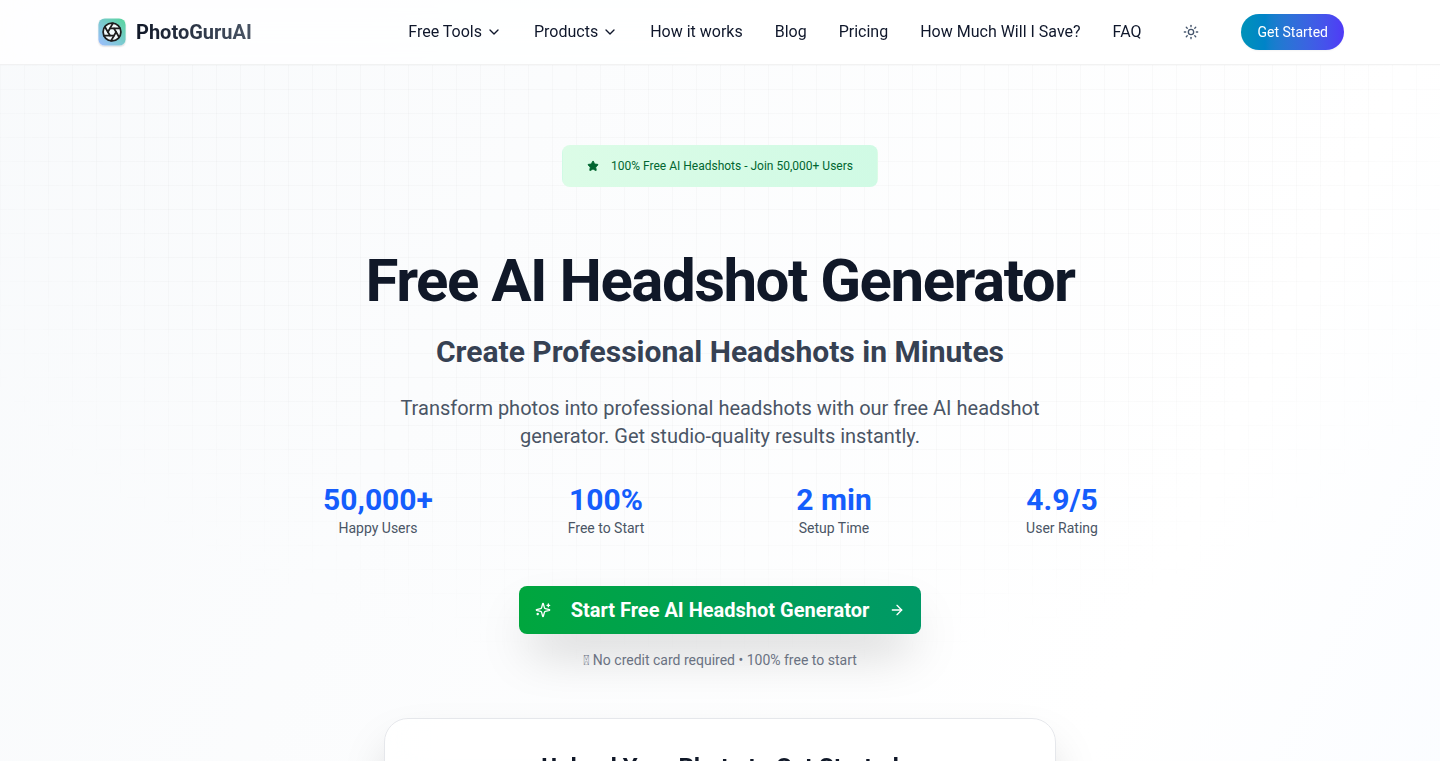
Author
devhe4d
Description
HeadshotGen is a free, simple application that leverages artificial intelligence to generate professional headshots from a single user-provided photo. The core innovation lies in its ability to transform a casual picture into a polished, professional image suitable for resumes, LinkedIn profiles, and other professional uses. It solves the common problem of needing a professional headshot without the expense or time commitment of a photoshoot.
Popularity
Points 3
Comments 1
What is this product?
HeadshotGen uses AI, specifically a type of AI called a Generative Adversarial Network (GAN). GANs work by having two parts: a generator that creates new images, and a discriminator that tries to tell the real images from the generated ones. In this case, the generator creates different headshot styles from a user's input photo, while the discriminator tries to identify whether they look realistic. Through this process, the AI learns to create convincing and professional-looking headshots. So, this is a tool that lets you create a professional headshot easily and cheaply, without having to go to a photographer.
How to use it?
Developers can use HeadshotGen to integrate headshot generation into their applications or services. The user uploads a photo, and the application processes the photo using the AI. The output is a selection of professional-looking headshots. This could be used in job application portals, social media profile builders, or any service where a professional image is beneficial. For instance, you could embed the functionality into a recruitment platform. So, you can add a feature that lets users quickly and affordably create professional headshots directly within your application.
Product Core Function
· AI-Powered Headshot Generation: Uses GANs to transform a user's photo into a professional headshot. This saves time and money compared to traditional photography. It's useful because it provides an accessible way for anyone to get a professional image.
· Style Customization (Implied): While the specific styles aren't detailed, the application implies the ability to offer different professional styles. This provides users with choice and flexibility in how their headshot looks. This is valuable because it lets users match their headshot to the specific industry or style they prefer.
· Free and Accessible: Offers the headshot generation service for free. This removes the financial barrier to entry for users. This is important as it makes professional-looking headshots accessible to a wider audience.
· Simple User Interface: It is easy to use, likely with a straightforward process of uploading a photo and receiving the output. This simplifies the user experience. This is great because it allows for a quick and easy headshot creation process.
Product Usage Case
· Job Application Integration: Integrate HeadshotGen into a job application platform. Users can upload their existing photo and generate a professional headshot directly within the application, saving them time and improving their profile. So, if you are building a platform for job applications, this would be a great add-on for your users.
· Social Media Profile Enhancement: A social media platform could integrate HeadshotGen to help users create professional profile pictures, improving their online presence. This is especially useful for LinkedIn or other professional networking sites. So, if you're running a social network, you can improve your users' experience and give them a reason to visit your site more often.
· Resume Builder Enhancement: A resume builder could use HeadshotGen to allow users to quickly create professional headshots to include in their resumes, making them look more polished. So, you can make resumes look more professional and thus improve users' chances of landing an interview.
20
Daily AI Times: Automated AI-Powered News Summarization
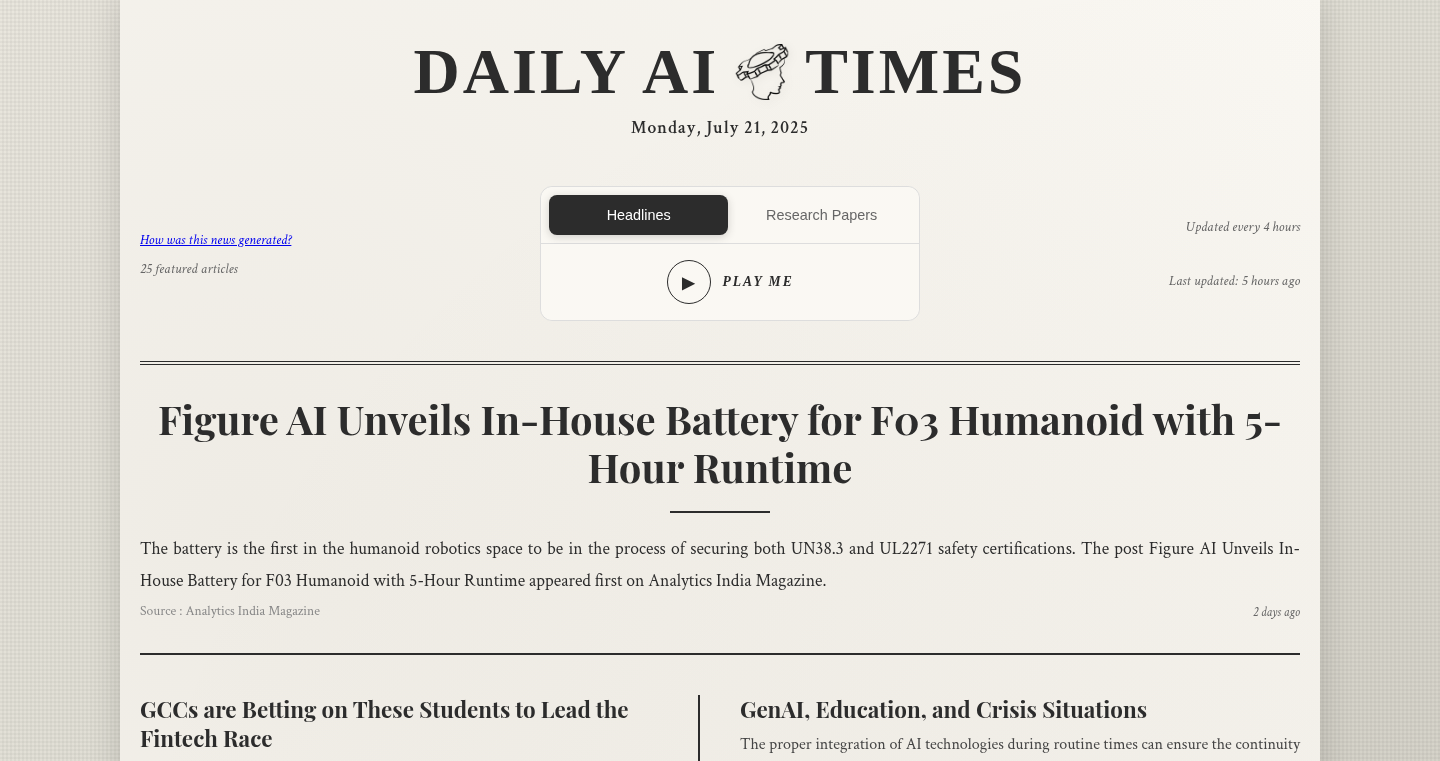
Author
SiddanthEmani
Description
Daily AI Times is a project that automatically summarizes news articles using artificial intelligence. It addresses the problem of information overload by providing concise summaries, allowing users to quickly grasp the key points of multiple news sources. The core innovation lies in its automated approach to extracting and synthesizing information, potentially saving users significant time and effort. This project showcases how developers can leverage AI to build tools that curate and present information in a more accessible format.
Popularity
Points 3
Comments 1
What is this product?
This project uses AI to read news articles from different sources and create short summaries. It uses techniques like Natural Language Processing (NLP) and machine learning models to understand the meaning of articles and pick out the most important information. So the innovation is that it automatically gathers and presents key information, like having a smart assistant that reads the news for you.
How to use it?
Developers can use this project to build their own news aggregation tools or integrate AI-powered summarization into existing applications. You could feed it a list of news article URLs, or integrate it into your existing news feeds. For example, a developer might use it to build a personalized news dashboard or add a 'summarize' button to a news reading app. So, you can save time and make it easier to follow news you care about.
Product Core Function
· Automated News Extraction: This function automatically fetches news articles from specified URLs, eliminating the need for manual data input. This can be incredibly useful for building automated news readers or providing users with a quick overview of multiple news sources. So, it automates the tedious process of gathering news content.
· AI-Powered Summarization: The project utilizes AI to generate concise summaries of news articles. It analyzes the content and extracts the most important information, presenting it in a condensed format. This feature helps users quickly grasp the main points of an article without having to read the entire text. So, it helps you get the gist of an article quickly.
· Multi-Source Aggregation: It can gather news articles from different sources, allowing users to stay informed about multiple topics from different news outlets in one place. This is essential for users who prefer to be informed of information from different perspectives. So, it gathers news from various sources for a comprehensive overview.
· Topic-Specific Filtering (potential future feature): Although not explicitly mentioned in the project description, a potential future implementation could involve filtering and summarizing news based on specific topics. This would allow users to focus on news relevant to their interests. So, it can tailor news content to your interests.
Product Usage Case
· Building a Personalized News Dashboard: A developer could use the project to create a dashboard that summarizes news articles based on the user's interests. This would provide a quick and efficient way for users to stay informed about the topics that matter most to them. For developers, it means building something useful for users.
· Enhancing News Reading Applications: The summarization feature could be integrated into existing news reading applications, allowing users to easily generate summaries of articles they are reading. This would be a great addition to help users easily digest information. So it can make existing apps more helpful.
· Creating Automated Newsletters: The project could be used to generate automated newsletters that summarize the day's top news stories. The developer could customize it based on preferred interests. So, it is useful for a time-saving newsletter.
21
Kara Auto Translate: AI-Powered English to ASL Video Translation
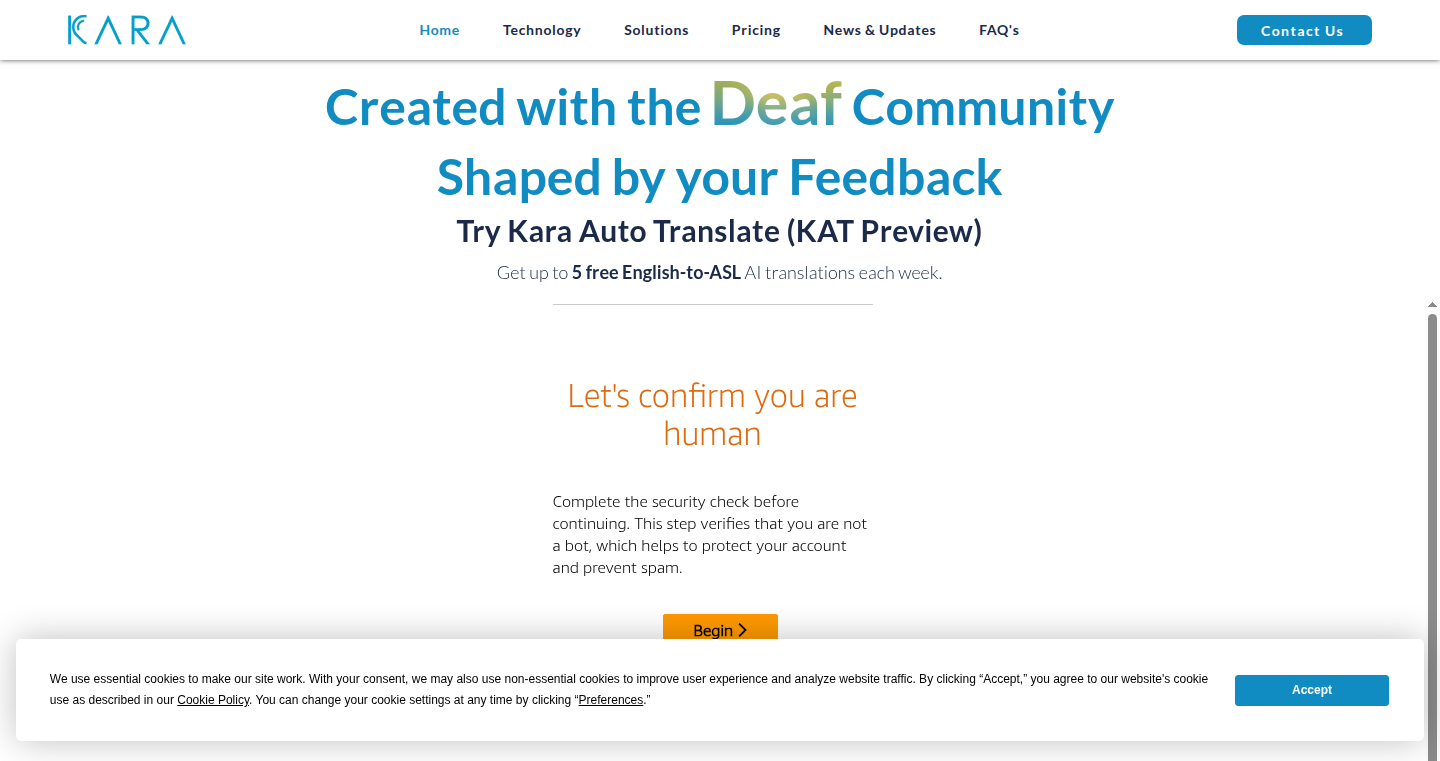
Author
ffarhour
Description
Kara Auto Translate (KAT) is an AI tool that converts English text into American Sign Language (ASL) video. It addresses the challenge of making information accessible to the Deaf community by automating the translation process. The core innovation lies in its custom 'Kara Notation System' (KNS), which captures the nuances of ASL grammar and structure. The KNS then drives an animation engine to generate accurate and natural sign language motions, all delivered as a video output without requiring downloads or installations. So this allows people who use ASL to quickly and easily understand English text.
Popularity
Points 2
Comments 2
What is this product?
This project uses AI to translate English text into ASL videos. It works by first converting the English text into a special format called the Kara Notation System (KNS). Think of KNS as a blueprint of ASL, capturing the sentence structure and grammar of sign language. Then, using this blueprint, an AI animation engine creates a video of a virtual avatar signing the translated text. So this helps in making information and content accessible to the Deaf community.
How to use it?
Developers can utilize KAT to integrate ASL translations into their applications or websites. They would simply input English text into the KAT system, and the output, an ASL video, can then be embedded or displayed. For example, a website providing instructions could use KAT to provide an ASL version of the instructions alongside the English text. So this will allow developers to make their content and services accessible to a wider audience.
Product Core Function
· English to Kara Notation System (KNS) Conversion: This is the first step, where English text is translated into a structured format that represents ASL. This format is critical for accurately capturing ASL grammar and semantics. This means that the AI understands the sentence structure of ASL, allowing for more accurate translations.
· KNS to Avatar Animation: This core function translates the KNS format into animated ASL. The animation engine generates realistic sign language motions, creating a visual representation of the text. This brings the ASL to life visually, allowing viewers to easily understand the content.
· Video Output: The final step is generating the ASL video. This allows users to view the translated content directly without needing to install any software. This allows for a very quick and simple user experience.
Product Usage Case
· Website Accessibility: A news website can use KAT to automatically provide an ASL version of its articles, ensuring that Deaf users can access the content. This expands audience reach and improves user experience.
· Educational Content: Teachers and educators can use KAT to create ASL videos for educational materials, providing greater accessibility to students who use sign language. This ensures that educational materials are available to everyone.
· Customer Service: Companies can integrate KAT into their customer service platforms to offer ASL support for their customers. This improves customer satisfaction for Deaf customers.
· Application Development: Developers can use the technology to make their applications accessible by incorporating ASL support into their apps. This allows them to offer a better user experience for a wider audience.
22
Benchstreet: Financial Time Series Forecasting Benchmark
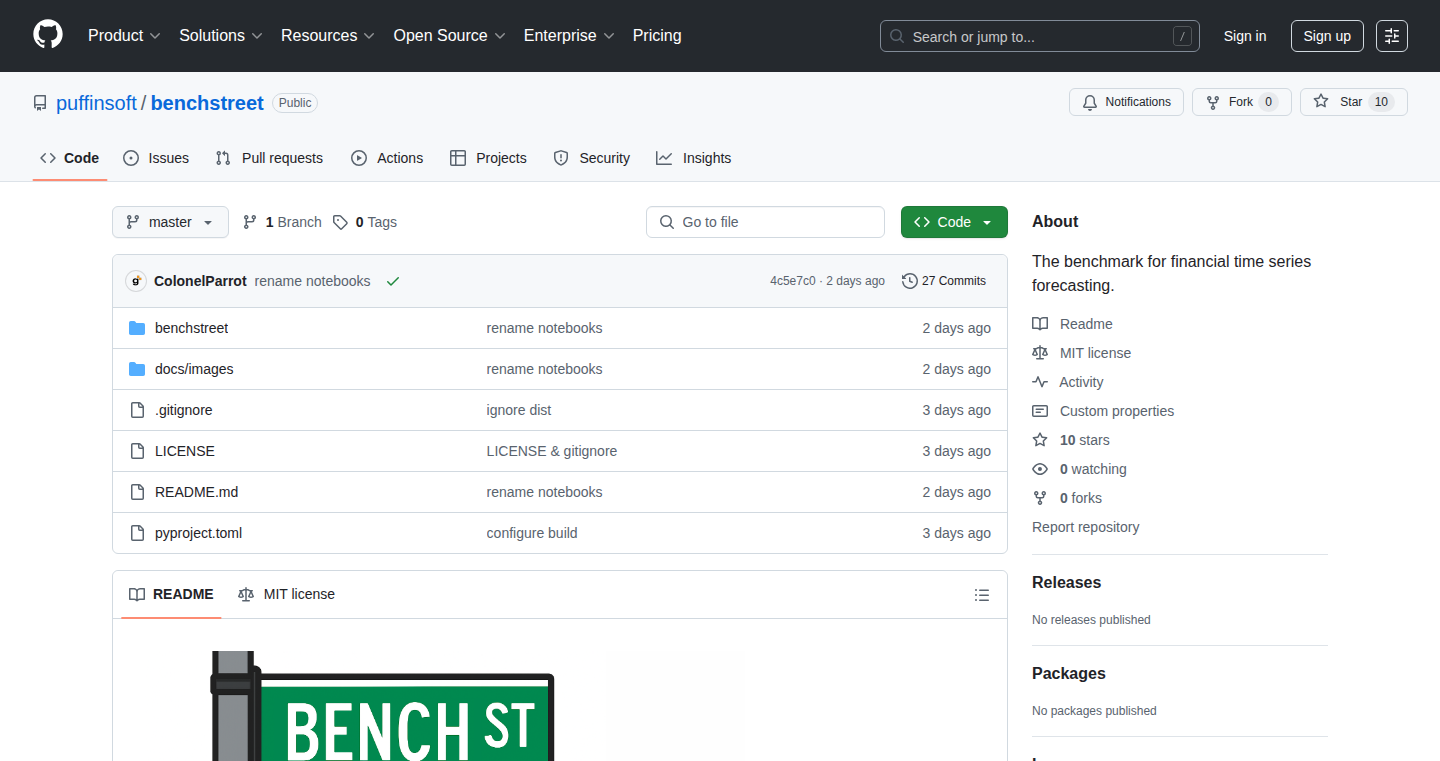
Author
ColonelParrot
Description
Benchstreet is a platform that provides a standardized benchmark for evaluating and comparing different time series forecasting models, specifically for financial data. It tackles the challenge of assessing the effectiveness of forecasting models in the finance domain. This is achieved by offering a consistent framework with a set of pre-defined datasets and evaluation metrics, allowing researchers and practitioners to objectively judge model performance. The innovation lies in its focus on financial time series and its attempt to create a level playing field for evaluating forecasting techniques. This solves the significant problem of inconsistent model evaluation, promoting more reliable and comparable results in financial forecasting.
Popularity
Points 3
Comments 0
What is this product?
Benchstreet is essentially a leaderboard for financial forecasting models. It provides a standardized way to test and compare how well different models can predict future financial data, like stock prices or market trends. The core idea is to ensure everyone uses the same datasets and performance measures, making it easy to see which models are truly the best. It’s like a race where everyone starts from the same starting line and runs on the same track. This ensures that the results are comparable and that we can objectively assess model effectiveness. The innovative part lies in the focus on the finance world, ensuring that models are fit for purpose in a tricky domain.
How to use it?
Developers can use Benchstreet by submitting their forecasting models and seeing how they perform against a benchmark. The platform offers access to benchmark datasets and provides metrics to analyze the performance of models in comparison to others. The models are likely submitted by API calls or uploaded via standard protocols, allowing for easy integration into existing model training and evaluation workflows. This means, if you have a forecasting model for stock prices, you can submit it, and Benchstreet will automatically tell you how well it performs relative to other models. It's a crucial tool for researchers and developers to improve the accuracy and reliability of financial forecasting models.
Product Core Function
· Standardized Datasets: Benchstreet provides pre-defined financial datasets for testing. This is important because it ensures all models are evaluated using the same input data, enabling a fair comparison. (So what? This means developers don't have to spend time and effort sourcing their own data, speeding up the model development process and ensuring consistency.)
· Evaluation Metrics: It offers a consistent set of evaluation metrics, like Mean Absolute Error (MAE) and Root Mean Squared Error (RMSE), to assess model performance. This enables objective comparison of the forecasting accuracy. (So what? It enables fair comparison and helps developers to understand which model performs best according to specific criteria, leading to better decision-making in the finance domain.)
· Benchmarking Framework: The platform provides a structured framework for submitting, evaluating, and comparing forecasting models. This fosters a competitive environment and encourages innovation in forecasting techniques. (So what? It creates a clear and standardized process for improving the efficiency and accuracy of financial forecasting models, ultimately leading to better predictions and informed financial decisions.)
· Model Submission and Ranking: Benchstreet allows users to submit their models and see them ranked based on performance. This gamified approach encourages continuous improvement and allows the financial community to access the best performing models. (So what? This creates a transparent ranking system that allows developers and researchers to clearly see the performance of different models against each other, fostering healthy competition, and leading to improvements in the financial forecasting space.)
Product Usage Case
· Developing a Stock Prediction Model: A data scientist develops a new stock price prediction model. They can submit their model to Benchstreet and compare its performance against established forecasting methods using the provided datasets and metrics. (So what? This allows the data scientist to quickly see if their model is genuinely better and identify areas for improvement based on the benchmark results.)
· Evaluating a Market Trend Forecasting Algorithm: A hedge fund is testing a new algorithm to predict market trends. They use Benchstreet to evaluate the algorithm's accuracy and compare it to other models. (So what? This helps the hedge fund make informed decisions about adopting the algorithm and assess its potential profitability.)
· Comparing Different Time Series Forecasting Techniques: A research group is investigating the performance of different time series techniques. They use Benchstreet's datasets and metrics to compare techniques like ARIMA, LSTM, and Prophet. (So what? This helps the research group understand the strengths and weaknesses of various techniques and find the best approach for their specific financial forecasting needs.)
23
Mirage: Live Localhost Sharing with Terminal-Based Feedback
Author
harvansh
Description
Mirage is a developer-focused command-line interface (CLI) tool that instantly shares your local development environment with clients, allowing them to provide real-time feedback directly on the live UI. It streamlines the feedback process by integrating a client feedback widget and real-time updates, eliminating the need for staging servers and lengthy deployments. The core innovation lies in its ability to capture client feedback directly on UI elements, displaying comments and facilitating replies within the developer's terminal. So, it makes the feedback loop faster and more efficient for web development.
Popularity
Points 3
Comments 0
What is this product?
Mirage is a CLI tool that lets developers share their local development environment instantly. It uses local tunneling (similar to ngrok) to make your localhost accessible online. The innovation is in its integration of a feedback mechanism. When a client views the shared development environment, they can click on UI elements and leave comments directly. These comments appear in the developer's terminal, and the developer can reply directly from the terminal. The magic happens through a custom DOM overlay that captures feedback and real-time synchronization that allows for immediate display of code changes. So, it removes the friction in getting feedback from your clients on your local development environment.
How to use it?
Developers start Mirage in their project folder, which generates a shareable link. They send this link to their clients. Clients open the link and see the live UI running on the developer's localhost. Clients can then click on UI elements and provide comments. These comments appear in the developer's terminal. Developers can reply to the comments directly from the terminal, and any code changes are instantly reflected on the client's side. So, developers can share their local development environment with clients and receive real-time feedback through the terminal, enhancing development and communication.
Product Core Function
· Instant Localhost Sharing: Mirage uses tunneling technology to make your local development environment accessible online via a shareable link. This is crucial for sharing work in progress. So, it allows easy access to the local environment.
· Real-time Feedback Widget: Clients can click on any UI element and leave comments. This widget is integrated directly into the shared UI. So, it gives a direct way to collect feedback on the UI.
· Terminal-Based Comment Display and Reply: Comments from clients are displayed directly in the developer's terminal. Developers can reply to these comments right from the terminal. This tightens the feedback loop. So, developers can communicate with clients through the terminal instead of switching between different tools.
· Real-time Updates: Any code changes made by the developer are instantly reflected on the client's side, eliminating the need to redeploy or refresh. So, clients see the most updated version instantly.
· Custom DOM Overlay for Feedback Capture: Mirage implements a custom DOM overlay to capture client feedback on UI elements. This overlay is key for identifying and commenting on specific parts of the UI. So, it allows targeted comments on the UI.
Product Usage Case
· Freelance Web Development: A freelance developer is building a website for a client. Instead of sending screenshots or video recordings, the developer uses Mirage to share the live development version. The client can click elements and leave comments, and the developer sees feedback in the terminal and makes changes on the fly. This eliminates the need for staging servers and speeds up the feedback process. So, it helps freelancers improve their communication and workflow.
· Rapid Prototyping: An indie hacker is creating a new web application and wants to gather quick feedback. They use Mirage to share the local development environment with a group of testers. Testers provide direct feedback on the UI, and the developer can immediately address the feedback. This is used for gathering early feedback and iterating quickly. So, it allows for quick iterations and fast development.
· Agency Development: An agency is managing several client projects that require frequent reviews. The development team uses Mirage to share builds with their clients. Clients leave feedback directly on the UI, and the developers receive these comments in their terminal. This streamlined workflow is used to reduce the number of review cycles. So, it ensures better client collaboration and faster project completion.
24
Flowgen: Type-Safe Error Handling with Generators
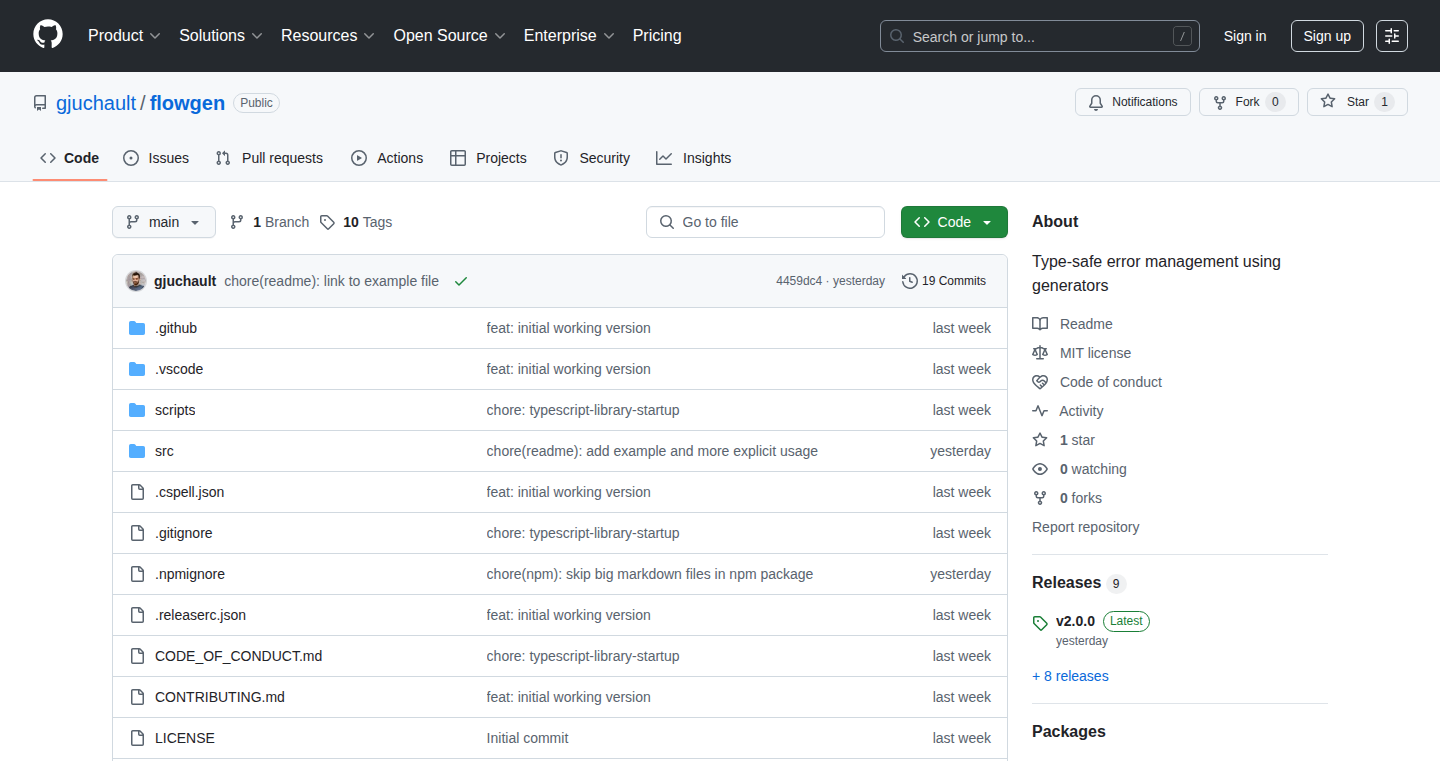
Author
gjuchault
Description
Flowgen is a project that leverages JavaScript generators to create a type-safe and elegant way to handle errors in your code. It moves away from traditional try-catch blocks, which can be verbose and difficult to reason about, and instead uses generators to model the flow of your program, allowing you to explicitly define how errors are handled at each step. The core innovation lies in combining generators (which allow pausing and resuming code execution) with TypeScript's type system to ensure that errors are handled correctly and predictably. This eliminates the common pitfall of unhandled exceptions and makes error management much more manageable and less error-prone.
Popularity
Points 3
Comments 0
What is this product?
Flowgen uses JavaScript generators, which are like special functions that can pause and resume their execution. By combining this with TypeScript (which provides type safety), Flowgen lets developers define how errors should be handled at each stage of their code's execution. Instead of the messy try-catch blocks, you'll use generators to lay out your code's flow, making it clear how errors are managed. This is like having a roadmap for your errors, ensuring they don't get missed or mishandled. So this is a cleaner, safer way to deal with potential problems in your program, and allows for better code maintainability.
How to use it?
Developers would integrate Flowgen by defining 'flows' using generator functions. These functions yield values (like results or potential errors) and then, depending on what is yielded, Flowgen's system will handle the next steps. You’d use it in scenarios where you have a sequence of operations that could fail, such as network requests, file reads/writes, or calculations that might result in division by zero. For example, you might define a generator function that tries to fetch data from an API. If the fetch fails, the generator would yield an error, which Flowgen would then know how to handle (e.g., retry the request, log the error, or display an error message to the user).
Product Core Function
· Type-safe error propagation: Flowgen leverages TypeScript to enforce type safety, meaning the system knows the possible types of errors that can occur and ensures they are handled correctly. This prevents unexpected errors and makes debugging easier. Useful for building reliable applications where data integrity is crucial. So this ensures that the errors are the kind you expect.
· Simplified error handling flow: The use of generators provides a clean way to structure error handling, avoiding nested try-catch blocks. This makes the code more readable and maintainable. Great for complex applications where many different operations are needed, each susceptible to failure. So you can understand and modify your code more easily.
· Customizable error handling logic: Developers can define exactly how to handle errors within the generator functions. This allows for tailored responses based on the specific error encountered. Very useful for building robust API clients or command-line tools that deal with various kinds of input. So you can tailor the way errors are processed.
· Improved code readability: Generator-based error handling makes the code flow easier to follow compared to complex exception handling schemes. The sequence of operations, including error handling steps, becomes clearer. This is invaluable in large projects where team members need to understand and work on the code base. So this can make your code less complex, more friendly for others and make it less of a chore to work with.
Product Usage Case
· API Client Development: When developing an API client, Flowgen can be used to handle potential network errors. For example, if a request fails due to network issues, the generator can automatically retry the request a certain number of times or switch to a fallback server. This enhances the client’s resilience and reliability. So, for developers creating apps that work with other systems, this makes the apps less likely to break.
· File Processing: In applications that process files, such as image processing or document conversion, Flowgen can handle file-related errors (e.g., invalid file format, corrupted files). The generator can provide a fallback strategy, such as using a default image or skipping corrupted data. This improves the user experience by minimizing the impact of file errors. So, for those who process images, documents, or other kinds of files, this makes your programs less error-prone.
· Database Operations: Flowgen can be used to manage database connection errors, ensuring that the application gracefully handles situations where a database connection is unavailable or times out. If a connection failure occurs, the generator can attempt to re-establish the connection or notify the user. This is for any situation where you use a database in your code. So, for any software that uses a database, this can make your database connections more reliable and handle errors automatically.
· Asynchronous Operations: Flowgen excels in scenarios involving asynchronous tasks, such as fetching data from multiple sources or performing background processing. It makes it easier to manage errors in each step of these asynchronous flows, ensuring all operations are executed in the correct order. If you are doing something in the background while other stuff is running, this helps make the background tasks run smoothly and properly.
25
GitHub Semantic Search MCP Server
Author
wwdmaxwell
Description
This project allows you to search within your private GitHub repositories using advanced semantic search, powered by Retrieval-Augmented Generation (RAG). It solves the problem of easily accessing the most up-to-date information from private codebases, which can be frustrating when needing to add external libraries or APIs as context for your code editors. It indexes your GitHub repository using Cloudflare Workflows, enabling you to perform intelligent searches that understand the meaning of your code. This is a great approach for those who want to keep their codebase private while still leveraging powerful search capabilities. So this lets you find code even if you don't know the exact keywords.
Popularity
Points 3
Comments 0
What is this product?
This project sets up a remote MCP server that allows you to search a GitHub repository. The core innovation is the use of RAG and semantic search. It indexes your code and then uses this index to understand the meaning of your code when you search, going beyond simple keyword matching. Think of it like teaching your search engine to 'understand' the code. It avoids the limitations of GitHub's public search, especially for private repositories. The backend utilizes Cloudflare Workflows for the indexing process and offers a deployment guide, allowing teams to manage and leverage their private codebases. So this provides a smarter way to search and understand your code.
How to use it?
Developers can use this project by deploying the MCP server and pointing it to their private GitHub repository. Then they can use the server to query the codebase, using natural language to find the desired code snippets or information. You can integrate it with your IDE (like Cursor, as the original author did) to improve your coding experience. You can feed the results into your code editor to automatically understand your own code. So you can search your code more efficiently and get better results.
Product Core Function
· GitHub Repository Indexing: This feature indexes your private GitHub repository using Cloudflare Workflows. Value: This allows the system to 'understand' your code. Application: Useful for creating a searchable database of your codebase.
· Semantic Search with RAG: The server uses RAG to provide semantic search capabilities. Value: It understands the meaning behind your search queries. Application: Improves the relevance of search results, allowing users to find code snippets without knowing the exact keywords.
· Remote MCP Server: Hosts a remote MCP server to facilitate RAG queries. Value: Enables querying of your codebase from different tools. Application: Integrates with IDEs, providing a code search that understands the meaning, not just keywords.
· Deployment Guide: The project includes deployment instructions using Cloudflare Workflows. Value: Easy to deploy and maintain your own instance. Application: Gives developers the ability to set up this powerful search tool for their private repositories.
Product Usage Case
· Code Navigation and Understanding: A developer is working on a new feature and needs to understand how a specific API is used in their private codebase. The developer can use the MCP server to search using natural language, like 'how to handle errors with this API' and receive relevant code examples. So this helps you understand and reuse code.
· Knowledge Base for Internal Libraries: A company has created a library with complex functionality. The project can index the library's code and documentation, allowing developers to use natural language searches to understand the library's use. So this lets you easily find the correct code and functions for internal use.
· Integrating with Code Editors: A developer utilizes the MCP server with a code editor, such as Cursor. When asking a question about a particular function, the editor can draw on the search results from the MCP server to generate accurate code suggestions and completion hints. So this dramatically speeds up the coding process.
· Cross-Repository Search: For developers working across multiple related GitHub repositories. The MCP server could be configured to index and search across these repositories, providing unified search capabilities. So this lets you manage and find code across all related repos.
26
NeovimColorSchemeTurbo: Instant Color Scheme Switcher for Neovim
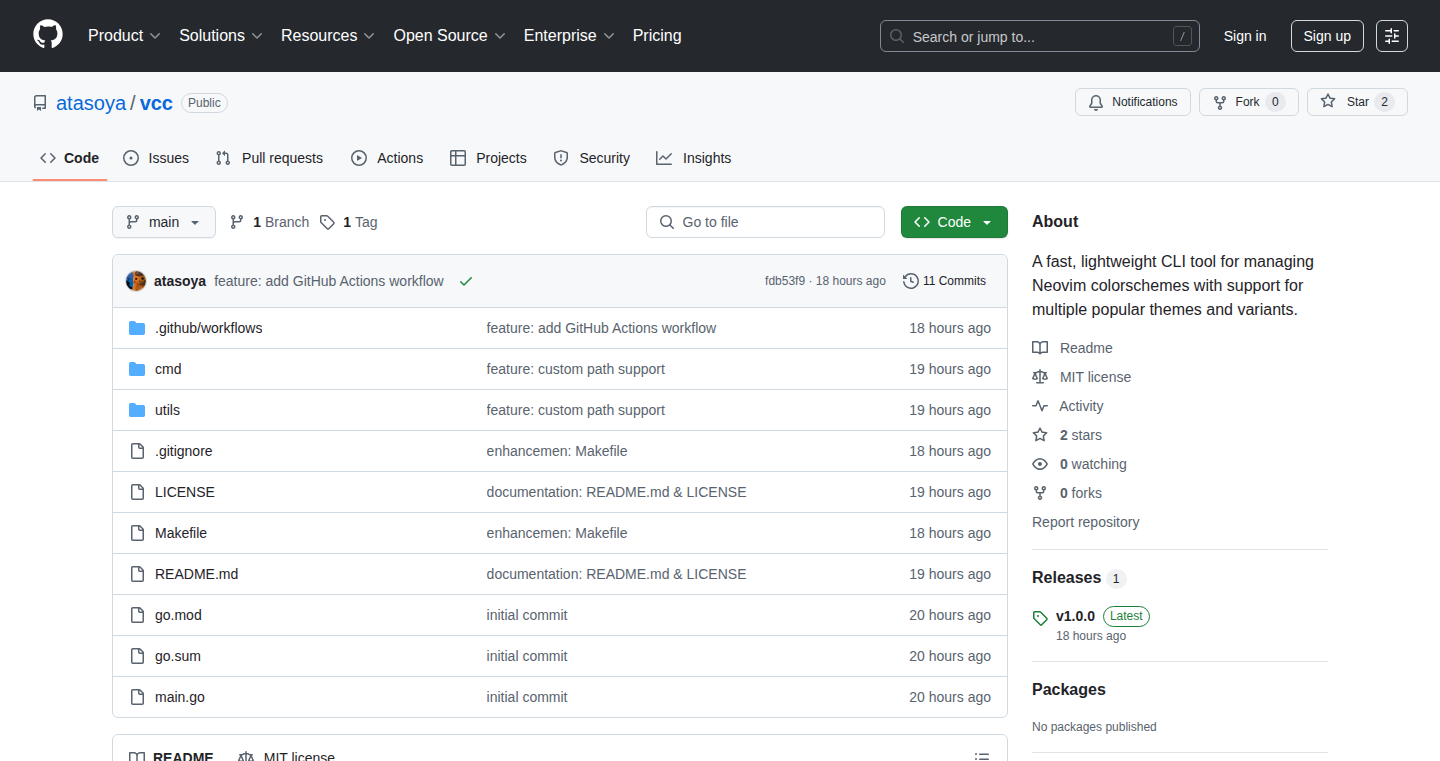
Author
ata11ata
Description
This project is a command-line interface (CLI) tool designed to drastically speed up the process of changing color schemes in the Neovim text editor. It addresses the common issue of lag when switching themes, especially in environments with a large number of colorschemes or complex configurations. The core innovation lies in its optimized loading mechanism, likely involving caching and pre-compilation techniques, to achieve near-instant theme changes. This is a practical solution for developers who frequently experiment with different color palettes to find the optimal visual environment for coding.
Popularity
Points 3
Comments 0
What is this product?
NeovimColorSchemeTurbo is a CLI tool that makes switching color schemes in Neovim incredibly fast. Traditionally, changing themes can take a noticeable amount of time. This tool utilizes clever techniques (probably caching and pre-compilation) to load the color scheme information quickly, essentially eliminating the lag. So you can switch between different color palettes in an instant.
How to use it?
Developers use NeovimColorSchemeTurbo via the command line. You'd typically install it, configure it, and then use a simple command (like `ncs-switch <scheme_name>`) to activate a specific color scheme within Neovim. This tool is designed to integrate directly with the Neovim setup, letting developers seamlessly swap themes without interrupting their workflow.
Product Core Function
· Instant Color Scheme Switching: The core function is the ability to switch color schemes almost instantaneously. This is achieved through optimized loading of color scheme definitions. This dramatically speeds up your development workflow, allowing you to quickly test and adopt different visual styles.
· Command-Line Interface (CLI): The tool is a CLI, meaning it's controlled through text commands in the terminal. This is highly flexible and allows for easy integration into custom scripts and workflows, such as binding theme changes to keyboard shortcuts or using them as part of a larger automation process.
· Optimized Loading Mechanism: The primary technical achievement is the way color schemes are loaded and applied. It likely uses caching, pre-compilation, or other optimization strategies to reduce the time required to read and process color scheme definitions, resulting in faster switching. This is beneficial for developers, who can improve their development efficiency.
Product Usage Case
· Rapid Theme Experimentation: Developers can quickly try out different color schemes without waiting. For instance, a developer can rapidly cycle through a set of predefined themes to find the one that's most visually comfortable and productive for a particular coding task or time of day. So, you can optimize your coding environment easily.
· Automated Theme Changes: Integrate the tool with a script that automatically changes the Neovim theme based on certain criteria, such as time of day or the project being worked on. This lets developers adjust their coding environments dynamically, leading to a better user experience.
· Integration with Plugin Managers: Use this tool in conjunction with a plugin manager (like `vim-plug` or `packer.nvim`). It can be set up as part of the installation, making it easy to use with your current settings, helping developers to improve their development efficiency.
27
LoFT: Lightweight LLM Toolkit
Author
dips2umar
Description
LoFT is a command-line tool that lets you fine-tune and run small Language Models (LLMs) like the 1-3 billion parameter models on a standard 8GB laptop, without needing a powerful GPU or cloud services. It focuses on efficiency by using CPU processing and optimization techniques like LoRA (Low-Rank Adaptation) for fine-tuning, quantization for model compression, and GGUF format for efficient inference. This makes LLM customization and deployment accessible on everyday hardware.
Popularity
Points 2
Comments 1
What is this product?
LoFT is a toolkit built to democratize access to LLMs. It leverages techniques like LoRA to efficiently fine-tune LLMs on your laptop's CPU, reducing the memory footprint and training time dramatically. It then uses quantization (reducing the number of bits needed to store each number) to further shrink the model size. The tool offers functionalities to fine-tune, merge, export models to a more efficient format, quantize, and chat with the model. The core innovation lies in its ability to achieve good performance on resource-constrained devices by intelligently optimizing the model and computation process. This is achieved through clever software engineering rather than expensive hardware. So this means you can run your own customized AI models on your laptop.
How to use it?
Developers use LOFT through simple command-line instructions. For example, `loft finetune` starts the fine-tuning process using LoRA, `loft merge` merges the fine-tuned model, `loft quantize` compresses the model, and `loft chat` lets you interact with it. You can integrate it into your existing development workflow by specifying the model, training data, and desired parameters. This is useful for building custom AI applications tailored to your specific needs. So this means you can tailor the AI to work exactly how you want and deploy it locally.
Product Core Function
· Fine-tuning: The `loft finetune` command allows training custom LLMs using LoRA, enabling adaptation of LLMs to specific tasks or datasets with limited resources. This means you can adapt an existing AI model to your specific needs, like summarizing legal documents or providing customer support.
· Model Merging: The `loft merge` command combines the fine-tuned parameters with the base LLM. This allows you to create a single, improved model incorporating the new knowledge gained during fine-tuning. So this gives you the ability to create a fully customized model that contains the new information.
· Model Export: The `loft export` command converts the fine-tuned model to the GGUF format. GGUF is designed for efficient inference, especially on CPUs. This means you can make the model run faster and use less memory.
· Model Quantization: The `loft quantize` command reduces the model's size using quantization, often to 4-bit precision (Q4_0). This significantly decreases memory usage and improves inference speed. This makes it possible to run the model on devices with limited resources.
· Chat Interface: The `loft chat` command provides a simple interface to interact with the fine-tuned LLM, enabling direct use of the model for tasks like generating text or answering questions. So you can directly test and use your custom AI model.
Product Usage Case
· Building a specialized summarization tool: A developer could fine-tune an LLM on a dataset of legal documents to create a tool that summarizes complex legal texts. This is achieved by using the `loft finetune` command and then running the model using `loft chat`. This is useful for quickly understanding legal documents without needing to be a lawyer.
· Creating a customer support bot: The developer could fine-tune an LLM on customer support interactions to build a chatbot capable of answering common customer queries, using commands like `loft finetune` and `loft chat`. This provides automated customer support for smaller businesses or local applications.
· Developing a local Q&A agent: Using LOFT, a developer could fine-tune an LLM with a specific set of knowledge, like scientific papers or technical manuals, to create a local Q&A agent. This makes retrieving relevant information much easier and faster, without an internet connection, by combining `loft finetune` and `loft chat`.
· Personalized writing assistant: A writer could fine-tune a model on their own writing style and using the tools like `loft finetune` and `loft chat`, this helps create content more easily using AI trained specifically on the user's personal data.
28
Bookhead: Data Engineering for Booksellers

Author
greenie_beans
Description
Bookhead is a platform designed to streamline the online selling process for independent booksellers. It acts as a 'data engineering as a service' solution, connecting various aspects of a bookstore's online presence, including inventory management, e-commerce, and marketing. It addresses the fragmented nature of current bookselling software, offering a unified platform to manage all online selling needs. The core innovation lies in its ability to integrate and automate the diverse tools that booksellers use, making it easier for them to sell books online.
Popularity
Points 3
Comments 0
What is this product?
Bookhead is a software solution, providing a streamlined way for booksellers to manage their online business. It works by acting as a central hub that connects all the different platforms a bookseller might use – like inventory systems, e-commerce sites (Squarespace, Shopify, etc.), and marketing tools. The technology behind Bookhead focuses on data integration and automation. Think of it as a 'Zapier for booksellers', automating tasks and connecting different software to save time and reduce manual work. So, it's an integrated platform that manages the backend and enables booksellers to focus on their passion: selling books.
How to use it?
Booksellers can use Bookhead to manage their inventory, list books for sale on multiple platforms (like their own website, eBay, etc.), and even set up their own e-commerce store. The platform handles the complexities of managing data across different systems. Developers can integrate with Bookhead using APIs to build custom solutions or extend its functionality. For instance, a developer could build a plugin that automatically updates book prices based on market trends or integrates with a specific marketing tool. The key is that Bookhead provides a central point for managing all aspects of online bookselling, which in turn simplifies the workflow and helps the bookseller save time. For developers, it offers a foundation to build more specialized solutions.
Product Core Function
· Inventory Management: This feature allows booksellers to keep track of their book inventory across various platforms. So what? This helps booksellers avoid overselling and makes it easier to manage their stock.
· Multi-Platform Listing: This enables booksellers to list their books for sale on multiple online marketplaces and their own websites from a single interface. So what? This increases their reach and sales potential.
· E-commerce Platform: Bookhead provides a built-in e-commerce platform with a CMS (Content Management System) to help booksellers create their own branded online store. So what? This gives booksellers more control over their brand and customer experience.
· Data Synchronization: The platform synchronizes data across different platforms, ensuring that inventory levels, pricing, and other information are consistent. So what? This reduces errors and saves time by eliminating the need to manually update information in multiple places.
· Automation Tools: Bookhead includes automation features to streamline tasks, such as updating product listings or managing customer orders. So what? This frees up booksellers to focus on other aspects of their business.
Product Usage Case
· A small independent bookstore uses Bookhead to list their inventory on their Squarespace site, eBay, and a custom-built e-commerce platform. The platform automatically updates inventory levels across all channels, reducing the risk of overselling and saving the owner several hours a week in manual updates. This addresses the technical pain point of managing multiple platforms.
· A bookseller uses Bookhead's data synchronization to ensure that their book prices on their website are always consistent with their prices on a third-party marketplace. When a book's price is changed in one place, the change automatically propagates to all connected channels. This helps them maintain accurate and consistent pricing, avoiding customer confusion and ensuring they are always selling at the correct prices. This addresses the challenge of data consistency.
· A developer creates a custom plugin for Bookhead that automatically calculates and updates shipping costs based on the weight and destination of a book order. This integration streamlines the order fulfillment process. This solves the specific problem of automating shipping calculations.
29
Longevity Study Summarizer: Automated PubMed Insights Podcast
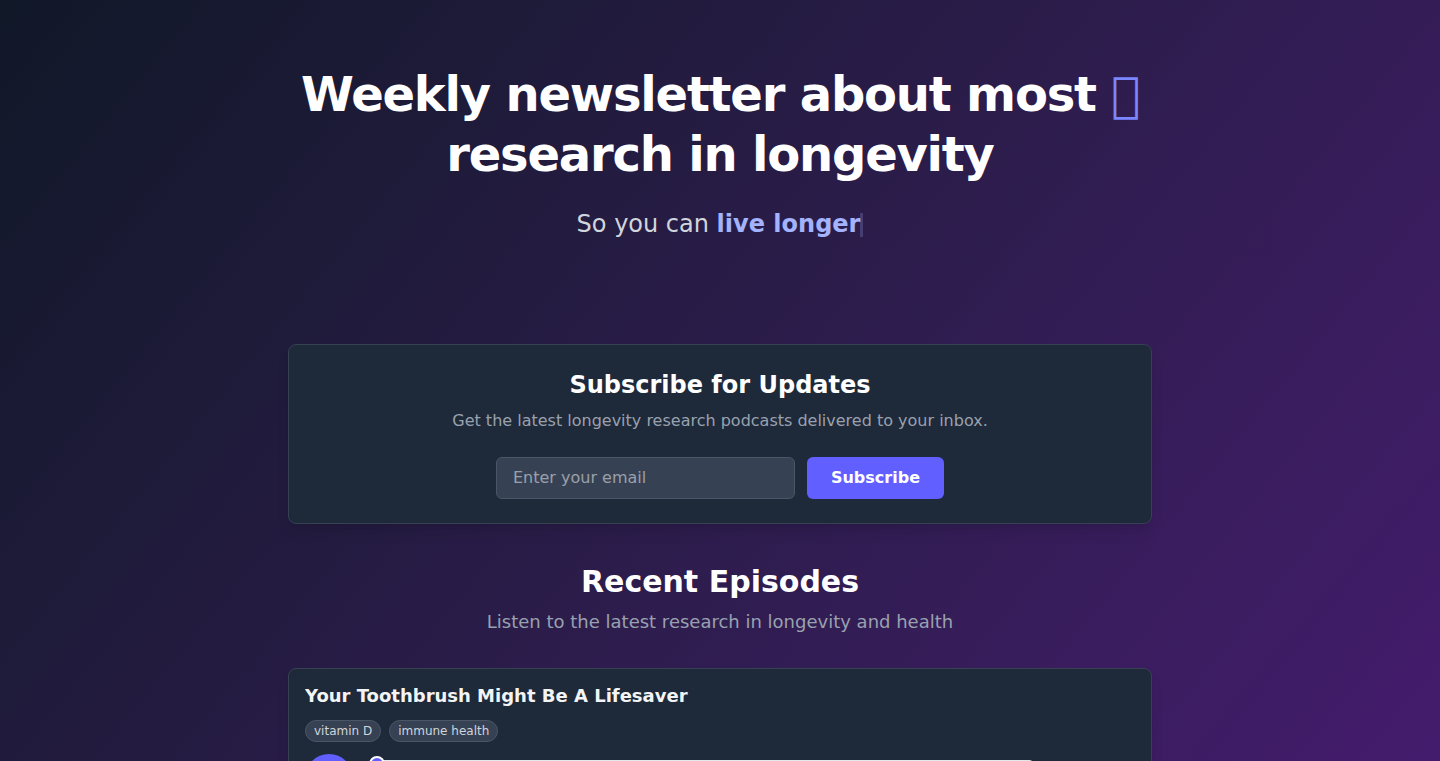
Author
ternovy
Description
This project automates the process of sifting through scientific research on longevity from PubMed, a database of biomedical literature. It uses a workflow automation tool (n8n) to find new studies, filter them based on relevant keywords, and then extract key findings. The extracted information is then transformed into a short script and recorded as an audio podcast episode. The innovation lies in automating the entire research-to-podcast pipeline, making complex scientific information accessible quickly and efficiently, without the need for manual reading of numerous research papers.
Popularity
Points 3
Comments 0
What is this product?
This project is an automated system that scans the PubMed database for longevity studies. It uses a predefined set of keywords to filter the studies, eliminating irrelevant ones. For the remaining studies, it identifies and extracts the important findings, methodology, and practical implications. Finally, it converts these findings into a script and generates an audio podcast episode. The core technical principle is the automation of information extraction and summarization using workflow tools and natural language processing techniques. So, this saves time for people to understand the cutting-edge longevity research quickly.
How to use it?
Developers or users interested in following the latest longevity research can subscribe to the generated podcast. They don't need to read dozens of research papers weekly. The project uses workflow automation software (n8n). Developers can adapt this project to other research areas by modifying the keywords, parsing logic, and output format. It offers a practical demonstration of automating complex information retrieval and summarization tasks. You can apply this in your specific areas, using the same automation workflow but focused on different topics.
Product Core Function
· Automated PubMed Search and Filtering: The system automatically searches PubMed and filters the results using a custom keyword set related to longevity. This is valuable because it reduces the amount of time researchers spend searching for relevant papers, saving considerable effort and resources. This is great for anyone interested in staying up-to-date with the latest research in a specific field.
· Information Extraction and Summarization: Key findings, methodologies, and practical applications are extracted from the selected studies, and a summary is generated. This provides condensed and accessible knowledge, making it easier for listeners to understand complex research without needing to read through lengthy scientific papers. This benefits anyone who needs to stay informed in a specific topic area but doesn't have the time to read all the scientific papers.
· Automated Script Generation and Audio Production: The extracted information is then converted into a short script, and an audio podcast episode is created. This transforms complex information into an easily consumable format. This allows users to consume the information via audio, which makes learning much easier.
· Workflow Automation (using n8n): The entire process, from PubMed search to audio production, is automated using a workflow automation tool called n8n. This automation saves considerable time and resources, eliminating the need for manual data processing. This is important for anyone who wants to streamline a workflow.
Product Usage Case
· Research Review: Instead of manually reviewing hundreds of research papers, a researcher can use a modified version of the project to automate the review of scientific literature in their field. This can significantly speed up the research process and enhance the accuracy of knowledge.
· Educational Content Creation: Educators can leverage this project to create short, informative summaries or podcasts on different topics by modifying the keyword sets, information extraction criteria, and audio production settings. The automated nature reduces the time and resources required to generate educational content.
· Personal Knowledge Management: An individual can use this project, customized for their specific interests, to receive a curated stream of summarized information in a convenient audio format. This allows for effective knowledge absorption without having to browse complex sources.
· Automated News Summarization: A news outlet can use this method to automatically summarize news articles from various sources on a particular topic, which helps generate fast-paced content for its audience. This will make information easier to consume for people who may not have much time.
30
WebNoteLink: Chrome Extension for Instant Note Sharing via Discord/Slack
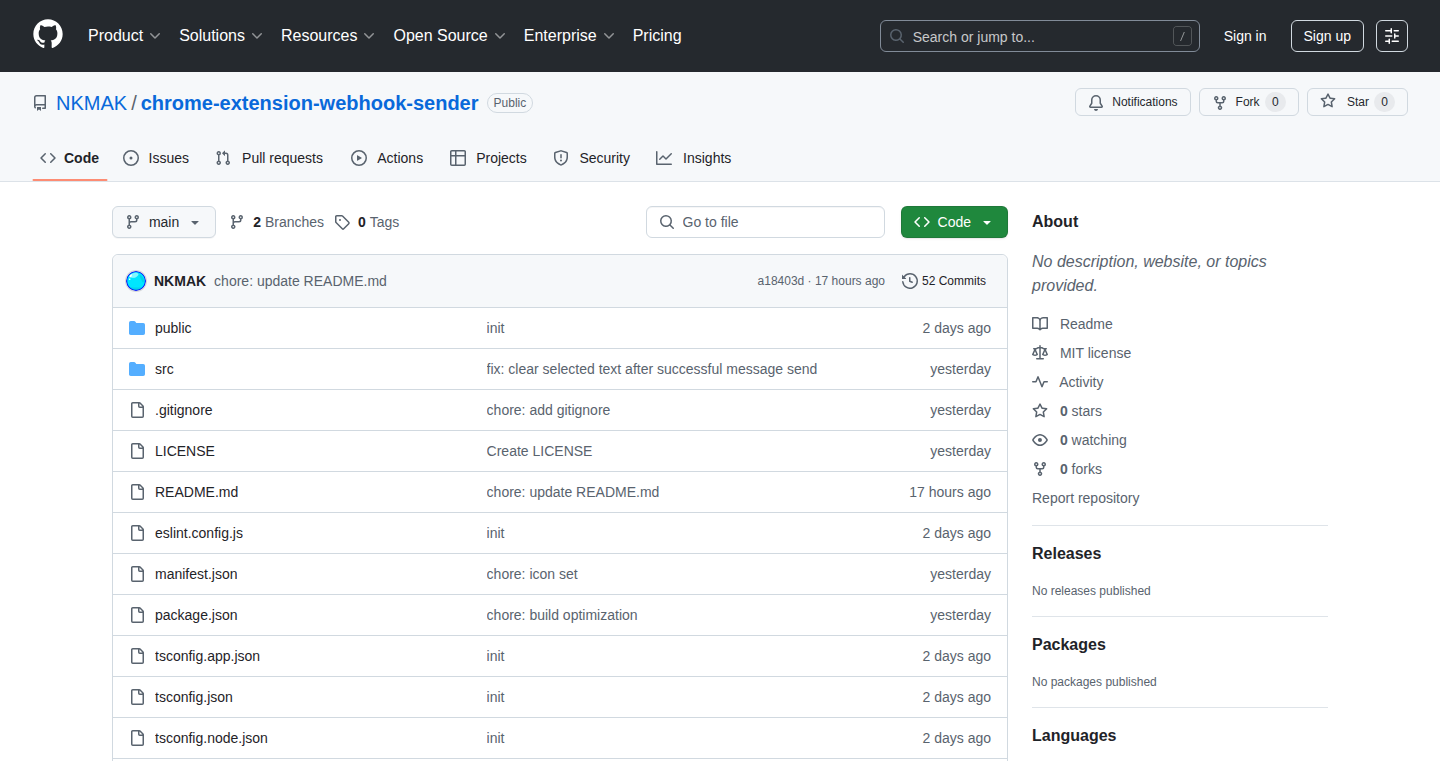
Author
nkmak
Description
WebNoteLink is a Chrome extension designed for quickly capturing and sharing notes from web pages directly to Discord and Slack channels. The core innovation lies in its streamlined workflow: users can highlight text, add notes, and instantly share these annotations along with a link back to the original page. This solves the common problem of fragmented information and inefficient collaboration when working with online resources. It simplifies the process of sharing insights and observations, improving team communication and knowledge management by bridging the gap between web content and collaboration platforms.
Popularity
Points 3
Comments 0
What is this product?
WebNoteLink is a Chrome extension that lets you annotate web pages and share those annotations, along with links back to the original content, directly to your Discord or Slack channels. The magic happens by intercepting your highlighted text, adding your notes, and constructing a shareable message that includes the URL and your annotations. This makes it super easy to collaborate and discuss online content with your team without losing context.
How to use it?
Developers can use WebNoteLink by installing the Chrome extension and configuring it with their Discord or Slack webhook URLs. When you're browsing a webpage, simply highlight text, click the extension icon, add your notes, and choose the platform to share. This allows for seamless integration into your existing workflow, facilitating quick feedback, knowledge sharing, and task assignments directly from within your browser.
Product Core Function
· Highlight and Annotation: WebNoteLink allows users to highlight specific text on any webpage and add personal notes to the selection. This feature empowers developers to quickly capture essential pieces of information from lengthy documentation or articles. So what? This helps save time and quickly gather the core points of a complex topic, reducing the time spent on reviewing extensive documentation.
· Instant Sharing to Discord/Slack: The extension provides a direct integration to share notes and highlighted content to Discord or Slack channels. This eliminates the need to manually copy and paste information, greatly simplifying the process of knowledge transfer within teams. So what? This ensures everyone on the team has access to the most relevant information for collaborative code reviews and project discussions.
· Context Preservation via URL: The shared notes always include a link back to the source webpage. This is crucial for maintaining context and allows team members to quickly access the original content for deeper understanding. So what? This creates a seamless transition from discussion to research, enhancing the speed of knowledge discovery and making it easier for all teammates to understand where the notes originally come from.
· Customizable Sharing Options: Users can customize the shared message format to suit their preferences and team communication styles. This feature provides flexibility in how information is presented and helps adapt the tool to different project workflows. So what? This enhances the effectiveness of team communication and the relevance of shared information for different team structures.
Product Usage Case
· During code reviews, a developer can highlight a problematic code snippet in a documentation page, annotate it with the issue, and instantly share it with the team via Slack. The link back to the documentation provides immediate context for debugging and discussion. So what? The team can pinpoint the problem without delay, expediting the fixing process and fostering a faster and easier code review cycle.
· When researching a new technology for a project, a developer can quickly highlight and annotate important paragraphs in documentation pages, share these notes with teammates on Discord, and centralize knowledge for further discussion. So what? This helps to easily share important information, letting the team make well informed decisions and better coordinate their project decisions.
· For project documentation, developers can use the extension to capture notes about API endpoints or function details and share those with the appropriate channel in Slack. The URL allows the developer to quickly reference the initial documentation. So what? It streamlines documentation by allowing the team to take notes from the existing resources and share them seamlessly with team members.
· In an online course, developers can annotate key concepts in the learning materials, share them with the team via Slack, and instantly create a shared repository of information. So what? This creates a collective, sharable understanding of course material, allowing everyone on the team to learn together and discuss key concepts.
31
NetXDP: Kernel-Level DDoS Defense with eBPF/XDP
Author
gaurav1086
Description
NetXDP is a new tool designed to protect your servers from Distributed Denial of Service (DDoS) attacks and manage network traffic, operating at the very core of your system. It uses cutting-edge technology called eBPF/XDP to quickly filter out malicious traffic before it even reaches your applications. This is a significant improvement over traditional methods, offering faster response times and reducing the load on your servers. This project represents a novel approach to network security by leveraging the kernel, providing an efficient and high-performance solution for modern online threats. So this means better performance and less downtime for your service.
Popularity
Points 3
Comments 0
What is this product?
NetXDP works by placing a smart filter directly within your computer's operating system kernel, using eBPF/XDP. Think of the kernel as the brain of your computer. eBPF/XDP allows NetXDP to analyze network traffic in real-time and instantly block suspicious activity, like a security guard at the door. The core innovation is using eBPF/XDP, which enables code to run directly in the kernel, giving NetXDP unmatched speed and efficiency. This allows it to drop bad traffic before it impacts your applications. So you get a faster response and better protection.
How to use it?
Developers can use NetXDP by integrating it into their server setup, likely requiring some knowledge of Linux and networking. It offers a rule manager for customization, letting developers define how NetXDP should handle different types of traffic. Developers could use it on servers hosting websites, APIs, or any network-facing application. It provides a real-time dashboard to monitor server health and an AI-driven analysis and reporting system. So you have more control over your network security.
Product Core Function
· Real-time Packet Inspection: NetXDP examines every packet of data coming into your server, looking for signs of malicious behavior. This helps to identify and block attacks as they happen. So you can stop threats before they cause damage.
· Dynamic Greylist/Blacklist: NetXDP maintains lists of suspicious and known-bad IP addresses. Traffic from these addresses can be immediately blocked or temporarily delayed (greylisted) for further scrutiny. So you get an automatic defense against known attackers.
· Custom Rule Manager: Developers can define their own rules to manage network traffic, based on factors such as the type of traffic, its source, and destination. This allows for fine-grained control and customization. So you can tailor the protection to your specific needs.
· Live Server Health Dashboard: NetXDP provides a real-time dashboard showing the current status of your server, including traffic patterns and attack attempts. This gives you visibility into what's happening. So you always know what's going on.
· AI Insights and Detailed PDF Reporting: NetXDP uses AI to analyze traffic data and provide insights into potential threats and attacks. It also generates detailed reports to keep track of security-related information. So you get helpful information about what is happening to your network and easy-to-understand reports.
Product Usage Case
· Web Server Protection: A web server experiencing frequent DDoS attacks can use NetXDP to filter out malicious traffic and maintain uptime. This keeps the website accessible to legitimate users even during attacks. So your website stays online.
· API Security: An API (Application Programming Interface) that's frequently targeted can use NetXDP to block harmful requests, thus protecting the integrity of the API and its underlying data. So your API remains secure and operational.
· Game Server Protection: Game servers are often targets for attacks. NetXDP can filter out malicious traffic, allowing for a better gaming experience. So your game runs smoothly, even when under attack.
· Cloud Infrastructure: Cloud providers can use NetXDP to protect their infrastructure from attacks. It helps maintain the availability of services for users. So your cloud services are more reliable.
32
SwissHostel: Decentralized Hostel Management with Blockchain
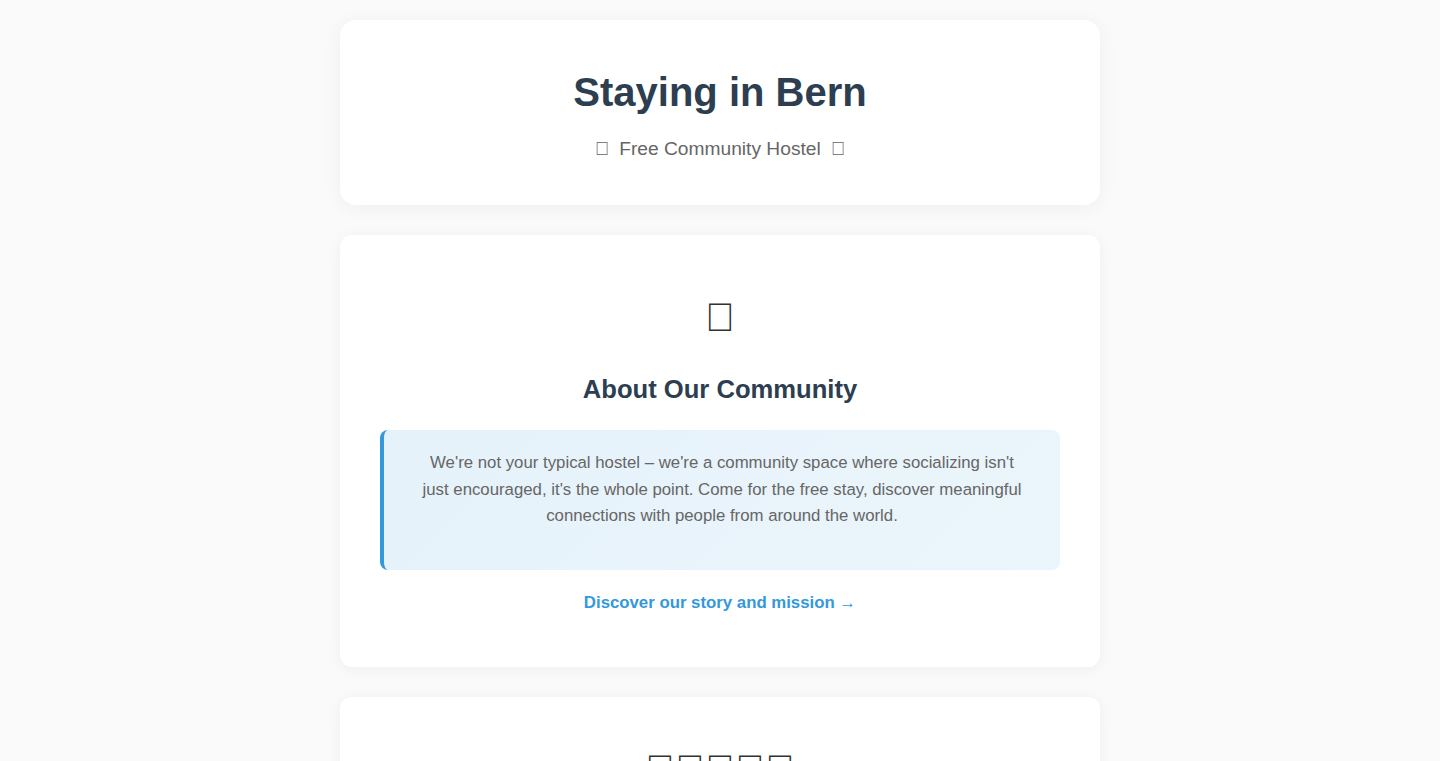
Author
chagaif
Description
SwissHostel is an experimental project proposing a decentralized hostel management system using blockchain technology. The project aims to create a transparent and secure booking system, allowing for direct communication between travelers and hosts, potentially eliminating the need for intermediaries and reducing fees. It leverages blockchain's immutability to ensure the integrity of bookings and reviews, and smart contracts to automate various processes.
Popularity
Points 3
Comments 0
What is this product?
SwissHostel is like Airbnb, but without the middleman. It uses blockchain technology, which is essentially a secure, shared database, to manage hostel bookings. The key innovation is using blockchain to record bookings, reviews, and payments. Smart contracts, which are like self-executing agreements written in code, automate tasks like confirming bookings and releasing payments to the host. So this eliminates the need for a central authority, potentially leading to lower fees and more direct communication between travelers and hosts.
How to use it?
If you're a developer, you could use this project as a starting point to learn about and experiment with blockchain-based applications. You could integrate similar booking or payment systems into your own projects. For a hostel owner, imagine using this to manage bookings securely and directly with guests. For a traveler, think about having more direct control over your booking, and knowing that your reviews are truly reliable.
Product Core Function
· Decentralized Booking: Using blockchain to store booking information (dates, room types, guest details). Value: Ensuring bookings are tamper-proof and transparent. Application: A hostel can directly manage bookings without relying on centralized platforms.
· Smart Contract Automation: Automating booking confirmations, payment release, and potentially cancellation policies. Value: Reducing manual work and guaranteeing fair transactions. Application: Automated payment processes for bookings made on the platform.
· Immutable Review System: Storing guest reviews on the blockchain. Value: Providing trustworthy feedback as reviews cannot be easily altered. Application: Making informed decisions when booking a hostel based on verified reviews.
· Direct Communication: Enabling direct messaging between guests and hosts. Value: Promoting direct interactions. Application: Guests and hostels can directly discuss specific needs, requirements, or information.
Product Usage Case
· Decentralized Travel Marketplace: Developing a decentralized platform for booking accommodations. Solve: Eliminate the reliance on centralized platforms and provide travelers and hosts with more control and transparency.
· Secure Review System: Implement a decentralized review system for hotels and other businesses. Solve: Guarantee reviews are trustworthy and protect against manipulation.
· Transparent Payment System: Create a blockchain-based payment system for the sharing economy. Solve: Facilitate secure and low-cost transactions between service providers and users.
33
Semantic Proximity Guesser: A Word Association Game Powered by GloVe Vectors
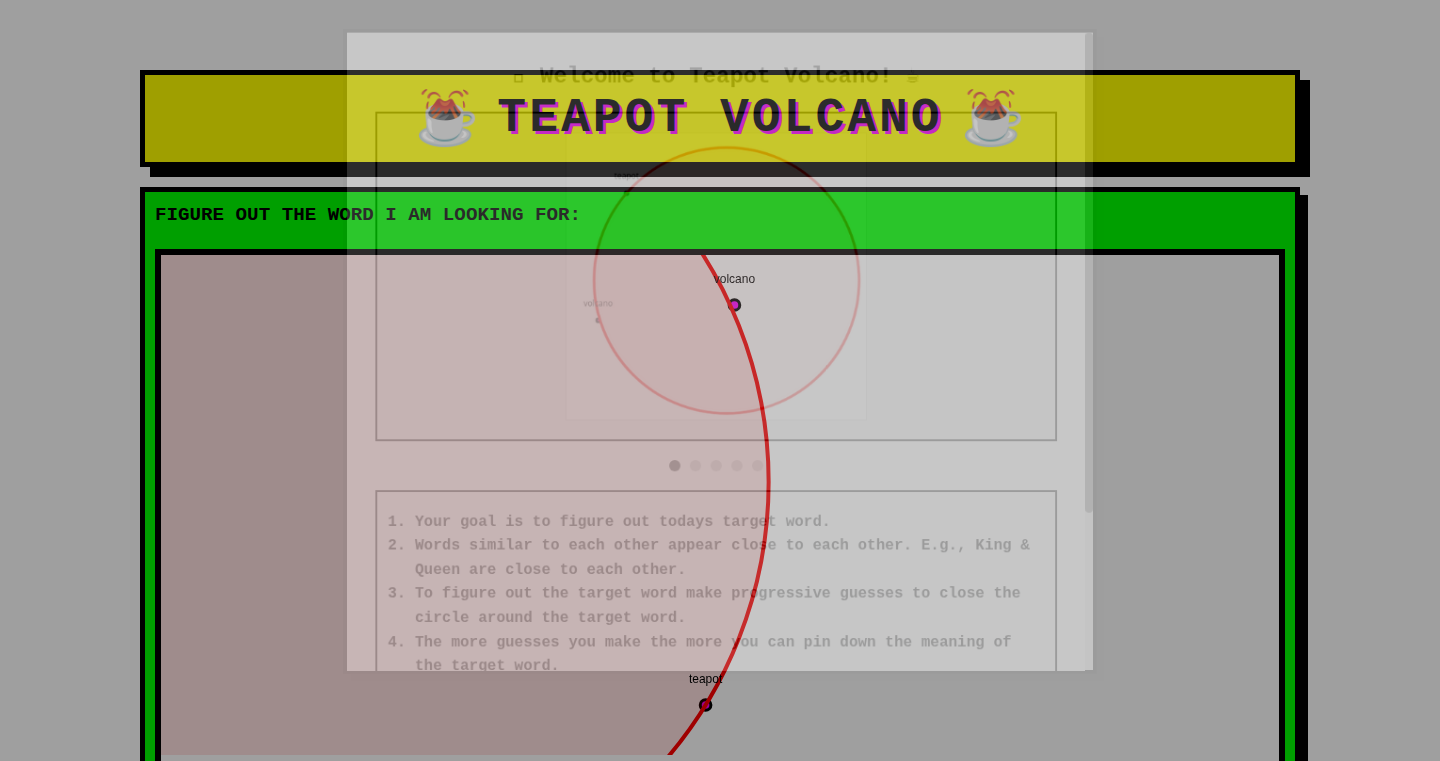
Author
ArneVogel
Description
This project creates a word guessing game where the computer uses pre-trained word vectors (GloVe) to understand the semantic relationships between words. The game challenges players to guess a target word by comparing it to other words, and the computer provides hints based on the word's proximity in a semantic space. The core technical innovation lies in the application of word embeddings to create a novel game experience, offering insights into how computers can 'understand' the meaning of words and their relationships. It's inspired by a similar game played by humans, but now played against a machine.
Popularity
Points 2
Comments 0
What is this product?
This is a word guessing game built on the principle of semantic similarity. The computer uses word vectors, which are mathematical representations of words, to understand how closely related words are to each other. Think of it like a map of words, where words with similar meanings are located closer together. The game presents the user with two words, and the user must guess which one is closer to the target word. The computer then provides feedback and hints, allowing the user to narrow down their guess. The innovative aspect lies in the application of pre-trained word embeddings (GloVe) to drive the game's logic. So, it's about using advanced techniques to enable a computer to play a human game.
So what is the real benefit of this? It demonstrates how computers can be programmed to understand the meaning of words and identify the relationships between them, much like humans do, offering a different approach for understanding natural language processing.
How to use it?
Developers could use this project as a base to explore natural language processing (NLP) concepts, particularly word embeddings and semantic similarity. The project could be integrated into other applications requiring word association or semantic understanding. You could, for example, add a word recommendation or suggestion feature to a text editor or writing tool. Developers can adapt the game logic to create educational tools for vocabulary building or language learning. The code is open source and could be used for similar text-based games or chatbots that require understanding the meaning of words in natural language. So, if you're a developer working on an application that needs to 'understand' language, this can show you how it works.
Product Core Function
· Word Embedding Integration: This is the core of the project. It uses pre-trained GloVe word vectors to represent words mathematically. This allows the computer to calculate the semantic similarity between words. The value here is in demonstrating how to effectively integrate pre-trained language models into a simple, understandable application, showing how to utilize the models easily without getting buried in the low-level details.
· Semantic Similarity Calculation: The system uses the GloVe vectors to calculate the distance between words in a semantic space, determining which words are closer in meaning. This is the engine that powers the guessing game by allowing the game to provide appropriate feedback to the user. This is useful if you want to create applications to recommend similar content, like for a search engine or recommendation system.
· User Interaction and Hint System: The game provides a user interface to interact with the game, allowing users to guess and receive hints. The hints are generated based on the semantic proximity of the guessed words to the target. This provides a practical example for creating user interfaces for NLP applications, teaching developers how to provide an interactive and intuitive experience for interacting with NLP models.
· Game Logic and Rules: The overall structure of the game follows the logic of the 'Mussolini or Bread' game, adapting it for a computer to play. The key here is the application of word vectors to a well-defined problem (semantic proximity) to solve a real-world challenge. Developers can use this as a guide to define rules for any NLP application.
· 2D Projection for Visualization (optional): The project includes a projection of the word vectors to 2D space. This helps to visualize the semantic relationships between words, offering a better understanding of how the computer makes decisions. Developers can utilize this to show the connections among related words.
Product Usage Case
· Educational Games: The project can be adapted to create educational games to teach vocabulary or language skills. The game can assess a user's understanding of word relationships. For example, a game can be built to teach synonyms or antonyms. So, it helps you create an interactive way to teach language.
· Text Analysis Tools: The underlying technology can be used in text analysis tools. This could be for tasks like identifying key topics in a document, finding similar articles, or improving search results. So, it can improve the way you can find information in any text.
· Chatbots and Conversational AI: The principles can be applied to improve chatbots' understanding of user input, allowing them to respond more accurately and naturally. The key is to get a chatbot to understand the nuances of the user's intent, and to provide better answers. Thus, it will improve user experience.
· Content Recommendation Systems: The semantic similarity calculation can be used to recommend content (articles, products, etc.) based on the user's interests or the content they are currently viewing. For example, if a user is reading an article about 'artificial intelligence', it could recommend other similar articles. So, it enables your product to get more engagement by providing more relevant content.
34
LaunchIgniter: The Maker's Launchpad
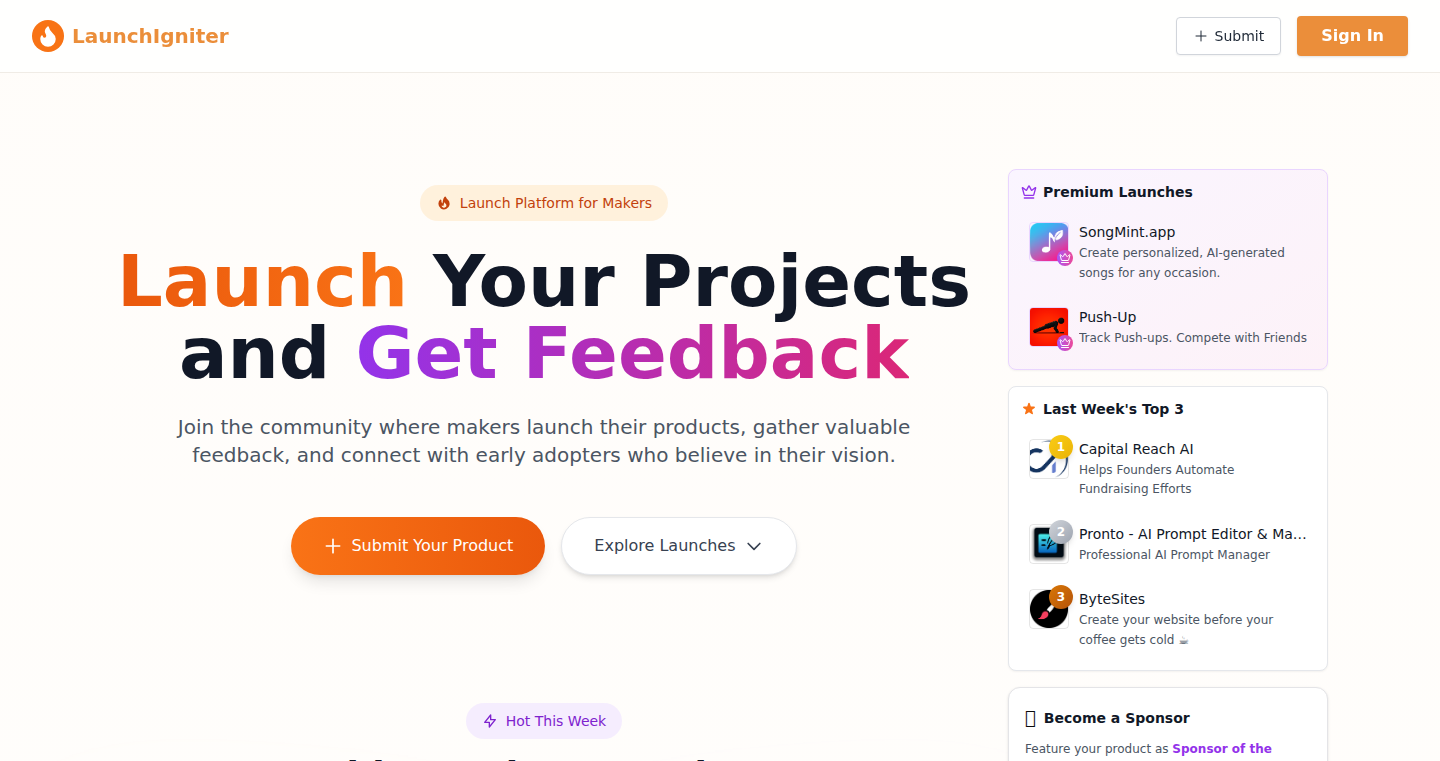
Author
maulikdhameliya
Description
LaunchIgniter is a platform designed to help makers and indie developers launch their projects. It simplifies the often-complex process of project launches by providing a streamlined set of tools and guidance. The key innovation lies in its focus on automating and integrating various launch-related tasks, such as building landing pages, managing email campaigns, and tracking user sign-ups, all within a single, user-friendly interface. This tackles the common problem of developers having to piece together various tools and services, leading to fragmented workflows and wasted time. So, it lets you spend less time wrestling with tools and more time building your product.
Popularity
Points 2
Comments 0
What is this product?
LaunchIgniter is essentially a one-stop shop for launching your software projects. It simplifies the process by providing tools to create landing pages (the first impression of your product), manage email marketing (telling people about your product and getting them interested), and track how people are using your product (so you can make it better). Its innovative because it brings all these pieces together in one place, saving you the headache of dealing with multiple separate services. So, it provides a more focused and efficient launch process.
How to use it?
Developers can use LaunchIgniter by simply logging in, entering their project details, and using the provided tools to build their landing page, set up email campaigns, and track user activity. It integrates by offering APIs and webhooks, allowing developers to connect LaunchIgniter to their existing project infrastructure. You might use this to create a polished landing page, then connect it to your existing payment processing, or to integrate your signup form with your mailing list. So, you can focus on the core features of your product without getting bogged down in marketing logistics.
Product Core Function
· Landing Page Builder: This allows developers to quickly create professional-looking landing pages without needing to code extensively. This is valuable because it gives you a professional online presence quickly, allowing you to test your idea with potential customers and gather feedback without spending weeks on design and development. So, you can get your product in front of people quickly.
· Email Campaign Management: This provides tools to manage email sign-ups, send marketing emails, and track email performance. This is valuable for building an audience, keeping people informed about your product, and measuring the effectiveness of your marketing efforts. So, you can effectively communicate with your potential customers and understand what works best for you.
· User Sign-Up Tracking: This allows developers to monitor user sign-ups and analyze user behavior on their landing pages. This is valuable for understanding how users interact with your product, identifying potential issues, and optimizing your landing pages for better conversion rates. So, you can gain valuable insights into user behavior and improve the effectiveness of your marketing.
Product Usage Case
· A developer building a new SaaS product can use LaunchIgniter to quickly create a landing page, set up an email campaign to announce the product, and track user sign-ups. This allows them to gather feedback from potential users and iterate on their product based on their input. So, it helps you quickly validate your product idea.
· An indie game developer can use LaunchIgniter to build a landing page to promote their game, collect email addresses for pre-launch updates, and track the number of sign-ups. This lets them build hype and gauge interest before the game's release. So, you can build excitement and get pre-orders.
35
LitCode Snippets: Instant Web Component Power-Up

Author
Brysonbw
Description
LitCode Snippets is a Visual Studio Code extension designed to supercharge your Lit component development. It provides pre-built code snippets that allow you to quickly insert common Lit component structures, saving you time and reducing the chances of errors. This is a practical tool for web developers, offering a significant productivity boost by simplifying the process of writing web components.
Popularity
Points 2
Comments 0
What is this product?
This is an extension for Visual Studio Code that helps you write web components using Lit (a popular JavaScript library for building web components) much faster. It works by giving you shortcuts – type a short keyword, and the extension will automatically insert a chunk of pre-written code for common Lit component patterns. This means less typing, fewer mistakes, and a faster development cycle. So this will help you focus more on the actual functionality of your components, rather than struggling with repetitive code.
How to use it?
As a developer, you install this extension in your Visual Studio Code editor. Then, when you're writing Lit components, you can start typing a snippet keyword (like 'lit-element' for a basic LitElement component) and the extension will suggest the complete code block. Press Enter, and the code is inserted. You can then customize the code to fit your needs. It integrates seamlessly with your existing development workflow. So you can quickly build web components without getting bogged down in boilerplate code.
Product Core Function
· Pre-built code snippets for common Lit component patterns: These snippets provide ready-made code blocks for common Lit component structures like custom elements, property declarations, template rendering, and event handling. This saves developers from writing the same repetitive code over and over again, letting them focus on the unique features of their components. So this will save you time and effort by eliminating the need to manually write or copy/paste common Lit component structures.
· Keyword-based triggering for easy snippet insertion: The extension uses short keywords to trigger the insertion of snippets. This allows developers to quickly insert complex code blocks without manually typing them out. So this helps improve coding speed and efficiency by offering an intuitive way to insert pre-written code blocks.
· Integration with Visual Studio Code: The extension seamlessly integrates with the Visual Studio Code editor, providing an intuitive and user-friendly experience. This eliminates the need to switch between different tools or environments. So this makes it simple for developers to adopt and use, enhancing their web component development workflow.
· Reduced boilerplate and error-prone code: By automating the insertion of boilerplate code, the extension reduces the amount of code a developer needs to write and minimizes the likelihood of introducing errors. This improves code quality and reduces debugging time. So this improves the overall development process by saving time and improving code quality.
Product Usage Case
· Building a reusable UI component library: Imagine creating a library of web components for your company's website. With LitCode Snippets, you can quickly build the base components and add specific functionality without spending time on initial setup. So this reduces the time needed to create and maintain a set of reusable components, which will ensure consistency across your projects.
· Rapid prototyping of web applications: Quickly create prototypes of your web applications. You can quickly sketch out the structure of a user interface using Lit components and snippets and focus on the functionality. So this allows you to rapidly test new ideas and refine your design more easily.
· Streamlining team collaboration: When multiple developers work on the same project, using a tool like this helps enforce coding standards and reduces the time spent dealing with inconsistencies. So this encourages consistency in the way code is written, making the code easier to read and maintain across the team, and reduces friction between developers.
· Learning Lit and web component development: For developers new to Lit and web components, LitCode Snippets can be a helpful learning tool. The snippets show the core structure of common components. So you can quickly see how components are built and how they interact with each other without needing to understand every detail from the beginning.
36
Database Server Genesis: A Practical Guide to Database Internals

Author
zetter
Description
This Show HN post announces a book that guides you through building your own database server from scratch. It's not just about using a database; it's about understanding the core mechanics of database systems like PostgreSQL and MySQL. The book delves into building a typed programming language, executing SQL queries, and understanding the inner workings of real-world databases. It's an exploration into the fundamentals of how databases store and retrieve information efficiently and reliably. So this guide offers a deep dive into the often-hidden world of database technology, enabling you to build your own version, understand the architecture, and solve complex data management challenges.
Popularity
Points 2
Comments 0
What is this product?
This project is a practical guide, in the form of a book, that teaches you how to build your own database server. It's like getting a behind-the-scenes tour of how popular databases like PostgreSQL and MySQL actually work. The book explains how to create a programming language with specific data types (typed language), translate SQL queries into instructions the server can understand and how the server itself handles storing and retrieving data effectively. This gives you a deep understanding of the whole system instead of just using it. So, it's like understanding the engine of a car instead of just driving it.
How to use it?
Developers can use this book as a comprehensive learning resource to gain a deep understanding of database internals. It's for anyone looking to understand how databases work, potentially contributing to open-source database projects, or even building their own specialized database solutions. You can read the guide and follow the examples. This allows you to learn how to design a database, implement SQL features, manage data storage and develop a robust database system. So, it helps you become a database expert, capable of solving advanced data management challenges and optimizing database performance.
Product Core Function
· Building a Typed Programming Language: The guide covers the creation of a programming language with strong data typing. This allows developers to understand the fundamental principles of language design, type systems, and how they contribute to data integrity and efficient query processing. So it helps in understanding programming language design and can lead to building custom data manipulation solutions.
· SQL Query Execution: The book describes the process of executing SQL queries, including parsing, query optimization, and execution. This gives developers insights into the inner workings of relational database management systems. So it helps in understanding how to optimize queries and improve performance.
· Database Internals: The guide explores the internal architecture of database systems, including storage engines, indexing techniques, and transaction management. It provides in-depth knowledge of how databases store data efficiently and reliably. So it helps to solve complex data storage and retrieval problems.
Product Usage Case
· Developing Custom Data Storage Solutions: Developers can apply their knowledge to design and implement specialized data storage systems for unique requirements, such as handling specific data types or optimizing performance for particular workloads. So it can be used to build highly optimized data storage solutions.
· Contributing to Open Source Database Projects: The detailed understanding of database internals gained from this guide can be applied to make meaningful contributions to open-source database projects. So it helps in improving existing database systems.
· Database Performance Tuning: The insights into query optimization and database internals can be used to improve database performance by optimizing SQL queries, designing efficient indexes, and fine-tuning the database configuration. So it allows optimizing database systems for specific use cases.
37
Emporium: Open-Source eCommerce Platform for Creators
Author
dominus_silens
Description
Emporium is a fully open-source and self-hostable eCommerce platform designed for creators, artists, and independent sellers. It aims to provide an alternative to expensive and vendor-locked platforms like Shopify. The project leverages technologies like React, FastAPI, and PostgreSQL, and features a JSON-driven form engine for admin interfaces, along with optional AI integration via ShellGPT and Ollama. The core innovation lies in offering a customizable, fee-free solution that empowers creators to control their online stores and data.
Popularity
Points 2
Comments 0
What is this product?
Emporium is an e-commerce platform that creators can host themselves. It's built using modern web technologies like React for the user interface, FastAPI for the backend, and PostgreSQL for storing data. The innovative part is its focus on being open-source, allowing users to avoid monthly fees and have complete control over their store's code and data. It also incorporates a unique JSON-driven form engine, making it easier to build and customize the admin interface. The optional AI integration, using tools like ShellGPT and Ollama, allows for local AI assistance, improving the user experience. So this means you get a flexible, cost-effective, and customizable platform. So this means you have full control and don't need to pay monthly fees.
How to use it?
Developers can use Emporium by cloning the project from GitHub and setting up the necessary dependencies (like Node.js, Python, and Docker). Then, they can deploy the platform on their own server or cloud provider. The platform is designed to be modular, so developers can create their own plugins and customize the store's functionality. The core functionality is managed by JSON configuration files, which defines UI components and admin interfaces, making it user-friendly to modify the store's look and functionality without extensive coding. Developers can also contribute to the project and enhance features. So you can build your own store without vendor lock-in.
Product Core Function
· Open-Source Core: The entire platform is built on open-source principles, providing developers with complete access to the code. This promotes transparency and allows for extensive customization, which prevents vendor lock-in and reduces operational costs. You get full control over your platform and can adapt to your needs.
· Self-Hosting Capability: Emporium is designed for self-hosting, allowing users to run their stores on their own servers. This feature reduces reliance on third-party services and gives users complete control over their data, which is essential for privacy-conscious creators. So you are in complete control and can choose your own hosting.
· JSON-Driven Form Engine: The use of a JSON-driven form engine for admin forms. This simplifies the process of building and customizing the admin interface, making it easier for developers to manage their store's settings, products, and other administrative tasks. It is very user-friendly and you don't need to write too much code.
· AI Integration: Optional AI integration via tools like ShellGPT and Ollama. This feature allows for local AI assistance and enhances the user experience. For example, AI can help to manage the store or interact with clients. This means that you can automate part of your business.
Product Usage Case
· A freelance artist uses Emporium to sell digital art prints. They can customize the storefront to match their brand, manage product listings, and process orders without monthly fees. This allows them to keep more of their earnings and control the customer experience. So you can have complete control and keep your earnings.
· An independent therapist uses Emporium to offer online therapy sessions and sell digital resources. They leverage the self-hosting capabilities to ensure patient data privacy and customize the platform to meet their specific business needs. So you can have complete control of data and can choose what functionality you want.
· A small business owner uses Emporium to sell handmade crafts. They integrate the platform with their existing marketing tools and analytics platforms. So you can integrate the platform with what you want.
38
Homepagr: Your Personalized Work Navigator
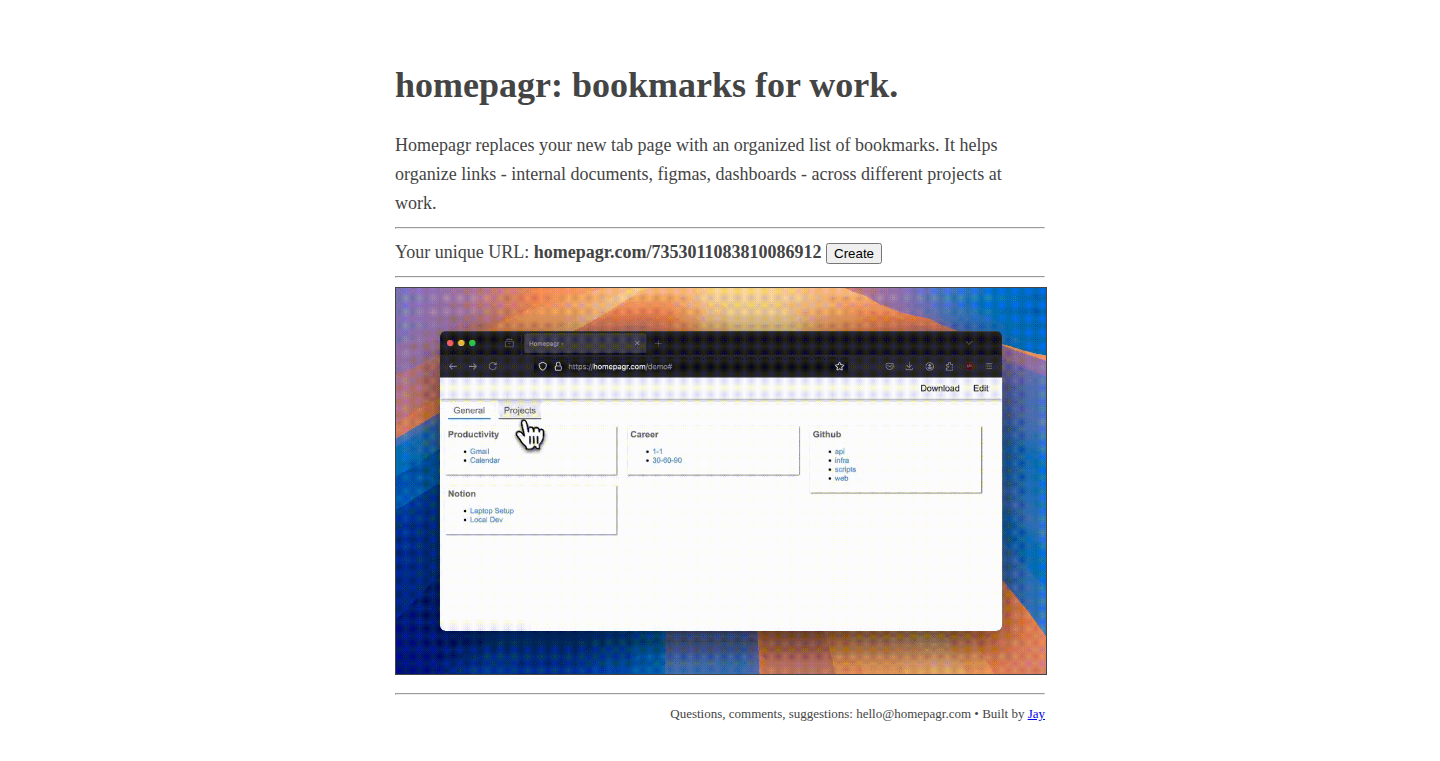
Author
memset
Description
Homepagr is a personalized bookmarking tool specifically designed for your work. It goes beyond simple bookmark management by offering a visually-driven, customizable interface. This project emphasizes quick access to frequently used work resources, using a grid-based layout for intuitive navigation. The key innovation is the focus on visual organization and personalized workflows to reduce time wasted searching for information. So this means less time clicking and more time doing.
Popularity
Points 2
Comments 0
What is this product?
Homepagr is built around the core idea of providing a visual workspace for your work-related bookmarks. Instead of just a list of links, it presents your bookmarks in a grid format, allowing you to easily spot the resource you need. It likely uses technologies such as HTML, CSS, and JavaScript for the front-end, with potential backend implementations using databases or local storage to persist bookmark data. The innovation lies in its simplicity and its tailored approach to bookmarking, specifically catering to the needs of a professional environment. So, it's like having a digital bulletin board for your work, tailored to your specific needs.
How to use it?
Developers can use Homepagr by simply adding their frequently accessed websites, tools, documentation, or project repositories. Users would add URLs and customize the appearance of the bookmarks. Integration is straightforward: after setup, it lives in the browser, accessed whenever you need to quickly jump to a key resource. This approach makes it an ideal solution for developers needing to access frequently used resources, eliminating the need to hunt through endless browser history or search for URLs. This means faster development and less context switching.
Product Core Function
· Visual Bookmark Organization: Provides a grid layout for bookmarks, making it easier to scan and find the desired resources quickly. Value: Improves information retrieval speed and efficiency. Application: Quick access to project documentation, code repositories, and other essential development resources.
· Customizable Interface: Allows users to tailor the appearance of each bookmark, enabling them to add icons, labels, and custom styling. Value: Creates a personalized and intuitive workspace. Application: Quickly recognize and access important project pages without remembering URLs.
· URL Management: Offers features to add, edit, and organize URLs, potentially including features to categorize and group bookmarks. Value: Improves the organization of work resources. Application: Centralized access to different resources (e.g. coding environments, issue trackers, team communications) to improve productivity.
Product Usage Case
· Project Documentation Access: A developer working on a new project can use Homepagr to instantly access all project documentation, API references, and tutorial websites, eliminating the need to search. This saves valuable time and keeps everything organized. So you get to focus on the actual code instead of hunting for information.
· Code Repository Navigation: A development team utilizes Homepagr to provide easy access to the company's Git repositories, streamlining code review and contribution processes. Developers can jump straight into the codebase they need, reducing friction. So you're in the code, and less time looking for it.
· Tooling Workflow: A developer creates a Homepagr setup to access commonly used developer tools like linters, debuggers, and build systems. This allows for quick access and less configuration time. So, the setup lets you start coding immediately instead of configuring tools.
39
Agency Protocol: Programmable Trust for Autonomous Systems

Author
dvdgdn
Description
Agency Protocol is a groundbreaking system designed to build trust in the age of AI, focusing on verifiable promises and economic incentives. It addresses the limitations of traditional reputation systems, which often simplify complex capabilities into a single score. The core innovation lies in its domain-specific approach to trust, allowing for explicit, stakeable promises backed by verifiable evidence. This ensures that systems are held accountable for their actions, making reliability profitable and deception costly. This is especially crucial in a future where AI agents coordinate with each other on a massive scale without human oversight. The protocol essentially creates trust as a programmable primitive, similar to how TCP/IP standardized data transmission.
Popularity
Points 2
Comments 0
What is this product?
Agency Protocol is a new way of building trust in a world increasingly reliant on AI. Instead of relying on simple reputation scores (like star ratings), it allows systems to make specific promises and be held accountable for them. For example, an AI that diagnoses medical images might promise to be over 95% accurate, staking computational credits as collateral. If it breaks its promise, it loses those credits; if it keeps its promise, it gains trust. This system relies on Promise Theory and game theory, offering a programmable and verifiable way to ensure that AI systems are reliable and trustworthy. So this is like creating a contract between AI systems, making them economically responsible for their actions.
How to use it?
Developers can integrate the Agency Protocol to create trustworthy AI services. Imagine a scenario where you are developing a medical diagnostic tool. With Agency Protocol, you can make and stake a promise of accuracy. As the tool performs and provides results, verifiable evidence of its accuracy is recorded. Users can easily assess the reliability of the tool based on its past performance. The integration involves defining promises, specifying verifiable evidence requirements, and managing the economic incentives (like stakes and rewards) associated with keeping or breaking promises. So you, as a developer, can build systems that inspire more trust because they come with guarantees.
Product Core Function
· Promise Creation and Definition: Developers define specific promises that their AI or service will make, such as accuracy, speed, or other performance metrics. Value: Allows for specific, measurable, and verifiable commitments, going beyond general reputation scores. Application: For a translation service, promises could involve document accuracy within a certain time frame.
· Stake-Based Incentives: Systems stake resources (like computational credits) on their promises. Value: Creates economic incentives for reliability. Broken promises result in penalties, while kept promises lead to rewards. Application: A self-driving car could stake credits on safe driving performance, financially incentivizing it to avoid accidents.
· Verifiable Evidence: The system requires verifiable evidence to assess whether promises are kept or broken. Value: Ensures transparency and accountability, preventing gaming or manipulation of the system. Application: AI that analyzes X-rays provides quantifiable accuracy metrics that can be independently verified.
· Domain-Specific Trust: The protocol allows for trust to be built in a domain-specific way. Value: Addresses the limitations of generic trust scores by tailoring trust to the specific capabilities of the service. Application: A surgeon’s reputation would be evaluated on surgical outcomes, rather than general social media reviews.
Product Usage Case
· AI Medical Diagnosis: Develop an AI system for reading medical images. Using Agency Protocol, the AI makes a promise for a specific accuracy rate, staking some computational resources. Users can verify performance by reviewing verifiable evidence (e.g., the system's performance on test sets). So you can build a reliable medical diagnostic tool that doctors can trust, since it's accountable for its accuracy.
· Autonomous Trading Systems: Create an automated trading system. You could use Agency Protocol to establish promises about trade execution speed or profitability. This helps you build confidence in the trading system by enabling performance transparency. For example, the AI could promise a specific transaction speed and if it fails, there are economic consequences. So you could enhance the reliability of your trading bots, thereby increasing trust and attracting more users.
· Media Content Verification: Use it in a media platform to verify the accuracy of news reports. The news source could promise that its reporting adheres to specific standards, and they stake a reputation score. Users can verify by verifying facts and if they are inaccurate, there would be consequences. So this allows you to filter out misinformation and promote reliable information. This fosters more trust among users, allowing you to become a reliable news source.
40
OctoMailer: Node.js's Swiss Army Knife for Emails
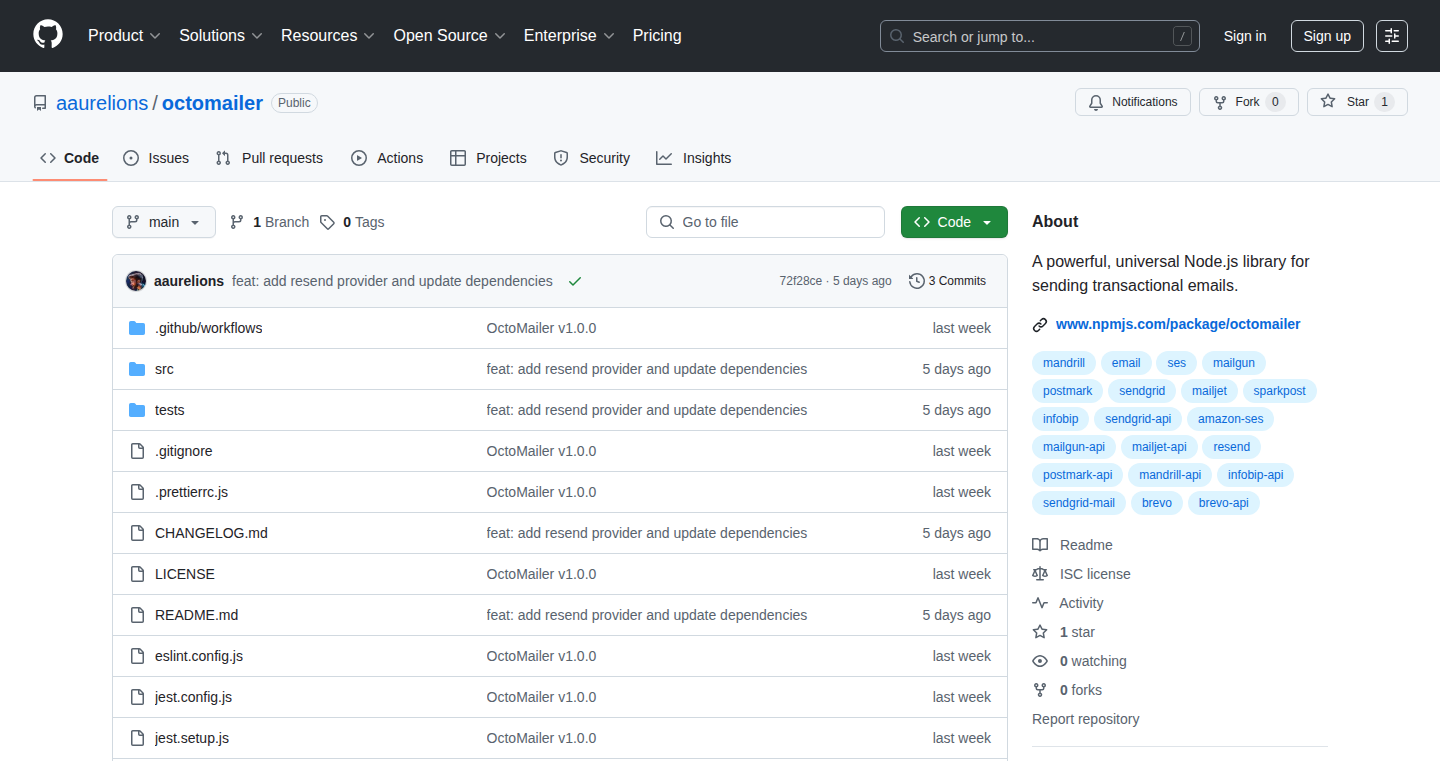
Author
aaurelions
Description
OctoMailer is a Node.js library that simplifies sending emails by acting as a universal translator for different email service providers. Think of it as a single API that lets you talk to services like SendGrid, Mailgun, or AWS SES without having to learn each one's unique language. The innovation lies in its unified interface and the ability to switch email providers seamlessly, which can drastically improve email deliverability and control.
Popularity
Points 2
Comments 0
What is this product?
OctoMailer is a software library that provides a consistent way to send emails, regardless of the underlying email service you're using. It hides the complexities of each provider behind a single, easy-to-use API. Its core innovation is abstracting away the differences between various email service providers. So, instead of writing different code for SendGrid, Mailgun, and others, you use OctoMailer’s API, and it handles the rest. It also supports intelligent routing, letting you send emails through different providers based on factors like cost, deliverability, or features. This is a boon for developers who need flexibility and control over their email infrastructure.
How to use it?
Developers integrate OctoMailer into their Node.js applications by installing the library and then using its API to send emails. For instance, to send an email, you'd provide the recipient, subject, and content, and OctoMailer would handle the communication with your chosen email service provider. You can choose to set up multiple providers and configure rules to decide which provider to use for each email. This flexibility is especially useful for scaling your email sending capabilities or optimizing cost and deliverability. So, if you are building a web application that needs to send registration confirmations or password reset emails, you can use OctoMailer to manage the email sending process.
Product Core Function
· Unified API: A single, consistent interface for sending emails, abstracting away the specifics of different email providers. This saves developers from having to learn and maintain code for each provider. So, this means less code and faster development.
· Provider Abstraction: Supports a wide range of email service providers (e.g., SendGrid, Mailgun, AWS SES). You can switch between them easily. So, this gives you the flexibility to choose the best provider for your needs, or to switch providers if one has issues.
· Intelligent Routing: Allows you to configure rules to send emails through different providers based on various criteria (e.g., cost, deliverability). So, you can optimize email sending based on your business goals, maximizing both performance and budget.
· Retry Mechanisms and Error Handling: Built-in features for handling common email sending issues like temporary outages or rate limits. So, it ensures your emails get delivered, even if the email service provider has issues.
· Configuration and Customization: Provides a flexible configuration system, allowing developers to tailor the library to their specific needs. So, it means you can fully control and optimize your email delivery.
· Transactional Emails Focus: Built specifically for transactional emails, ensuring reliable delivery for important notifications. So, it means your users receive critical updates reliably.
Product Usage Case
· An e-commerce platform uses OctoMailer to send order confirmations, shipping updates, and promotional emails. By utilizing multiple email providers and intelligent routing, the platform ensures high deliverability rates, even during peak traffic periods. So, it ensures that customers receive important order information.
· A SaaS application integrates OctoMailer to send password reset emails, account verification emails, and billing notifications. The app leverages the provider abstraction to easily switch providers based on cost and performance, ensuring consistent email delivery. So, it ensures users receive important communications quickly and reliably.
· A developer uses OctoMailer to build a customer support ticketing system. The system uses OctoMailer to send email notifications to agents and customers, improving communication efficiency and responsiveness. So, this streamlines the customer support experience.
41
ChessArena: LLM Chess Performance Evaluator

Author
rohitghumare
Description
ChessArena is an open-source platform designed to evaluate the performance of large language models (LLMs) in playing chess. It moves beyond simple win/loss records, focusing on the quality of moves and game insights. ChessArena uses Stockfish, a top-tier open-source chess engine, to assess each move made by an LLM. It quantifies move quality using 'move swing', with blunders identified when the difference between the LLM's move and the best possible move exceeds a certain threshold. The project leverages the Motia framework, highlighting its ease of use in building real-time applications. So this allows you to objectively gauge how well these AI systems understand and play chess.
Popularity
Points 2
Comments 0
What is this product?
ChessArena is like a performance review tool for AI chess players. Instead of just checking if an AI wins or loses, it digs deeper to analyze the quality of each move. It uses Stockfish, a super-smart chess program, to compare the AI's moves to the best possible moves. If the AI makes a bad move, it's called a 'blunder', and ChessArena tracks how often these blunders happen. This is useful because it helps developers see how well different AI systems understand and play chess, going beyond simple win/loss records. So this helps developers to see the real chess-playing skills of AI models and not just how well they can 'bluff' their way through a game.
How to use it?
Developers can use ChessArena to test and compare different LLMs in a controlled chess environment. They can integrate the platform to feed chess moves from their LLM and analyze the output against Stockfish. The platform provides metrics like move swing to assess the quality of moves, allowing developers to pinpoint weaknesses in their LLM's chess playing abilities. The open-source nature of the project allows for easy adaptation and extension. It also provides examples and insights for those new to chess AI testing. So, developers get a hands-on way to fine-tune their AI chess players and understand what makes a good move.
Product Core Function
· Move Quality Analysis: ChessArena uses the Stockfish engine to evaluate the quality of each move an LLM makes during a chess game. It calculates a 'move swing' score, which measures how far the LLM's move deviates from the best possible move. This allows developers to understand the decision-making process of the LLM during a game. So, this tells you how 'smart' the AI's moves are, allowing you to evaluate the skill of the chess-playing AI.
· Blunder Detection: The platform identifies blunders, which are significant errors in a chess move. By setting a threshold for 'move swing', the system flags moves that are substantially worse than the ideal move. This helps in understanding when an LLM fails to grasp basic chess principles or strategic concepts. So, this makes it easy to find the mistakes your AI chess player is making.
· Real-Time Application with Motia: The platform is built using the Motia framework, showcasing how to create a real-time application. This offers developers the ability to evaluate performance in real time, which is useful for live AI chess competitions or quick evaluations during the LLM development stage. So, developers can see the results as the AI plays and see how it performs.
· Open-Source and Customizable: The project is fully open-source, allowing developers to customize the code, integrate different LLMs, and adjust the evaluation criteria as needed. The project's GitHub repository allows for contributions from the community and encourages iterative improvements to the evaluation processes. So, developers can adapt the system to their specific needs and even help improve it.
Product Usage Case
· Comparing Different LLMs: A developer can use ChessArena to compare the chess-playing abilities of several different LLMs (like those from OpenAI, Claude, and Gemini). By running each LLM through a series of chess games and analyzing the move quality metrics, the developer can objectively rank the models based on their chess skills. So, this helps in choosing the best AI for chess-related applications.
· Identifying Weaknesses in LLMs: A research scientist can use ChessArena to pinpoint specific weaknesses in an LLM's chess play. For instance, the platform can reveal whether the LLM struggles with tactical combinations or strategic planning. This information informs the training and refinement of the LLM's chess skills, leading to better performance. So, developers can find areas to improve the AI's chess playing strategy.
· Chess AI Training and Development: An AI developer can leverage ChessArena to test their chess AI algorithms. Using move swing and blunder detection to refine and improve the AI's algorithms, leading to better performance in future games. So, developers can use this to make their AI chess playing programs stronger.
· Educational Tool for AI and Chess Enthusiasts: ChessArena provides a valuable educational resource for those interested in AI and chess. It demonstrates how to apply technical concepts to understand and assess complex problems like AI chess playing. So, it can provide a tool to learn how AI chess engines work.
42
Calligro: Your Custom Bitmap Font Forge
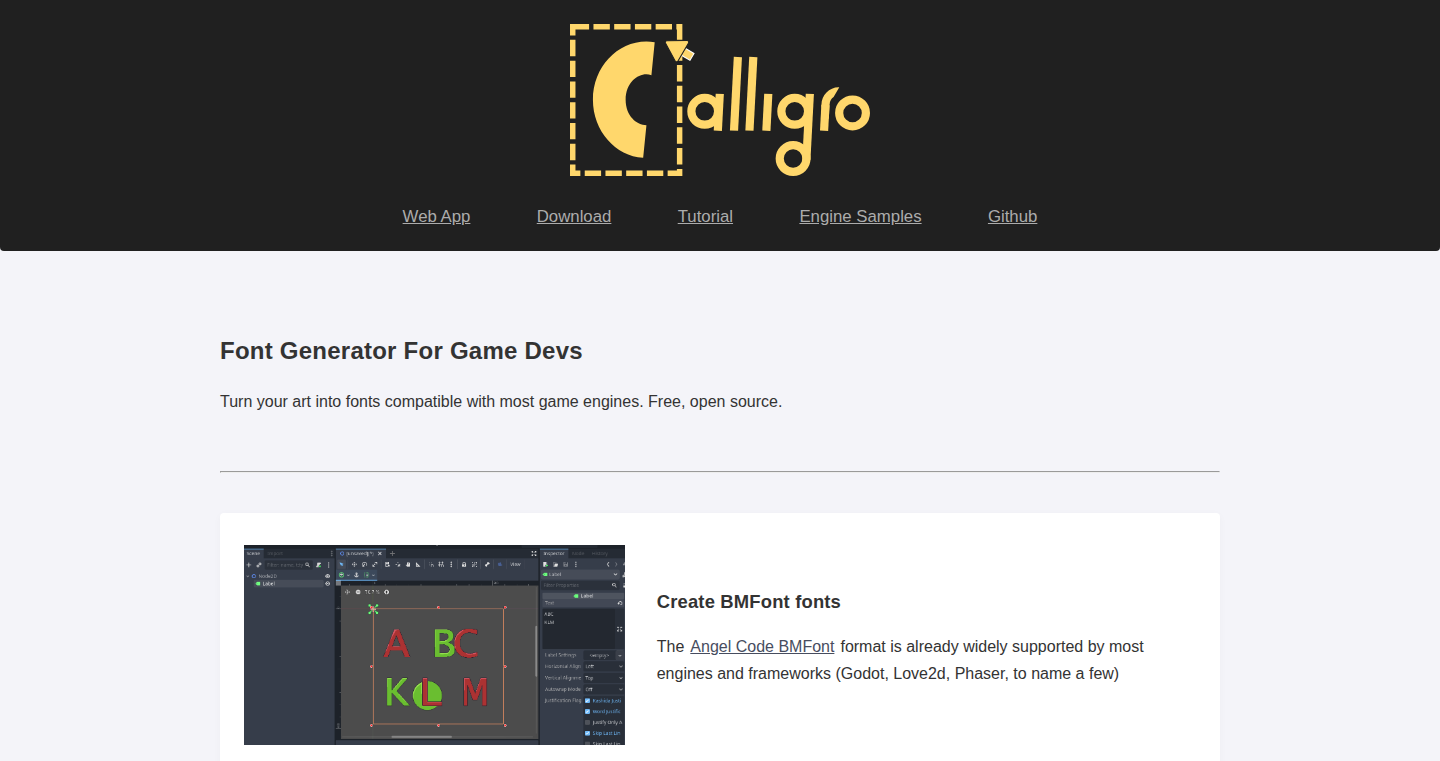
Author
Voycawojka
Description
Calligro is a tool that lets you create your own bitmap fonts from images you design. Think of it like this: instead of using pre-made fonts, you can draw your letters, numbers, and symbols by hand, and Calligro turns them into a font you can use in your games, apps, or other projects. The key innovation is its focus on hand-drawn characters, offering a high level of customization. It solves the problem of using unique, custom-made fonts in software.
Popularity
Points 2
Comments 0
What is this product?
Calligro takes your hand-drawn characters – created in any image editor – and transforms them into a bitmap font. It uses a standard format (similar to BMFont) that's easy to integrate into various applications. This is innovative because it puts the power of font creation directly in the hands of the user, allowing for truly unique and personalized font designs. It’s like having your own personal font factory. So this gives you a tool to create unique custom fonts for your projects.
How to use it?
Developers can use Calligro by first creating a template image, drawing characters within it, and then importing it into the tool. Calligro will then generate the font files. These files can be used in game engines like Unity, rendering libraries in web development, or any other application that supports bitmap fonts. You can integrate your hand-drawn font into your software for a more custom look. So this lets you create unique, hand-drawn fonts to make your projects stand out.
Product Core Function
· Template Export/Import: Calligro allows users to export a template for drawing characters and later import the completed images. This streamlines the design process and ensures consistency in character dimensions. So this enables a smooth workflow for creating and integrating custom characters into your fonts.
· Bitmap Font Generation: Calligro takes your images and converts them into a bitmap font file that can be used in various applications. This means your hand-drawn characters can be rendered in games, apps, and other software. So this allows you to easily use your custom fonts in your projects.
· Online and Offline Versions: Calligro offers both online and offline versions. This provides flexibility for users who may not always have internet access. So this ensures you can use it anywhere and at any time.
· UI Revamp: Version 2.0 features a completely revamped UI. This enhances the user experience, making the font creation process more intuitive and user-friendly. So this makes the tool easier to use and more enjoyable.
Product Usage Case
· Indie Game Development: An indie game developer wants a unique visual style for their game. They use Calligro to create a font that matches their game’s art style, allowing the game to stand out with a completely custom visual identity. So this lets you create custom visual styles to enhance the appeal of games.
· Mobile App Design: A mobile app designer wants to create an app with a distinctive user interface. They use Calligro to create a custom font for the app’s menus and buttons, enhancing its branding and user experience. So this enables creating a distinctive user interface and enhancing branding.
· Web Graphics: A web developer needs a custom font for a website’s header or logo. They can draw their custom characters, generate the font with Calligro, and incorporate it into their website's design. So this allows creating unique visual elements and improve branding consistency on websites.
43
Myriade: Natural Language Interface for Databases
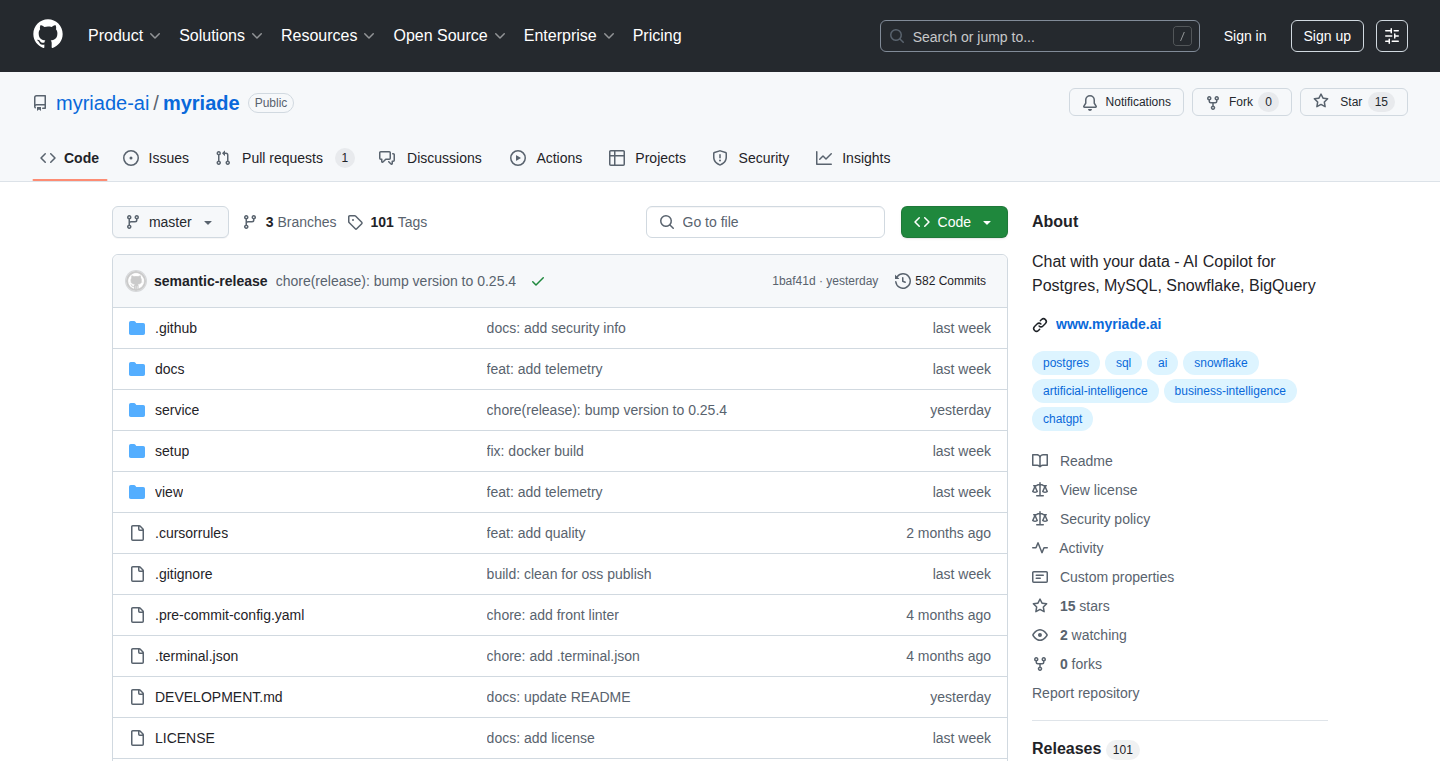
Author
BenderV
Description
Myriade is a tool that lets you ask questions about your database in plain English, like you're talking to a person. Instead of writing complicated SQL code, you can simply ask things like "Why did sales drop on July 14th?" The system uses a smart agent, powered by AI, to understand your questions, explore the data, and give you answers quickly. This saves you a lot of time and effort compared to traditional methods. It works with popular databases like PostgreSQL and MySQL and is designed to be self-hosted, giving you control over your data.
Popularity
Points 2
Comments 0
What is this product?
Myriade is a natural language interface (think of it as a smart assistant) for your databases. It uses AI to translate your simple English questions into complex database queries. It goes beyond just running queries; it analyzes the data, figures out the best way to get the answer, and explains the results in a clear, easy-to-understand way. The core innovation lies in the intelligent agent that can adapt to different questions, databases, and even correct itself if it makes a mistake. This significantly simplifies the process of data analysis, making it accessible to non-technical users.
How to use it?
You can use Myriade by connecting it to your database and then typing your questions in the interface. The system will process your question, execute the necessary queries, and present the results. You can also monitor how the agent is working and even "take over" at any point if you want to refine the analysis. For developers, it can be integrated into existing applications to provide users with a natural language query capability. This is particularly useful in business intelligence dashboards or internal data analysis tools. So you can build apps that let your users ask questions about their data without needing to know SQL.
Product Core Function
· Natural Language to SQL Conversion: This is the core functionality, turning human language queries into database queries. Value: Reduces the need for users to write complex SQL code. Application: Allows non-technical users to access and analyze data.
· Intelligent Agent for Data Exploration: The system explores and analyzes the data to find the best answer. Value: Automatically handles complex data analysis tasks. Application: Quickly identifies trends, anomalies, and insights within data.
· Self-Hosting Capabilities: Myriade can be hosted on your own servers. Value: Provides complete control over your data and ensures data privacy. Application: Critical for organizations with strict data security and privacy requirements.
· Support for Multiple Databases: Myriade works with popular databases like PostgreSQL, MySQL, Snowflake, and BigQuery. Value: Broad compatibility with different data storage solutions. Application: Seamless integration with existing data infrastructure.
· Interactive Feedback and Override: Users can see the agent's thought process and can take over the process at any moment. Value: Provides transparency and control over the data analysis process. Application: Enhances user trust and allows for fine-grained control when needed.
Product Usage Case
· Business Intelligence Dashboards: Integrate Myriade to allow users to ask questions about their performance data directly within the dashboard. Users can inquire about specific KPIs (Key Performance Indicators) or identify trends in real time. For example, you can ask, "What are the sales trends for the last quarter?" which is then presented as a chart or table. So you'll save time by not having to manually build charts.
· Data Quality Analysis: Use Myriade to detect data quality issues, such as inconsistencies or errors in billing data. By asking questions like, "Are there any anomalies in our billing data?", the system can automatically identify and report issues. So you can improve data accuracy and reliability with ease.
· Query Optimization Assistance: Utilize Myriade to optimize existing SQL queries by asking it to analyze them. This enables developers to identify performance bottlenecks and suggestions for faster query execution. An example would be asking "Make this query run faster: X". So you can speed up your applications.
· Automated Report Generation: Employ Myriade to automatically generate reports based on specific data inquiries. Instead of manually creating reports, you can prompt the system to compile the information. For instance, "Generate a report on customer acquisition costs for the last year." So you save time on manual reporting.
44
GitRanks: GitHub Profile Scorecard and Leaderboards
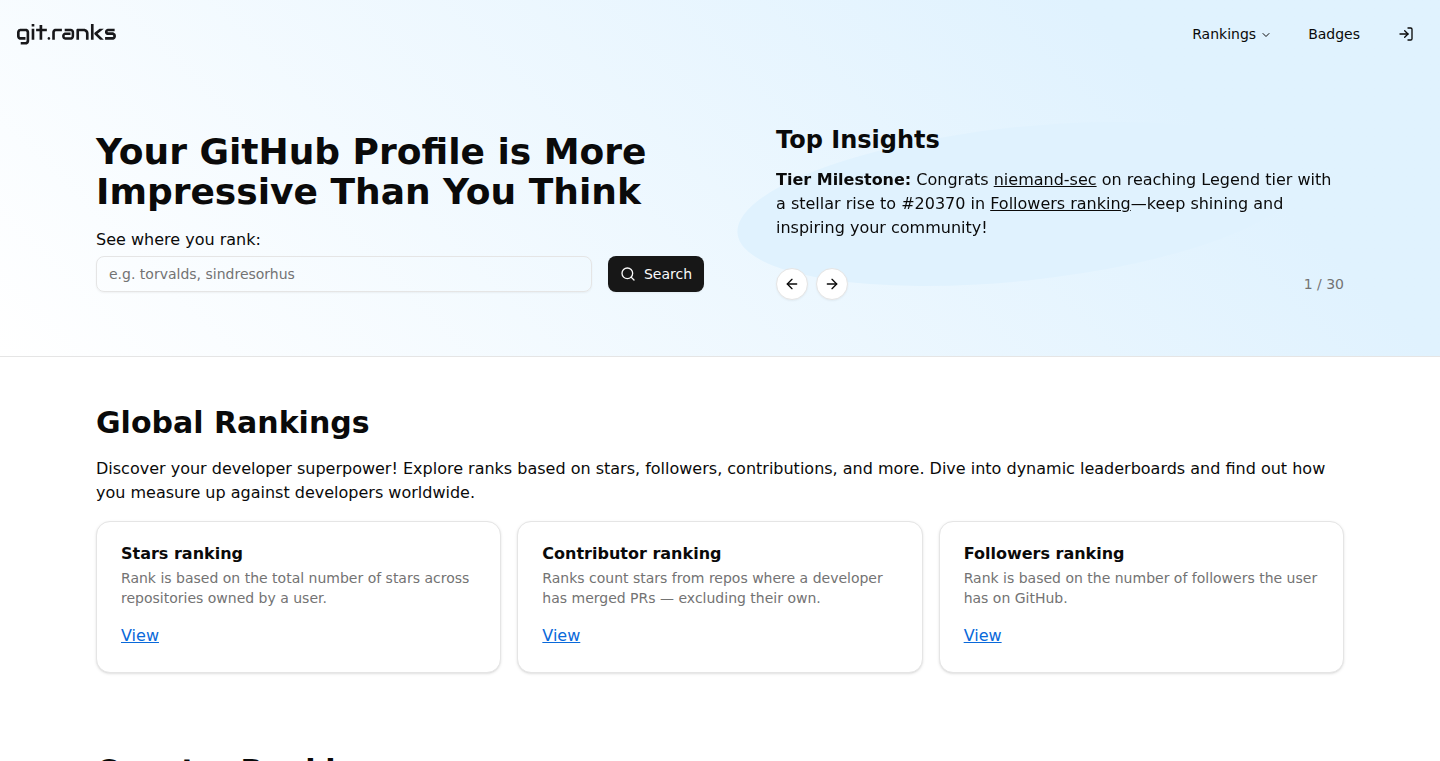
Author
maslianok
Description
GitRanks is a platform that analyzes GitHub profiles to provide developers with a 'scorecard' showcasing their contributions, popularity, and overall impact within the open-source community. It leverages a robust backend built with MongoDB, NestJS, BullMQ, and GraphQL to gather and process data from millions of GitHub profiles, organizations, and repositories. The front-end, developed using Next.js, Tailwind, and Shadcn, presents this data in a user-friendly way, including live leaderboards and personalized rankings. The core innovation lies in its ability to quickly assess a developer's presence and compare it to others based on key metrics. This includes providing real-time rankings and insights, making it easy to track progress and discover emerging talents. So, it allows you to gauge your impact in the open-source community and understand your strengths compared to others.
Popularity
Points 2
Comments 0
What is this product?
GitRanks is a service that crunches data from GitHub to give developers a clear picture of their impact in the open-source world. It's like a leaderboard for developers, ranking them based on things like how many stars their projects have, how much they contribute, and how many followers they have. The backend uses a database called MongoDB to store all the GitHub data. It uses NestJS, which helps organize the code, and GraphQL to fetch the data efficiently. BullMQ is used for handling tasks that take time. The front-end uses Next.js, which makes the website fast, Tailwind for styling, and Shadcn to help with user interface components. It processes and presents this information in a visually appealing way, allowing developers to track their performance, find out where they stand globally and nationally, and discover other developers. This whole process happens daily so you have up-to-date information. So it gives you a snapshot of your GitHub activity and helps you understand your influence in the open-source world.
How to use it?
Developers can simply visit the GitRanks website and view their profile data and rankings. The platform does not require any special installations or integrations on the developer's end. You just need a GitHub account. The core is the website itself where you can see your ranking. The service can be used by developers to track their rankings, discover rising developers, and analyze their GitHub activity compared to others. So, you get a clear view of how you are performing in the open-source community.
Product Core Function
· GitHub Data Aggregation: GitRanks gathers data from millions of GitHub profiles, organizations, and repositories. This involves using APIs to collect various data points like stars, contributions, and followers. This allows for a comprehensive view of each developer's activity. So you get a complete picture of your GitHub data.
· Profile Scoring and Ranking: The platform processes the gathered data and assigns each developer a 'scorecard' based on various metrics, which are then ranked on leaderboards. This enables developers to compare their performance to others. So, you will see how you stack up against other developers.
· Leaderboard Functionality: GitRanks features live leaderboards, enabling users to view developer rankings. These leaderboards can be filtered by various criteria, such as worldwide rankings or country-specific rankings. So, you can easily find out where you stand in the community.
· Daily Refresh: The platform refreshes its data daily. This ensures that the rankings and profile information are up-to-date, so users don’t have to wait long to see their progress. So you can see your progress daily.
· Discovery of Developers: The tool helps users discover other developers and follow their work. This feature helps to find new collaborators and keep up with other developers in the community. So, you can find new projects and developers to follow.
Product Usage Case
· Open Source Contributions Tracking: A developer uses GitRanks to track their contributions to various open-source projects, monitoring the growth of their projects' stars and the overall impact of their contributions on the community. So, the developer gets a clear view of their contributions over time.
· Performance Evaluation: A developer uses GitRanks to compare their profile with others in their field, assessing their ranking against industry benchmarks. This is useful to discover areas for improvement, or find the most popular projects. So, a developer can assess their performance.
· Community Engagement: A developer uses the platform to discover and follow rising developers, expanding their network and finding new collaborators for projects. This will help the developer to get more involved in the community. So, a developer can connect with and discover other developers in their field.
· Job Hunting: A developer can use the GitRanks data as a reference when creating their resume. This way, they can provide a more realistic view of their skills and contributions. So, a developer can make his resume more attractive.
45
Tygra: Local AI Document Processor
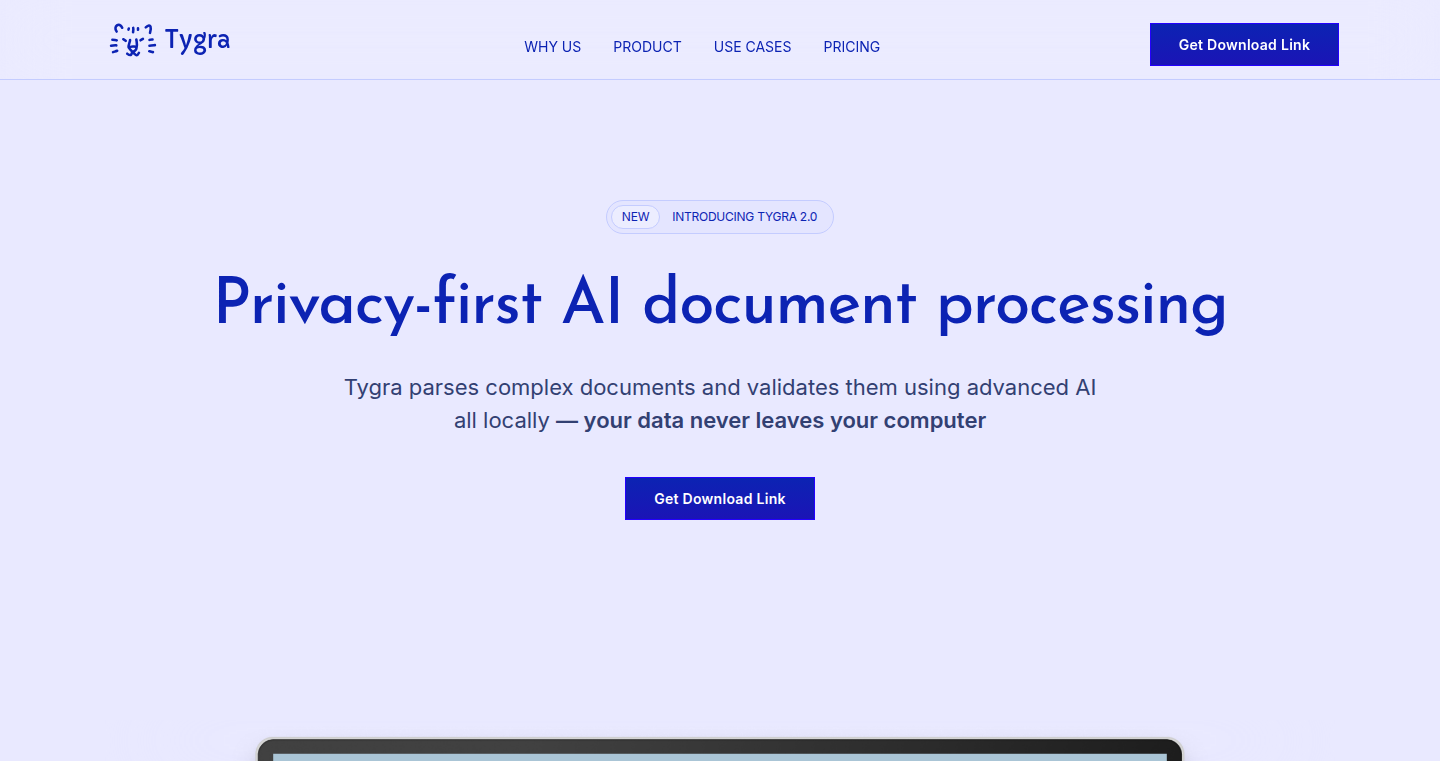
Author
tygra
Description
Tygra is a privacy-focused AI document processing tool designed for macOS (with Windows support planned). It allows you to automatically parse and validate documents (PDF, JPG, PNG) directly on your computer, leveraging the power of Mistral models. The key innovation is its commitment to user privacy: all processing happens locally, ensuring your sensitive data never leaves your device or network. This solves the growing concern of data security when using cloud-based AI document processing services. So this means your private documents stay private.
Popularity
Points 2
Comments 0
What is this product?
Tygra is a desktop application that uses Artificial Intelligence to read and understand your documents. It's different because it runs entirely on your computer. This is a big deal for privacy because your documents never need to be sent to the internet. It uses a type of AI called 'Mistral models', which are powerful language models, to analyze the text and images in your documents. Think of it as having a smart assistant on your computer that can read and summarize your documents. So this gives you control over your data.
How to use it?
Developers can use Tygra to build custom workflows for document processing. Imagine integrating it into your application to automatically extract information from invoices or contracts. You can upload a PDF, JPG or PNG and then automatically extract text, summarize the document, or validate the contents. This is achieved via direct API calls or through a command-line interface. For instance, a developer working on an accounting system could use Tygra to automatically extract the important details from uploaded receipts, without needing to send the receipt data to a third-party service. So this simplifies document automation.
Product Core Function
· Local Document Parsing: Tygra parses documents directly on your machine. This means no data ever leaves your computer, greatly enhancing privacy. Application: Securely process sensitive documents like medical records or financial statements.
· AI-Powered Analysis: Utilizes AI models (Mistral models) to extract information, summarize content, and validate document integrity. Application: Quickly get the key insights from lengthy reports or contracts without manual reading.
· Format Support: Works with PDF, JPG, and PNG files. Application: Process a wide range of document types, making it useful for diverse applications from image recognition to invoice processing.
· Privacy-First Design: Designed with privacy as the top priority, processing all data locally. Application: Suitable for handling confidential documents or information where data security is paramount.
Product Usage Case
· Secure Invoice Processing: An accounting software developer integrates Tygra to automatically extract key data from invoices stored locally on a user's computer. Tygra securely parses the invoice image and populates the necessary fields in the accounting system. This avoids sending the invoice data to a cloud service. So this gives you better security.
· Legal Document Review: A legal tech startup uses Tygra to automatically analyze and summarize legal documents for attorneys. Tygra processes the documents locally, allowing the attorneys to maintain full control over sensitive legal information. So this speeds up legal workflows.
· Research Paper Summarization: A student uses Tygra to summarize research papers, ensuring the research papers are processed locally. Tygra extracts the important findings. So this helps you avoid sharing sensitive research.
46
Open LLM Spec: Universal Language for Large Language Models
Author
gpt4o
Description
This project tackles the problem of inconsistency when interacting with different Large Language Models (LLMs) like GPT-4, Claude, and Gemini. Each model uses different formats for receiving instructions (prompts, temperature settings) and delivering responses (metadata, error messages). Open LLM Spec proposes a standardized way to communicate with any LLM, making it easier to switch providers and build tools that work across different models. This is achieved by defining a universal language (specifications) for inputs and outputs. So, it allows developers to focus on their core application logic instead of getting bogged down in the details of each LLM's proprietary API.
Popularity
Points 1
Comments 1
What is this product?
Open LLM Spec is a set of rules that ensures consistent communication with different LLMs. Imagine it like a universal translator for these models. The project standardizes the format of the information you send to the LLMs (input) and how they respond (output). The project uses JSON format to achieve this. This means all the different LLMs 'speak' the same language, allowing developers to build more adaptable and efficient applications. So, you can easily switch between different AI models without completely rewriting your code.
How to use it?
Developers use Open LLM Spec by integrating it into their code. Instead of directly interacting with the specific API of an LLM (e.g., OpenAI's GPT-4), they use the standardized format defined by Open LLM Spec. This framework handles the translation to and from the specific LLM. The implementation is usually done through libraries or SDKs that developers can easily incorporate into their projects. So, you can quickly swap between LLMs by changing the settings in the code.
Product Core Function
· Standardized Input Format: Defines a consistent structure for sending requests to LLMs. This includes specifying the model to use, the task to perform (e.g., question answering), the prompt, and any parameters like temperature (which controls the randomness of the response). So, you can easily control and configure different LLMs using the same set of parameters.
· Standardized Output Format: Provides a consistent structure for how LLMs return responses. This includes the content of the response and metadata like the number of tokens used and confidence levels. So, you can easily process the results from any LLM in the same way, regardless of the provider.
· Vendor-Neutral Interoperability: This is the core of the project. It allows developers to switch between different LLM providers without changing their code significantly. So, if one LLM has a performance problem or pricing issue, it’s easy to switch to another.
· Open and Community-Driven: The specification is open, meaning anyone can contribute to it. Developers can suggest new fields, discuss requirements, and share their real-world needs. So, the project adapts to the needs of the community and incorporates new features to evolve with new LLMs.
Product Usage Case
· Building Cross-LLM Applications: Develop an application that uses the best features of different LLMs. For example, you can use one LLM for general text generation and another for specialized tasks like code completion. The standardization allows you to combine the different models without dealing with the integration details of each of their API. So, your application can be very powerful, efficient and optimized to cost and performance.
· Creating Universal Middleware: Design a middleware layer that sits between your application and the various LLMs. This layer handles the communication with each LLM using the Open LLM Spec, so the core application code doesn't need to know the specific details of each LLM. So, this makes it easier to maintain, update, and integrate new LLMs.
· Developing Tooling for LLMs: Build tools that work with all LLMs. For instance, create a tool that analyzes the outputs of any LLM based on a standardized format. You can develop analytics, monitoring, and debugging tools that work across the board. So, you can more efficiently manage and improve your work with LLMs.
· Simplifying Migration: Migrate an existing application from one LLM to another with minimal code changes. By adhering to the Open LLM Spec, the migration process becomes significantly easier since the communication layer can be easily adapted without modifying the main application logic. So, you can save time and reduce risks when adopting new technologies.
47
Kriegspiel Tic Tac Toe: The Fog of War Edition
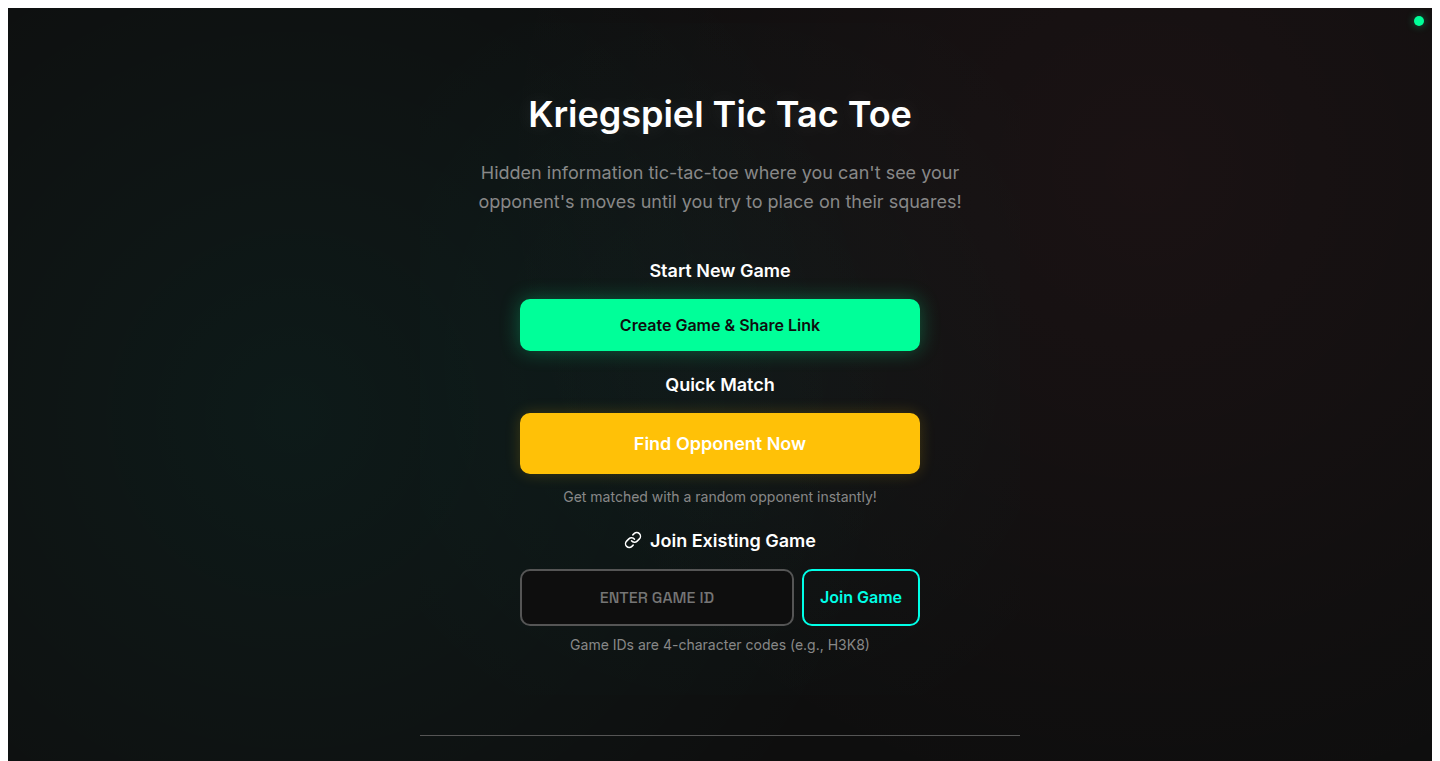
url
Author
fishtoaster
Description
This project reimagines the classic Tic Tac Toe game, transforming it into a 'hidden information' game. Instead of seeing the entire board, players only get partial information, simulating a fog of war. This adds a layer of strategy and deduction, similar to the board game Kriegspiel. The developer built this as a two-player, online, asynchronous game. It's a clever example of applying game design principles to create a more challenging and engaging experience, and a great way to explore the concepts of imperfect information in a simple game.
Popularity
Points 2
Comments 0
What is this product?
This is a version of Tic Tac Toe where you don't see the whole board! Imagine playing the game with limited visibility. You can only see the moves you've made and a bit about your opponent's moves. This uses the concept of 'hidden information' or 'fog of war' commonly found in strategic games. The technology behind this involves how the game tracks and reveals information to each player. The system handles the exchange of moves and provides a limited view of the board, creating uncertainty and requiring players to deduce the opponent's strategy. So this is like a more complex Tic Tac Toe, where you need to think more about what you *don't* know. So this is a fun game to play and demonstrates how to create a game with limited information.
How to use it?
Developers could use this as a starting point for building their own games with hidden information mechanics. You can study the codebase (available on Github) to understand how the game logic and player communication are handled. This project demonstrates a way to implement asynchronous gameplay (turns don't need to be taken simultaneously). You could adapt the core logic to build other similar games, perhaps even adding a new layer of complexity. For example, you could modify it to be used in the development of more intricate strategy games. Also you can simply play the game with friends! So you can learn how to build a game with hidden information.
Product Core Function
· Asynchronous Game Play: The game supports turns taken at different times, allowing players to play at their own pace. This is achieved through a backend system that stores the game state and updates it as players make moves. So this is useful for building games that don't require real-time interaction, which improves player experience.
· Partial Information Display: Players are only shown a limited view of the board, creating a sense of uncertainty and requiring players to use deduction and strategy. The code manages what information each player is allowed to see, simulating the fog of war effect. So this is perfect for creating a more challenging game where you need to use your brain to think.
· Online Multiplayer: The game is designed for two-player online play. This involves communication of the game state and the user's moves between two players. This is achieved through an API to help with handling the exchange of data between players. So this is essential for creating online experiences.
· Game Logic: The core game mechanics, including move validation, win condition checking, and turn management, are all implemented. This ensures the smooth and fair operation of the game and provides the basis for other games. So this is important for implementing the game's rules and ensuring a fair experience.
Product Usage Case
· Game Development Training: A game developer learns how to build a multiplayer game with hidden information, studying the project's code to understand game logic, user interface, and communication between players. So this is helpful for people learning to develop games.
· Educational Game Design: An educator creates an interactive game that demonstrates concepts of strategy, probability, and incomplete information. The project's code offers a working example to showcase how to implement such mechanics. So this is useful for teaching about game design principles.
· Strategic Thinking Practice: Players use the game as a fun way to practice strategic thinking and deduction skills. The fog of war element encourages players to analyze limited information and anticipate their opponent's moves. So this is a fun way to improve your brainpower.
· Building other board games: Developers leverage the project as a foundation for developing more complex board games with asynchronous multiplayer capabilities and hidden information. So this can be used as a starting point for other games.
48
Asdflo - Autism Support Platform
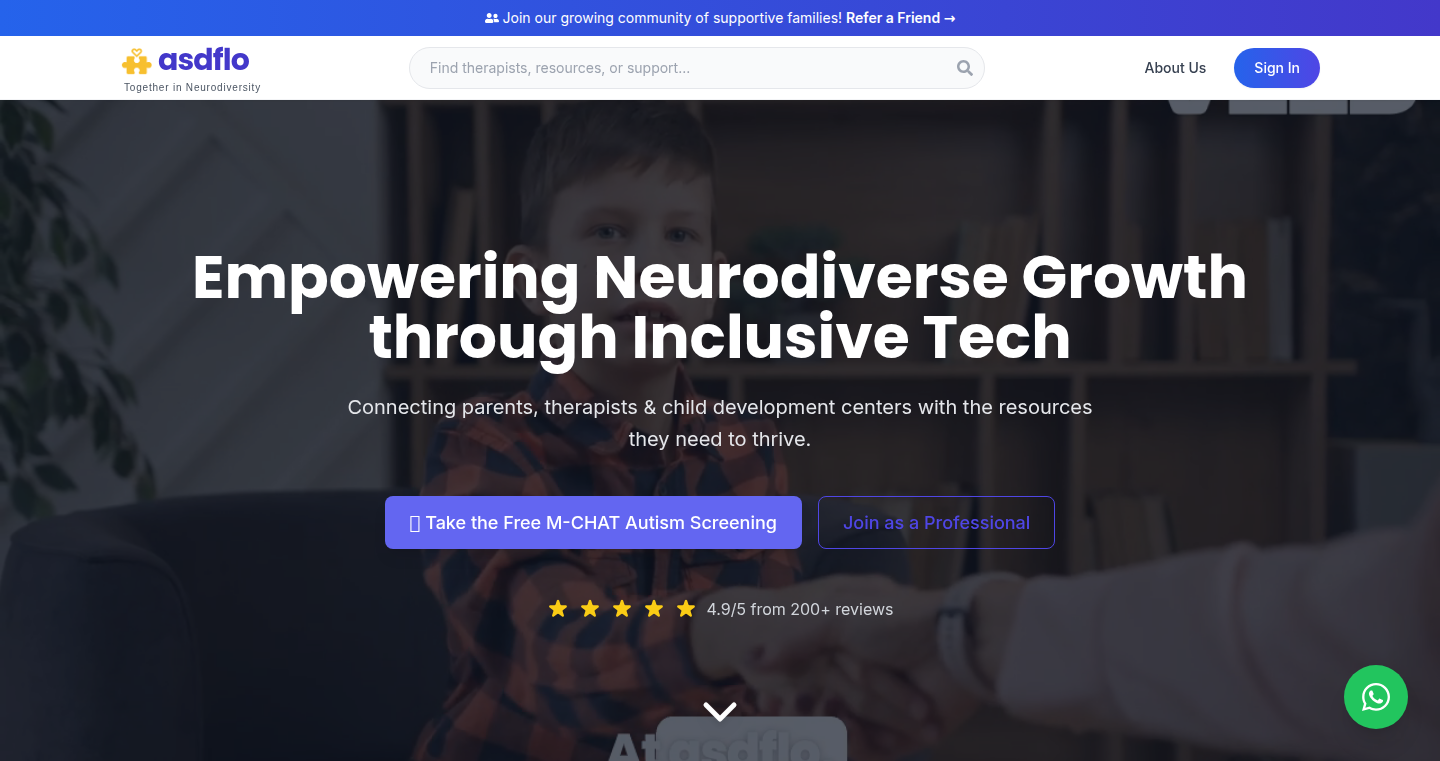
Author
impramk
Description
Asdflo is a free platform designed to support individuals with autism through assessments and therapy tracking. It's innovative because it provides a centralized system for managing and analyzing data related to autism, allowing for better tracking of progress and personalized interventions. The core technology focuses on providing a user-friendly interface for collecting and visualizing data, making complex information accessible to both professionals and families. It tackles the problem of fragmented data and lack of easily understandable insights in autism support.
Popularity
Points 2
Comments 0
What is this product?
Asdflo is essentially a digital toolset for autism support. Think of it as a hub where you can store assessments, track therapies, and see how the individual is progressing over time. The innovation lies in its focus on data visualization and making complex information accessible. It uses the principles of data science to help families and therapists understand the impact of different interventions. So this helps them make informed decisions and optimize care.
How to use it?
Developers don't directly 'use' Asdflo in the traditional sense. However, they could potentially contribute to the platform's open-source code, or build integrations using its API (if available). Families and therapists use the platform to input assessment results, track therapy sessions, and monitor progress over time. So, this tool supports more effective data-driven interventions.
Product Core Function
· Assessment Management: The platform likely allows users to store and manage various assessment results (e.g., questionnaires, observations). The value lies in providing a centralized repository for this information, making it easier to track changes over time and identify patterns. This enables a holistic view of the individual's needs and progress. So this helps identify areas that need more support.
· Therapy Tracking: Asdflo will likely enable users to track different therapy sessions, recording details such as the type of therapy, duration, and outcomes. The value here is in providing a clear picture of which therapies are most effective. This leads to optimized treatment plans tailored to the individual's needs. So this helps maximize the benefits of the therapies being implemented.
· Progress Visualization: The platform probably provides charts and graphs to visualize progress over time, making it easier to understand how the individual is developing. The value is that it transforms complex data into easily understandable insights. This allows families and therapists to readily assess progress and make necessary adjustments to the care plan. So this helps everyone to understand and be on the same page regarding the individual's development.
· Data-Driven Insights: Asdflo should offer the ability to analyze the collected data to identify trends, patterns, and correlations. This could involve comparing the effectiveness of different therapies or identifying factors that contribute to progress or challenges. The value is that it provides evidence-based insights to guide care. So this helps make informed decisions based on data, improving outcomes.
· Personalized Interventions: Based on the insights derived from the data, the platform likely supports creating and adapting personalized intervention plans. The value is that it ensures interventions are tailored to the individual's specific needs and challenges. So this helps to maximize the effectiveness of support and improve the quality of life.
Product Usage Case
· A therapist uses Asdflo to track a child's progress in speech therapy, comparing the child's communication skills before and after the therapy. The tool provides visualizations showing improvements in communication, allowing the therapist to adjust therapy techniques for better outcomes. So this allows for real-time adjustments based on the child's needs.
· A parent uses Asdflo to monitor their child's behavior patterns and identify triggers for meltdowns. By tracking these events over time, the parent can work with the child's therapist to develop strategies to manage these challenges. So this tool will offer a better quality of life to both the parents and the child.
· A researcher uses the platform to collect and analyze data from multiple individuals, identifying common challenges and effective interventions. This data can be used to improve autism support programs and inform the development of new therapies. So this helps to advance research in autism and improve care for everyone.
49
JiraDeck: Automated Slide Deck Generator from Jira Backlogs
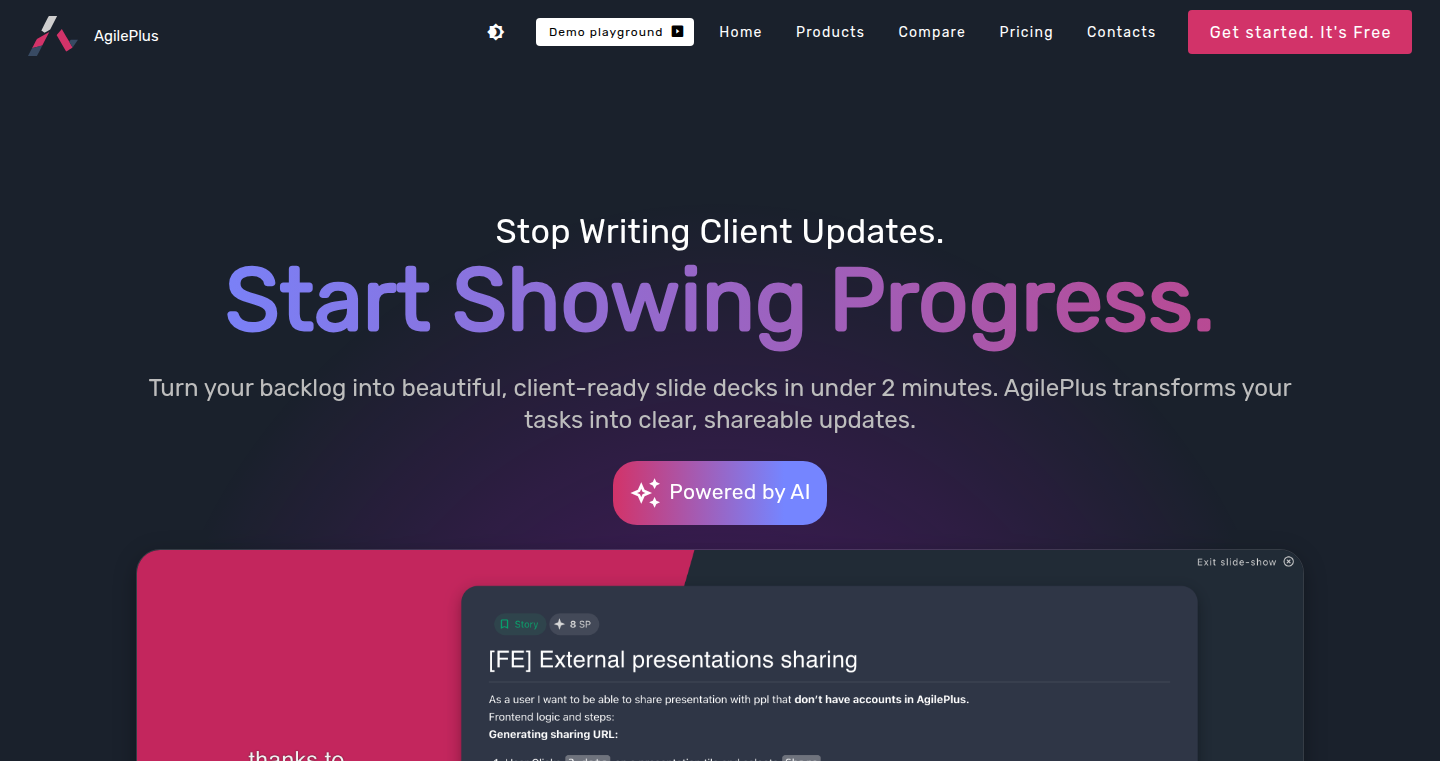
Author
anthonyag
Description
JiraDeck is a tool that automatically converts your Jira backlog items into client-ready slide decks. It leverages the structured data within your Jira tickets, like issue descriptions, statuses, and assignees, and transforms it into a visually appealing presentation. The innovation lies in automating a traditionally manual and time-consuming process, freeing up developers and project managers from tedious report creation and allowing them to focus on actual project work.
Popularity
Points 2
Comments 0
What is this product?
JiraDeck uses the information already in your Jira tickets (like task descriptions, deadlines, who's responsible, and the status of each task) and automatically formats it into slides. It’s like having a robot that builds your presentation for you! This is innovative because it removes the repetitive task of manually copying and pasting Jira information into slides, which is a big time-saver.
How to use it?
Developers would use JiraDeck by connecting it to their Jira instance. They would then select the Jira project and the relevant issues they want to include in the presentation. JiraDeck then automatically generates a slide deck (e.g., in PowerPoint or Google Slides format) that can be easily shared with clients or stakeholders. This is useful when presenting project status updates, sprint reviews, or any other situation where you need to communicate project progress in a visual and easily digestible format. It integrates into your workflow by simply requiring you to specify the Jira data you want to represent. So, what's the result? You save hours, and you get a ready-made presentation instantly.
Product Core Function
· Automated Data Extraction: JiraDeck parses the data within Jira tickets. This includes issue summaries, descriptions, status updates, assigned individuals, and any custom fields you might have. This means no more manual data entry; the tool automatically grabs what it needs from Jira. So what? This functionality saves you time and reduces errors associated with manual data transfer.
· Templated Slide Generation: The tool uses pre-designed templates to generate slides. These templates likely include different layouts for various types of Jira data (e.g., a task overview slide, a progress report slide, a risk assessment slide). This ensures a professional and consistent presentation, even with minimal input. So what? You get professional-looking presentations with no design effort.
· Customization Options: Users can customize the slide deck’s appearance, potentially including branding elements (company logos, color schemes), slide ordering, and specific issue selections. This allows the generation of presentations that align with specific reporting needs. So what? Tailor-made presentations that match your project’s requirements.
· Export and Sharing: JiraDeck likely allows for easy export of the slide deck in common formats such as PowerPoint or Google Slides, and facilitates the easy sharing of the deck with team members or clients. It helps teams to effectively communicate project information without having to manually recreate it in presentation form. So what? Easy presentation sharing leads to faster project communication.
Product Usage Case
· Sprint Review Presentations: A development team can use JiraDeck to automatically generate slides summarizing the work completed during a sprint, highlighting key accomplishments, and any challenges faced. This ensures that the review meeting is informed, visually appealing, and uses accurate data pulled directly from Jira. So what? Faster sprint reviews with ready-made presentations.
· Client Status Updates: Project managers can use JiraDeck to provide clients with regular project updates. The tool can quickly generate slides showing progress against project goals, highlighting completed tasks, and outlining upcoming activities. These updates are tailored to clients’ needs and are easy to understand. So what? Happier clients due to clear, concise, and up-to-date reports.
· Project Kick-off Meetings: During project kick-offs, JiraDeck can quickly create a presentation summarizing the project scope, key tasks, team members, and timelines. This allows the team to quickly get an overview of the project and ensure everyone is on the same page. So what? Efficient and clear project kick-offs with easy-to-understand summaries.
· Internal Reporting: Teams can use JiraDeck for internal reporting purposes, for example, to show progress to senior management. The tool can produce visualizations that highlight project bottlenecks and provide data-driven insights into project efficiency. So what? Easier internal reporting means quicker insights and better decision-making.
50
Realer Estate: AI-Powered NYC Apartment Deal Finder

Author
realerestate
Description
Realer Estate is a platform that leverages Artificial Intelligence (AI) to help renters in New York City find undervalued apartments, especially those that are rent-stabilized and often overlooked. It tackles the problem of rapidly disappearing good deals in the competitive NYC housing market. The system uses Natural Language Processing (NLP) to identify rent-stabilized listings (even when not explicitly labeled), analyzes pricing anomalies, and assesses price-to-market ratios. It also filters out properties aimed at investors to prioritize opportunities for everyday people. This project highlights the power of applying AI to real-world problems, making the daunting process of apartment hunting more efficient and accessible.
Popularity
Points 2
Comments 0
What is this product?
Realer Estate is a web application that uses AI to find the best apartment deals in NYC. It employs several innovative techniques: Firstly, it uses NLP to understand the text descriptions of apartment listings from sites like StreetEasy and Redfin to identify rent-stabilized apartments, which are often hidden. Secondly, it analyzes pricing data, comparing the listed price to similar apartments in the area, and identifies deals that seem undervalued. Thirdly, it filters out properties likely to be flipped by investors, focusing on those suitable for actual renters. This uses a combination of techniques like web scraping and data analysis, all working together to provide a clearer view of the market. So this helps you by finding deals you might otherwise miss.
How to use it?
Renters can visit the Realer Estate website and search for apartments based on their criteria (location, price, etc.). The platform will then use its AI algorithms to analyze listings and show users apartments it identifies as potentially undervalued or rent-stabilized. The platform scrapes data daily from popular real estate websites. The alerts feature offers early access to the best deals. The integration is simple: just visit the website and start searching. So, it allows renters to save time and potentially money by identifying hidden opportunities.
Product Core Function
· Rent-Stabilized Listing Detection using NLP: The system uses Natural Language Processing (NLP) to analyze the text descriptions of apartment listings. It identifies rent-stabilized apartments by detecting keywords and phrases that often indicate these types of units, even if the landlord doesn't explicitly mention it. This is valuable because rent-stabilized apartments are often cheaper and provide more long-term security for renters. So, you can find apartments that are generally more affordable and offer better terms.
· Price-to-Market Ratio Analysis: The platform analyzes current market data (comps) to determine if a listed apartment's price is a good value. This helps users quickly identify deals that are priced below market value. This is valuable as it helps users quickly find apartments that are potentially much more affordable than other similar properties. So, you can quickly find apartments that offer good value for money.
· Investor-Targeted Property Filtering: The system aims to identify and filter out properties that are likely being marketed towards investors for flipping rather than for renting. This prioritizes listings that are most suitable for regular renters. This is useful because it ensures that you are focusing on apartments that are legitimately available for long-term rentals. So, you are less likely to waste time looking at properties that aren't a fit.
· Daily Data Scraping and Updates: The platform automatically gathers data from popular real estate websites like StreetEasy and Redfin on a daily basis. This ensures that the information is current and that users have access to the latest listings. This is important because the real estate market changes rapidly. So, you get access to the newest listings on a regular basis.
Product Usage Case
· Finding Hidden Rent-Stabilized Units: A user searches for apartments in a specific neighborhood. The platform identifies several apartments that the user might have missed because the listings do not explicitly mention rent stabilization. So, the platform finds apartments that fit the user's requirements and are more affordable, helping them save money and secure housing in their chosen neighborhood.
· Spotting Undervalued Properties: A user is looking for a 1-bedroom apartment. The platform identifies an apartment priced lower than comparable apartments in the same building and area, indicating it's a good deal. This allows the user to find housing at potentially lower prices than otherwise available in the market.
· Prioritizing Properties for Renters: A user searches for an apartment, and the platform filters out properties that are likely intended for flipping. This ensures that the user's search results focus on apartments that are suitable for renting and avoids wasted time. So, the user finds suitable apartments more efficiently.
· Keeping Users Up-to-Date: The platform automatically updates listings every day. This ensures that a user receives the newest results and can stay abreast of rapidly changing market dynamics. So the user has access to the most current options available.
51
Duende: AI-Powered Code Assistant with Gemini
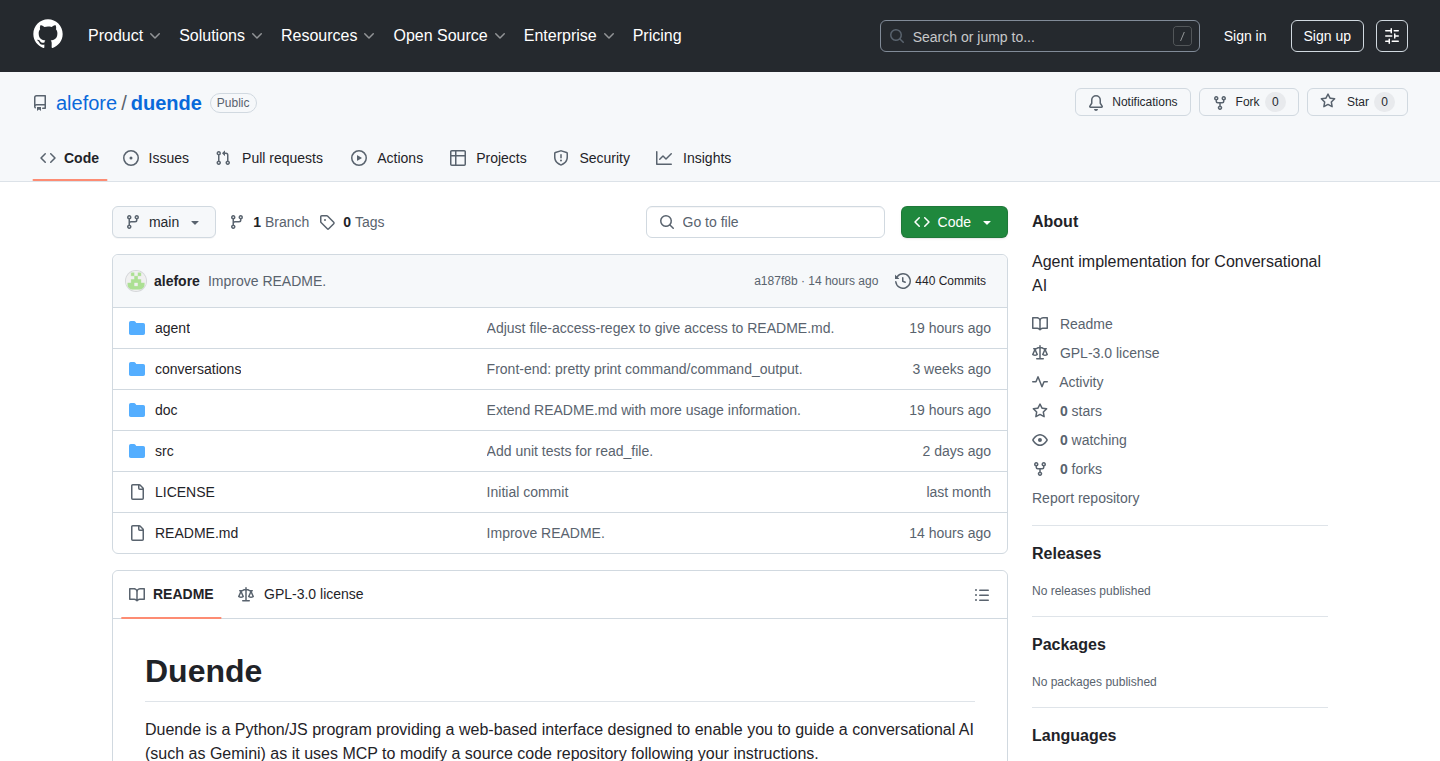
Author
afc
Description
Duende is a web-based user interface that helps developers collaborate with Google's Gemini AI to write and refine code. It allows developers to guide the AI through coding tasks, observe the conversation, and provide feedback. The core innovation lies in its 'review' mode, which spawns multiple evaluation conversations focused on specific aspects of the code, such as the introduction of unnecessary comments. This approach improves code quality and accelerates the development process.
Popularity
Points 2
Comments 0
What is this product?
Duende is a tool that acts as an intelligent assistant for developers. It uses the power of Google's Gemini AI to help write, review, and improve code. Think of it as having a coding partner who can explain its reasoning, take suggestions, and even critique its own work. The user interface lets you chat with the AI, provide feedback, and see how it's working on your code step by step. The tool also includes a unique feature called the 'review' mode, which automatically checks the code from different angles, such as if it has any bad comment.
How to use it?
Developers can use Duende by specifying a coding task and then guiding Gemini AI through the process. You can provide instructions, feedback, and suggestions during the conversation. Duende's interface allows developers to observe the AI's responses and make corrections. It's like having a conversation with a coding expert, with the ability to steer the process. The project is designed to be used in pair-programming style with the AI.
Product Core Function
· Interactive Coding Assistance: This allows developers to converse with the Gemini AI, providing instructions and receiving code suggestions in real-time. This is useful for brainstorming ideas and finding new ways to solve problems.
· Guidance and Feedback: Developers can provide feedback to the AI during code generation, guiding it towards desired outcomes and correcting errors. This is useful for making sure the AI understands exactly what the user wants.
· Review Mode: This automatically generates multiple conversations to evaluate the AI's code from different angles, such as code style and commenting. This is useful to automatically check the code's quality and make sure it's well-written.
· Iterative Development: Duende supports iterative development, allowing developers to continuously refine and improve their code with AI assistance. This is useful for getting a better result each time.
· Context Management: Duende lets you set up initial context, define validation rules, and provide review guidelines to the AI to improve the quality of the code generated. This is useful for improving the accuracy and relevance of the AI's responses.
Product Usage Case
· Feature Development: A developer can use Duende to add new features to an existing project, by providing instructions on the desired functionality. The AI then generates code based on the instructions, which the developer can review and refine. This is useful for saving time and boosting productivity, as the AI provides the base code and the developer focuses on fine-tuning it.
· Code Refactoring: Developers can use Duende to improve the quality and structure of their code. By feeding existing code to the AI, the user can ask for suggestions about improving its structure or removing unnecessary code. This is useful for reducing technical debt and increasing maintainability.
· Learning and Experimentation: Developers can experiment with new programming techniques and concepts using Duende. The AI can provide examples and explanations, helping developers understand how different approaches work. This is useful for learning how to code more efficiently and effectively.
52
Viiew: Terminal-based Data Viewer

Author
codingfisch
Description
Viiew is a Terminal User Interface (TUI) tool that allows you to easily view and explore your data directly within your terminal. It focuses on providing an interactive and efficient way to inspect data structures, especially useful when debugging or analyzing data without leaving the command line. The core innovation lies in its ability to visualize data in a terminal environment, offering an alternative to traditional debugging methods that often involve print statements or separate GUI tools.
Popularity
Points 2
Comments 0
What is this product?
Viiew works by taking your data, which can be anything from a simple list to a complex data structure (like a Python dictionary or JSON), and displaying it in a navigable, interactive terminal interface. The technology behind it relies on libraries that are able to render interactive elements within the terminal, providing features like expanding/collapsing data, searching, and filtering. This allows you to see your data in a structured format, making it much easier to understand and debug than just printing raw data to the console. So what's in it for me? You can visualize the data in a neat terminal interface, simplifying your debugging process.
How to use it?
Developers can use Viiew by simply passing their data to it. The data can be in various formats such as a Python dictionary, a JSON file, or even a custom data structure. You typically integrate Viiew into your existing code by calling the function, and it will then open the terminal interface. This can be integrated with your existing development environment to inspect data during runtime. So how do I use it? Pass the data to Viiew, and the terminal-based interface will show up.
Product Core Function
· Interactive Data Exploration: Viiew lets you browse complex data structures with ease. By providing an expandable/collapsible view of your data within the terminal, it significantly simplifies the process of understanding and debugging data, especially useful for applications processing JSON or other structured data. For example, when debugging a web API response, the developer can quickly expand each level of the JSON structure, making it easy to identify and understand the data.
· Data Visualization: This tool allows users to visualize data within the terminal. This feature removes the need to use external debugging tools or print statements, providing a much cleaner and more efficient debugging experience, especially in a remote server environment where a GUI is unavailable. This lets you quickly spot errors and unexpected values in your data, saving valuable debugging time.
· Terminal-based Operation: Since it works entirely within the terminal, Viiew seamlessly integrates into existing development workflows. You can debug, analyze data, and do all the necessary actions without ever leaving the terminal. If you are a developer who prefers working in the terminal, this is a huge time saver. It is particularly beneficial when working on remote servers or within containerized environments where a GUI might not be readily accessible.
Product Usage Case
· Debugging APIs: When developing APIs, you often need to inspect the data being sent and received. Viiew enables developers to quickly view the structure and content of the API responses and requests directly in the terminal, simplifying the debugging process and allowing for quick identification of issues.
· Data Analysis: When analyzing data stored in dictionaries or JSON formats, Viiew is really helpful. Developers can use it to explore data structures, identify patterns, and validate the data without writing custom code to print the data to the console.
· Log Inspection: Developers can use Viiew to view and analyze complex log files. By quickly exploring the logged data structures, developers can quickly identify any errors or unexpected events that occurred, making it an effective log analysis tool.
53
DetoxDroid: Granular App Time Management with Auto-Greyscale

Author
aygeaye
Description
DetoxDroid is an open-source Android application designed to help users manage their app usage in a more nuanced way than the built-in Digital Wellbeing features. Instead of disabling entire apps or greyscaling the whole system, DetoxDroid allows users to set time limits for individual apps. Once the time limit is reached, the app automatically greyscales itself, making it less appealing to use. This addresses the common problem of getting trapped in endless scrolling, while still allowing access to important features like direct messages. This project's innovation lies in its granularity and its ability to work without root access, leveraging the WRITE_SECURE_SETTINGS permission to control the app's visual state.
Popularity
Points 2
Comments 0
What is this product?
DetoxDroid is an app that provides fine-grained control over your app usage on Android. It allows you to set time limits for specific apps. When the time runs out, the app automatically turns grayscale, making it less enticing to keep using. The magic behind it is using the `WRITE_SECURE_SETTINGS` permission to control the visual appearance of individual apps without requiring root access. This means it can modify certain system settings, like color display for individual applications to nudge you away from overuse. So you have more control over which apps you want to limit and when. This is innovative because it provides a more user-friendly and practical approach to digital wellbeing compared to Android's built-in options.
How to use it?
Developers can use DetoxDroid to manage their own app usage or adapt the code for their projects. The app is open-source, so developers can audit the code for security and integrate it into other projects. Technically, you'll need to grant the app the `WRITE_SECURE_SETTINGS` permission. You can then set time limits for individual apps. Once the time limit is reached, the app automatically greyscales, or disables itself, creating a visual cue to help you step back from excessive usage. This is achieved by monitoring app usage and triggering the greyscale effect through system settings changes. So, developers can learn from the project's implementation, especially its use of specific Android APIs, or contribute to its development, ultimately improving their personal or professional digital habits.
Product Core Function
· Per-app time limits: This feature lets users set time limits for individual apps. This is valuable because it allows for a personalized approach to app usage, letting you control how much time you spend on each app.
· Automatic greyscale/disable on time limit: When the time limit is reached, the app automatically greyscales itself (or disables it). This technical implementation helps reduce the temptation to continue using the app by making it less visually appealing. This helps you curb your social media or game usage, by nudging you away from using them.
· No root access required: The app works without requiring root access on the device. This makes the app accessible to a wider audience and simplifies the installation process. This is a significant advantage because it maintains device security while providing the functionality.
· Open-source: Because it's open-source, developers can inspect and customize the app's code. This is valuable because developers can learn from the implementation details and potentially integrate parts of the functionality into their apps. This is a clear demonstration of the value of code-based problem solving within the open-source spirit.
· WRITE_SECURE_SETTINGS permission utilization: This project leverages the `WRITE_SECURE_SETTINGS` permission to change the app's visual state (greyscale) for individual apps. This demonstrates a clever use of system permissions to achieve a specific outcome without needing elevated access. This demonstrates how a developer could use standard permissions to solve a common issue.
Product Usage Case
· Personal digital wellbeing: Users can set time limits for distracting apps like social media. Once the time is up, the apps turn grayscale, making it easier to step away and focus on other activities. The app then assists users to reduce screen time and maintain a healthy work-life balance.
· Parental controls: Parents can use DetoxDroid to limit their children's app usage. They can set time limits for games or social media apps, encouraging a healthy balance of digital and non-digital activities. The developers can use the open-source code as a reference for building parental control features into their apps.
· Developer productivity: Developers can use DetoxDroid to limit their time on distracting apps during work hours. Setting time limits for social media or other non-work-related apps can help them stay focused and improve their productivity. This shows how the tool can be used by developers to stay on track and improve their own work routines.
54
StratoPi: Raspberry Pi's Journey to the Stratosphere
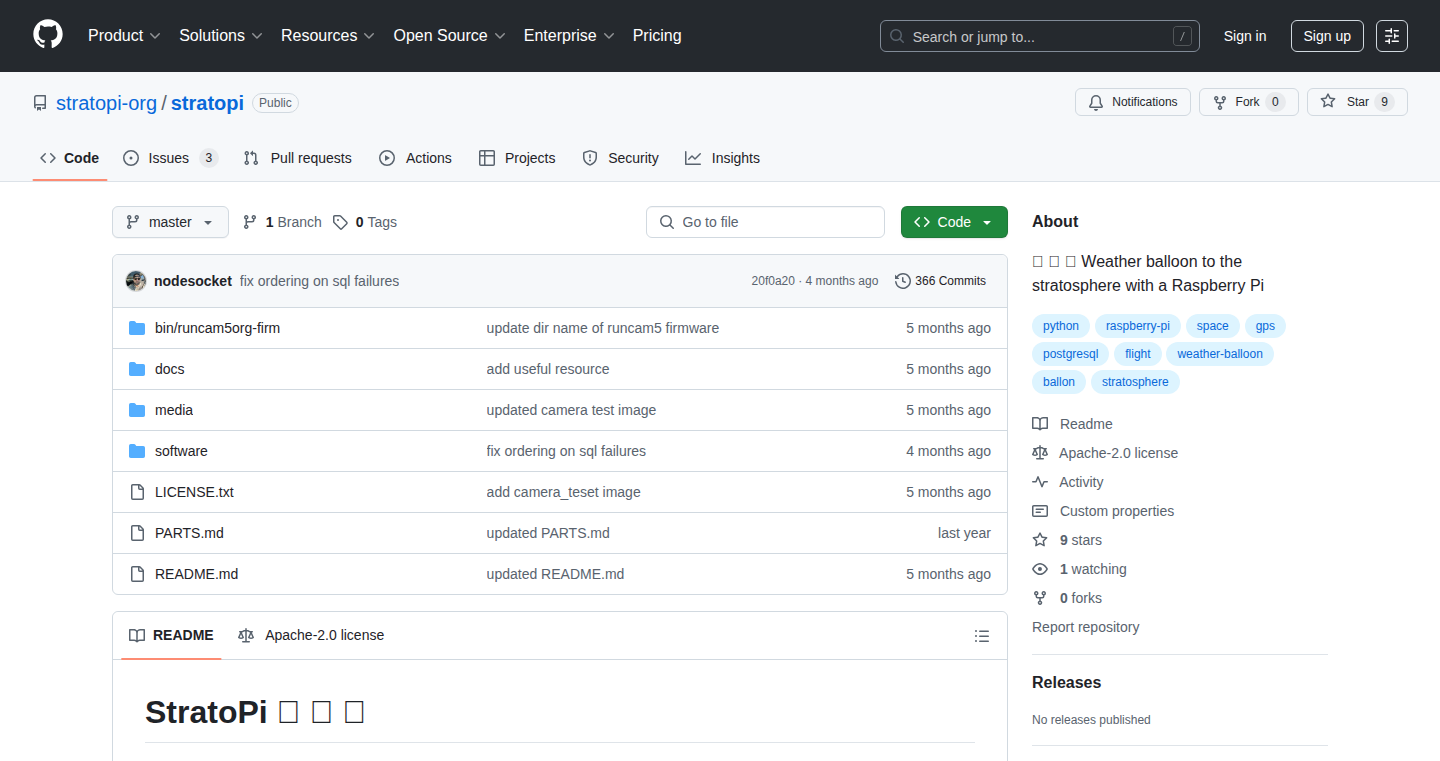
Author
nodesocket
Description
This project, StratoPi, is an open-source initiative that aims to launch a Raspberry Pi (a tiny computer) into the stratosphere (the high atmosphere). The core innovation lies in the design of a robust, lightweight, and cost-effective system capable of surviving the extreme conditions of near space, including intense cold, vacuum, and radiation. It tackles the technical challenge of sending delicate electronics into a hostile environment and retrieving them, opening up opportunities for scientific research and educational applications. Essentially, it's about democratizing access to high-altitude experiments. So what's the big deal? It lets anyone with some technical know-how conduct experiments at the edge of space without needing a massive budget or specialized equipment.
Popularity
Points 1
Comments 0
What is this product?
StratoPi is a DIY (do-it-yourself) project designed to send a Raspberry Pi to the stratosphere. It achieves this through a custom-built payload, which likely includes sensors, communication systems (like a radio transmitter for tracking), and a protective enclosure. The project's innovation is in the design of this payload: how to protect the Raspberry Pi from extreme temperature changes, the vacuum of space, and solar radiation. It uses readily available components and open-source designs, making it accessible to a wider audience. The key technology is the integration of multiple systems: power management, data logging, environmental protection, and communication. So what's the innovation? It makes high-altitude experiments cheaper and more accessible.
How to use it?
Developers can use StratoPi as a foundation for their own high-altitude experiments. They can adapt the existing design, modify the sensor suite, or integrate new components to collect specific data. For example, a developer might modify the payload to study atmospheric conditions, test new communication protocols, or even take high-resolution photos and videos from the stratosphere. They'd need to understand electronics, programming (likely Python for Raspberry Pi), and radio communication. The integration would involve assembling the payload, configuring the Raspberry Pi, and deploying the system using a weather balloon. So how can I use it? You can adapt it to build your own high-altitude research projects.
Product Core Function
· Environmental Protection: The project likely includes a carefully designed enclosure to shield the Raspberry Pi from extreme temperatures and the vacuum of space. This could involve insulation, thermal control, and pressure-resistant materials. This matters because it ensures the electronics function reliably in a hostile environment. So what's in it for me? It provides a blueprint for protecting sensitive equipment in extreme conditions.
· Data Acquisition and Logging: StratoPi is designed to collect data from various sensors, such as temperature, pressure, altitude, and GPS location. This data is stored on the Raspberry Pi and potentially transmitted back to Earth. This is valuable because it provides scientific data for research purposes and allows for the tracking of the payload's flight. So what's in it for me? It allows you to gather environmental data at high altitudes.
· Communication System: A radio transmitter (likely using amateur radio frequencies) allows the payload to be tracked and potentially transmit data back to the ground station in real-time. This helps in recovering the payload after landing. This is crucial for retrieving the data and ensuring the project's success. So what's in it for me? It provides a method for tracking and recovering experimental payloads.
· Power Management: The project must deal with providing power to the Raspberry Pi throughout the flight, which could last several hours. This involves the use of batteries and potentially solar panels. This is important for the project's longevity and reliability. So what's in it for me? It demonstrates best practices for powering electronics in remote environments.
Product Usage Case
· Atmospheric Research: A researcher could use StratoPi to collect data on temperature, pressure, and radiation levels at different altitudes, contributing to our understanding of the atmosphere and climate change. The developer can integrate specific sensors and customize data logging procedures to study the atmosphere. So how will it help me? I can contribute to climate change research using this project.
· Testing New Sensors: Developers can use StratoPi as a platform to test new types of sensors designed for environmental monitoring or scientific research, validating their performance under extreme conditions. They can use the payload to measure sensor accuracy and stability at high altitudes. So what will it do for me? I can use it to test my sensors in a real-world environment.
· Educational Projects: Teachers and students can use StratoPi to learn about electronics, programming, and atmospheric science in a hands-on, project-based learning environment. They can create their experiments that integrate sensors and communications. So what does it do for me? I can create educational projects about space exploration or atmospheric science.
· High-Altitude Photography and Video: The payload could be modified to carry a camera, allowing for stunning high-resolution photographs and videos of the Earth from the stratosphere. A developer can use the payload to record high-altitude videos and photos of our planet. So how does this help? I can capture incredible images from the edge of space.
55
Getaicraft: AI-Powered eCommerce Visuals Generator
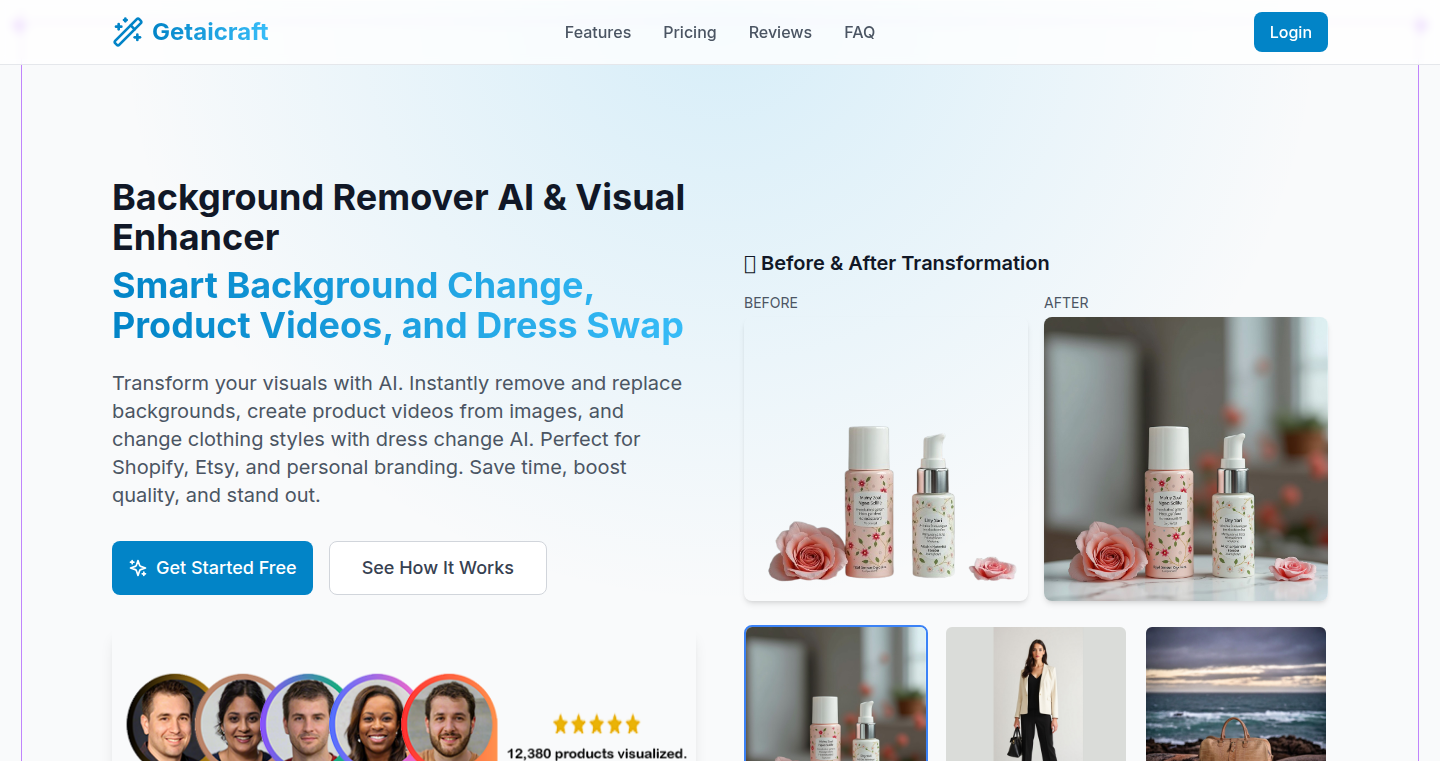
Author
SaaSified
Description
Getaicraft is a tool leveraging Artificial Intelligence to create professional product photos and videos for eCommerce businesses. It allows users to upload a single product image and generate studio-quality visuals, including AI-generated backgrounds and showcase videos. The core innovation lies in automating the time-consuming and costly process of product photography and video creation, directly benefiting online sellers on platforms like Etsy and Shopify. So this means I can skip the expensive photographer and create my product visuals quickly and easily!
Popularity
Points 1
Comments 0
What is this product?
Getaicraft uses a combination of computer vision and generative AI. After uploading an image, the system analyzes the product and then uses AI models to generate various backgrounds or to create a video showcasing the product. This reduces the need for professional photographers or complex editing software. This saves time and money for anyone selling products online. So, I can instantly get professional-looking visuals for my products.
How to use it?
Developers can use Getaicraft by integrating it into their eCommerce workflow. The tool provides an API (Application Programming Interface), meaning you can potentially automate the process of visual creation within your own platform or integrate it into existing product management systems. This allows for streamlined visual updates, enabling developers to offer their users a seamless experience. So, I can integrate this into my existing system and have a fully automated product visuals generator.
Product Core Function
· AI-powered Background Generation: Generates diverse backgrounds for product images, offering a wide range of visual styles and settings. This feature allows you to showcase your product in different environments, making it appealing to a wider audience. So this means I can show my product in different scenarios easily and increase my sales.
· Video Showcase Generation: Creates short product videos showcasing the product from multiple angles. This offers a dynamic and engaging way to highlight the product's features, improving customer engagement and conversions. So, I can easily get a video for my product and impress my customers.
· Automated Image Processing: Automatically optimizes product images for different eCommerce platforms. This saves time and effort, ensuring product visuals meet the specific requirements of each platform. So, my images always meet the requirements of different platforms, which saves me time and frustration.
· Batch Image Processing: Ability to generate visuals for multiple products simultaneously, streamlining the visual content creation workflow. This is a huge time saver when managing a large inventory of products. So, I can generate product visuals for all my products at once and save a lot of time.
Product Usage Case
· Etsy sellers can use Getaicraft to create visually appealing product listings with studio-quality images, leading to increased click-through rates and sales. They can save time and money on professional photography.
· Shopify store owners can leverage Getaicraft to create dynamic product videos for their website, enhancing customer engagement and showcasing product features in an attractive way. They can easily create marketing materials without hiring a video production team.
· Developers building eCommerce platforms can integrate Getaicraft's API to offer their users automated product image and video generation services, providing a valuable tool that helps improve sales. It allows them to provide a powerful feature to their users and gain a competitive edge.
· Marketing teams can use Getaicraft to quickly produce product visuals for social media campaigns and promotional materials, ensuring a consistent and professional brand image. This ensures that they can quickly create and update their marketing materials.
56
Rate Reddit: Sentiment Score Analyzer

Author
rodgetech
Description
Rate Reddit analyzes the sentiment of Reddit comments, giving users a score representing the emotional tone of the discussion. It uses Natural Language Processing (NLP) to determine if a comment is positive, negative, or neutral. The project aims to help users quickly gauge the overall mood of a thread and avoid potentially negative interactions. It addresses the problem of information overload and the difficulty of quickly understanding the sentiment of online discussions.
Popularity
Points 1
Comments 0
What is this product?
Rate Reddit uses NLP, a branch of artificial intelligence, to understand the meaning of text. It analyzes Reddit comments and assigns a sentiment score, which shows the overall feeling of the comment (positive, negative, or neutral). The core innovation is the application of sentiment analysis to Reddit threads, offering users a quick way to understand the emotional tone of a discussion, powered by a custom-built sentiment analysis model or leveraging pre-trained models. So this helps you quickly understand if a discussion is generally happy, sad, or neutral.
How to use it?
Developers can use Rate Reddit by integrating it into their own Reddit applications or browser extensions. They can fetch comments from Reddit, send them to the Rate Reddit API (if one is available), and receive a sentiment score for each comment. This score can then be displayed to the user, helping them to understand the emotional tone of a discussion. So, as a developer, you can easily add this sentiment analysis feature to your existing Reddit tools or build new ones, giving your users a better understanding of the conversations.
Product Core Function
· Sentiment Scoring: Analyzes individual Reddit comments to determine the sentiment (positive, negative, neutral). This is useful for quickly understanding the emotional tone of each comment. For example, building a feature to highlight potentially negative comments, and helping users to spot potentially heated or aggressive posts.
· Thread Sentiment Aggregation: Provides an overall sentiment score for an entire Reddit thread, giving users a quick overview of the discussion's mood. This is great for getting a quick sense of a thread’s overall tone. So you can decide if a discussion is generally positive, negative, or neutral before engaging.
· Real-time Analysis: Allows for real-time sentiment analysis of Reddit comments as they are posted. This is useful for monitoring discussions and identifying potentially problematic comments early on. This allows users to get immediate feedback on their comments and can proactively address issues.
· Customization and Configuration: Offers the ability to adjust the sentiment analysis parameters or customize the underlying model. Useful for tailoring the analysis to specific subreddits or topics. For instance, if the project allows configuration of sensitivity to different language or topic specific nuances.
Product Usage Case
· Social Media Monitoring: A company wants to monitor the sentiment of their product mentions on Reddit. Rate Reddit can be used to automatically analyze comments about their product, identifying positive and negative feedback. So the company gets immediate feedback on their customer perception.
· Community Moderation: A subreddit moderator wants to automatically identify potentially toxic comments. Rate Reddit can be integrated into a moderation bot to flag comments with a negative sentiment score for review. This improves community moderation by identifying potentially problematic posts.
· Personal Use: A user wants to understand the tone of a discussion before participating. Rate Reddit can be used as a browser extension to display the sentiment score next to each comment, helping them decide if they want to engage. So this helps users to avoid potentially negative interactions by understanding the comment sentiment before they read it.
57
Enhanced DCA Trading Bot (Technical Indicator Based)
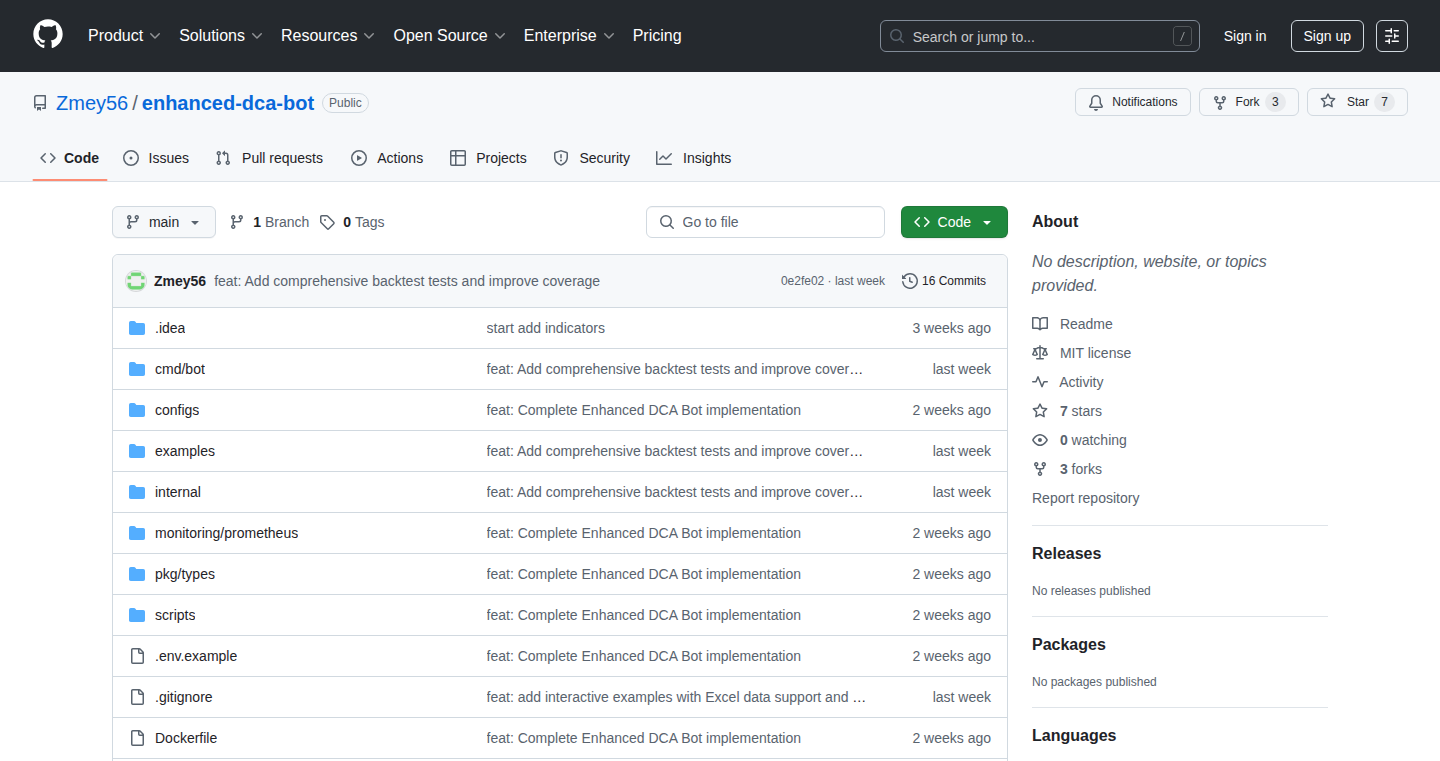
Author
Zmey56
Description
This project introduces an enhanced Dollar-Cost Averaging (DCA) bot that utilizes technical indicators like RSI, SMA, and Bollinger Bands to make buying decisions, rather than relying solely on time-based intervals. The core innovation is the use of these indicators to dynamically adjust buying behavior, aiming to purchase assets when the market signals a favorable entry point. Backtesting results over three years indicate a 24% annual return compared to a 12% return with the traditional DCA strategy, along with reduced drawdowns. The bot is containerized with Docker and includes a built-in backtesting engine and Prometheus monitoring. So this is useful because it could lead to significantly higher returns with lower risk compared to standard DCA strategies, making it more efficient and potentially more profitable.
Popularity
Points 1
Comments 0
What is this product?
This is a trading bot implemented in Go that leverages technical analysis for DCA. Instead of buying at fixed time intervals, it monitors market conditions using indicators like Relative Strength Index (RSI), Simple Moving Average (SMA), and Bollinger Bands to determine when to buy. The innovative part is the dynamic buying based on these signals. The bot is built using Docker for easy deployment and includes a full backtesting suite to simulate performance under different market conditions, along with Prometheus for monitoring. So, it uses clever market analysis to try and buy at better prices than just blindly buying every week or month.
How to use it?
Developers can use this bot by deploying it within a Docker environment. They can customize the technical indicators and their parameters to fit their own trading strategies. They can also integrate it with existing trading platforms via API access. The backtesting engine allows developers to test their strategies against historical data. The monitoring via Prometheus helps track performance. So, you would customize it, deploy it, and then let it make smart trading decisions for you.
Product Core Function
· Technical Indicator-Based Buying Logic: The bot uses indicators like RSI, SMA, and Bollinger Bands to identify potential buying opportunities. This means it buys when the market seems undervalued based on these technical analysis tools. So, this lets the bot make smarter buying decisions, potentially leading to better returns.
· Signal Aggregation: The bot aggregates signals from different technical indicators to make more informed decisions, rather than relying on a single indicator. This helps to reduce false signals and improve the accuracy of buying decisions. So, it's like getting a second opinion from multiple experts before making a big decision.
· Docker Deployment: The bot is packaged in a Docker container, which simplifies deployment and ensures consistent behavior across different environments. This makes it easy to run the bot on any platform that supports Docker. So, you can easily run the bot without needing to set up a complicated development environment.
· Backtesting Engine: The included backtesting engine allows users to test different trading strategies against historical data. This helps users to understand the bot’s performance and optimize the parameters before deploying it in a live environment. So, you can see how the bot would have performed in the past before putting any real money at risk.
· Prometheus Monitoring: The bot is integrated with Prometheus for monitoring key performance metrics. This allows users to track the bot’s performance in real-time and quickly identify and address any issues. So, you can keep a close eye on how the bot is performing, and make adjustments if needed.
Product Usage Case
· Automated Cryptocurrency Trading: A trader can use this bot to automatically buy and sell cryptocurrencies based on market analysis, eliminating the need for manual trading. The technical indicators help to identify optimal entry and exit points, potentially increasing profits. So, you can have a bot making smart trading decisions for you, 24/7.
· Portfolio Diversification: Investors can use the bot to diversify their portfolios by automatically investing in different assets based on the bot’s signals. The use of technical indicators can help identify assets with the potential for growth. So, this helps you spread your investments and potentially lower your risk.
· Performance Analysis: Finance professionals can use the backtesting engine to evaluate various trading strategies and optimize their performance. The bot's monitoring capabilities allow for the real-time analysis of trades and strategies. So, you can use the project to see how different strategies work and refine your trading approach.